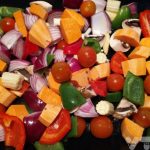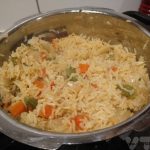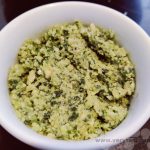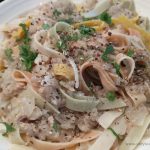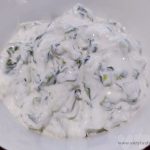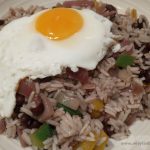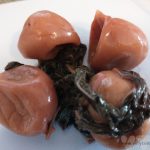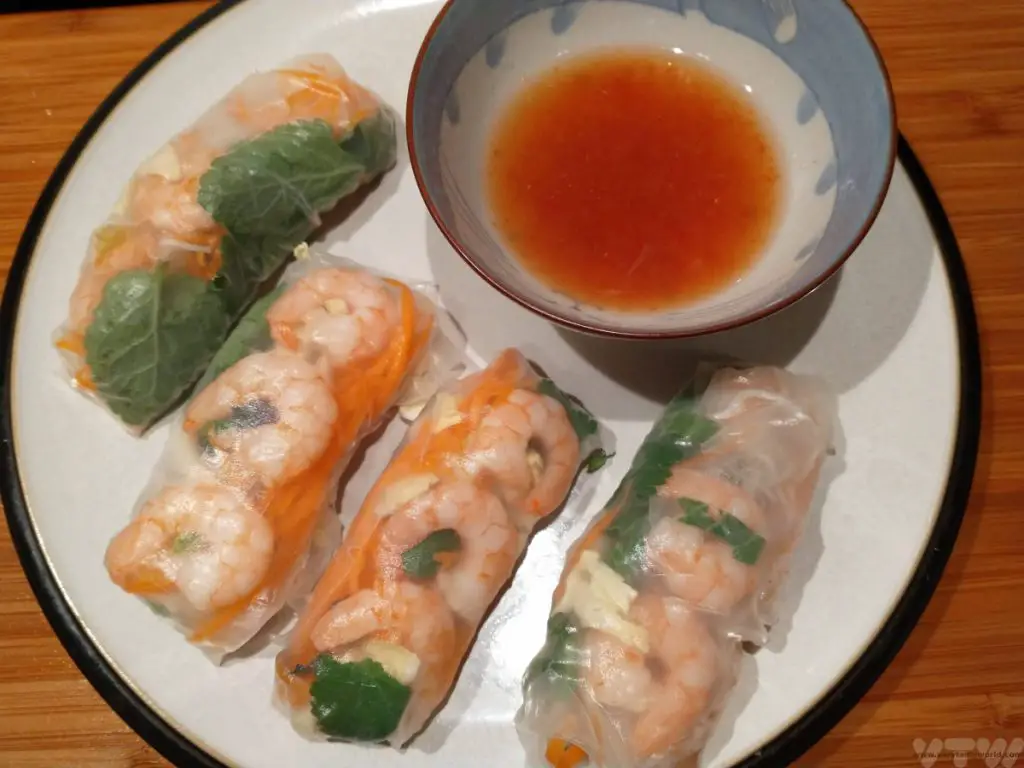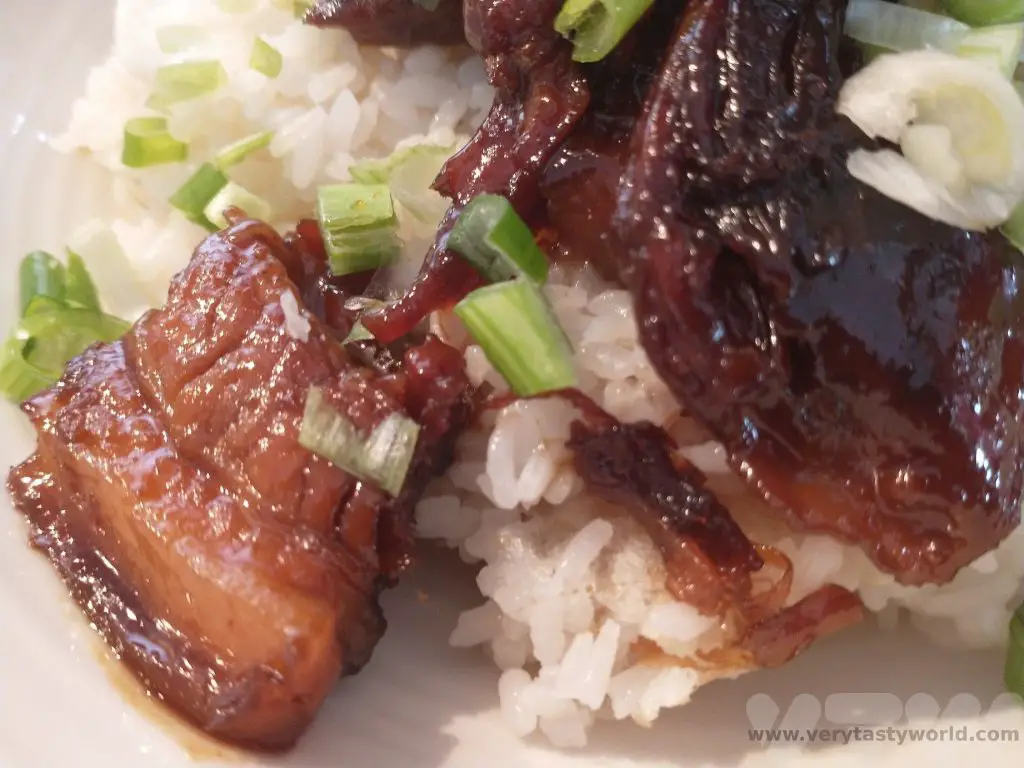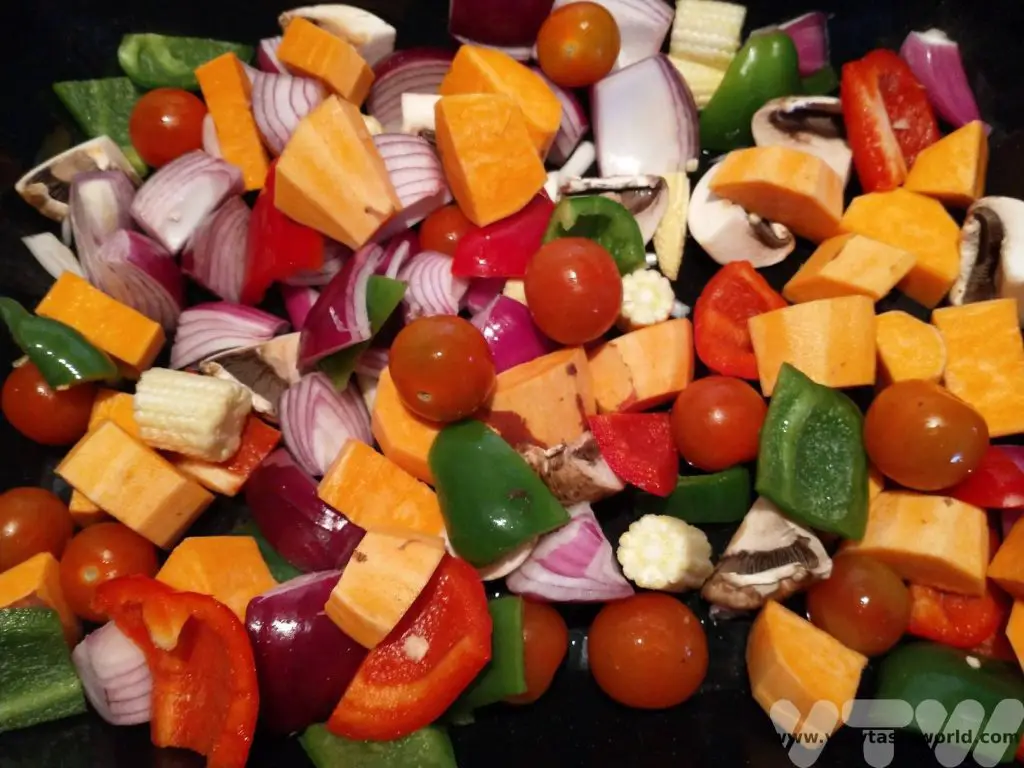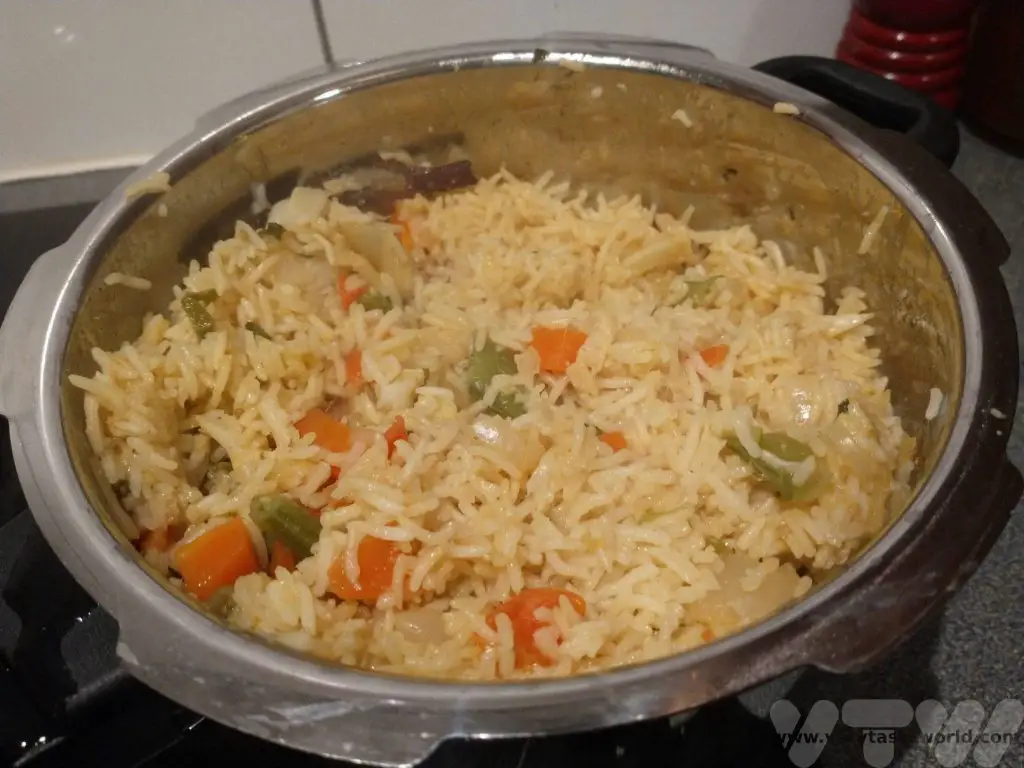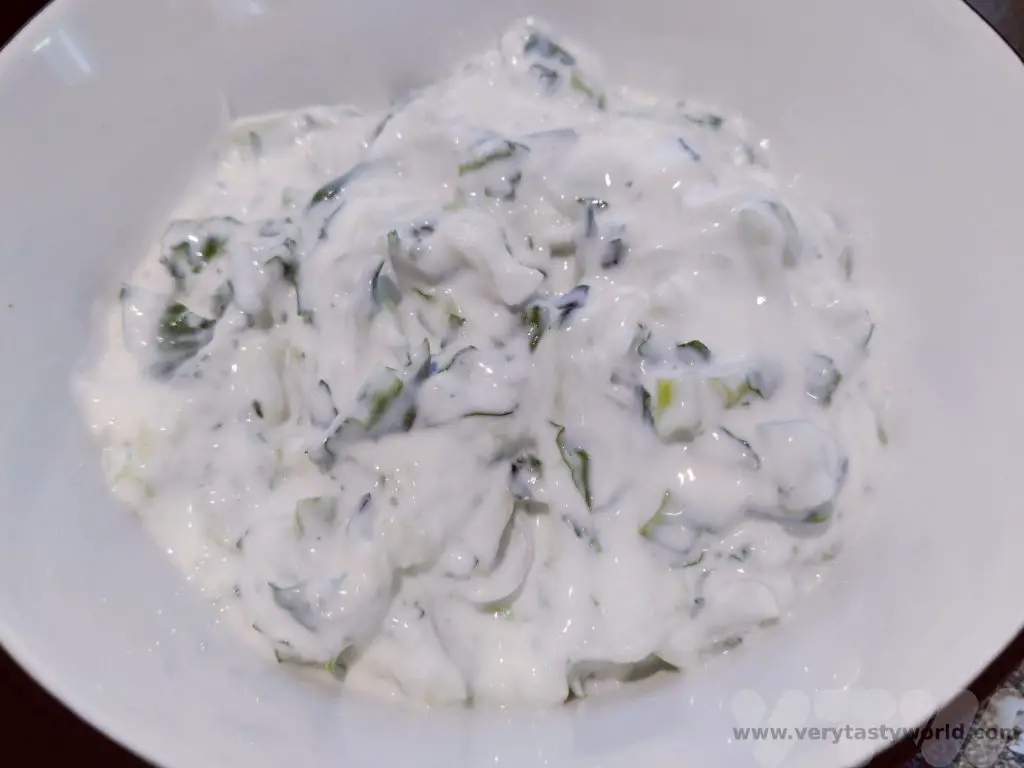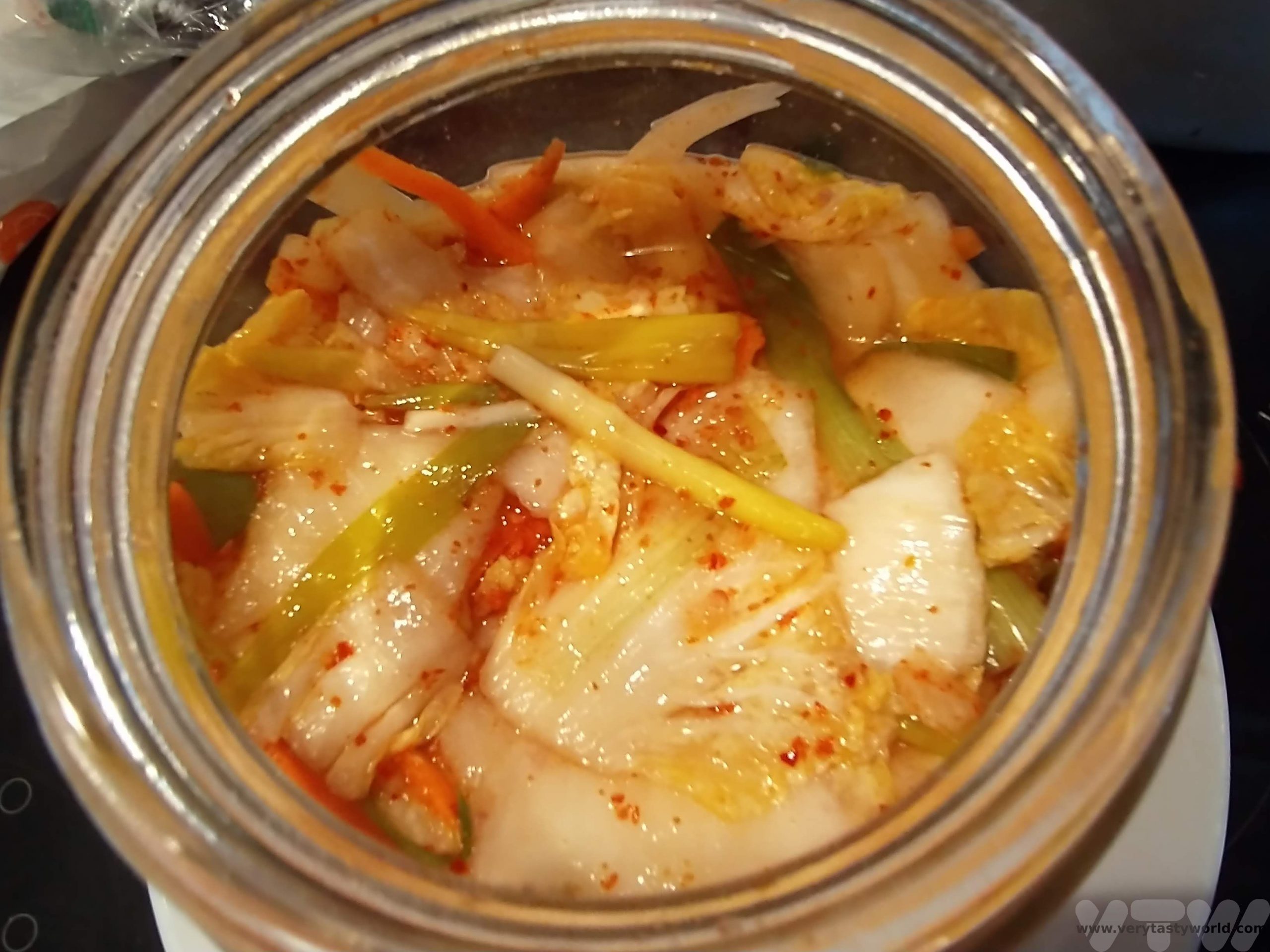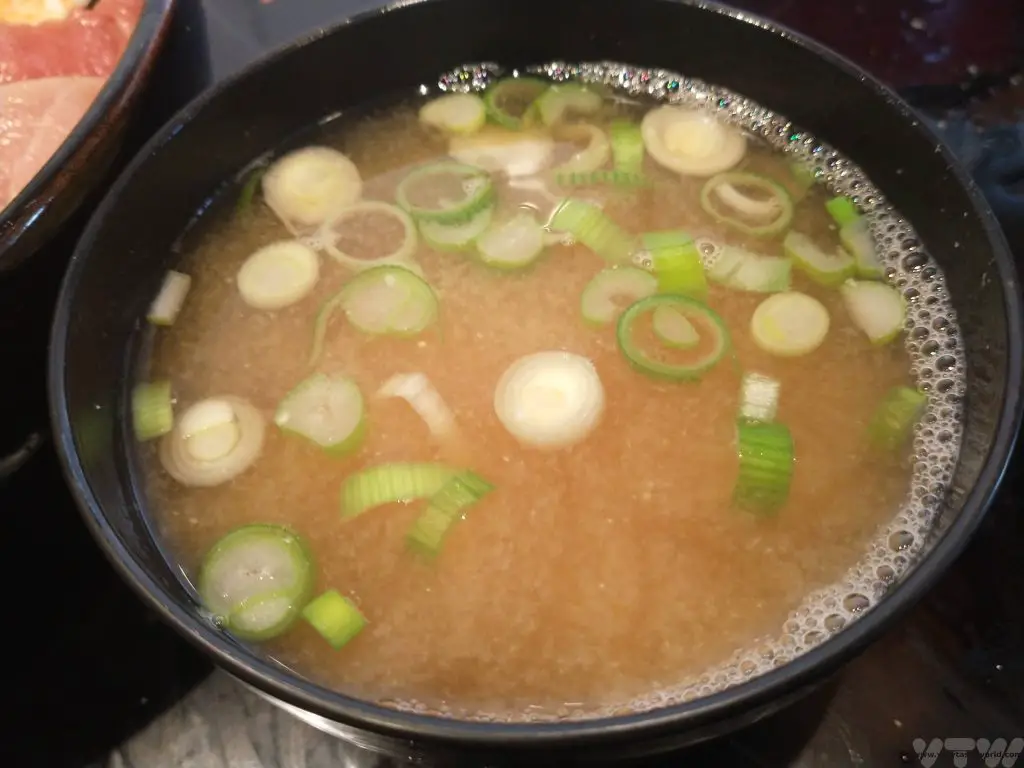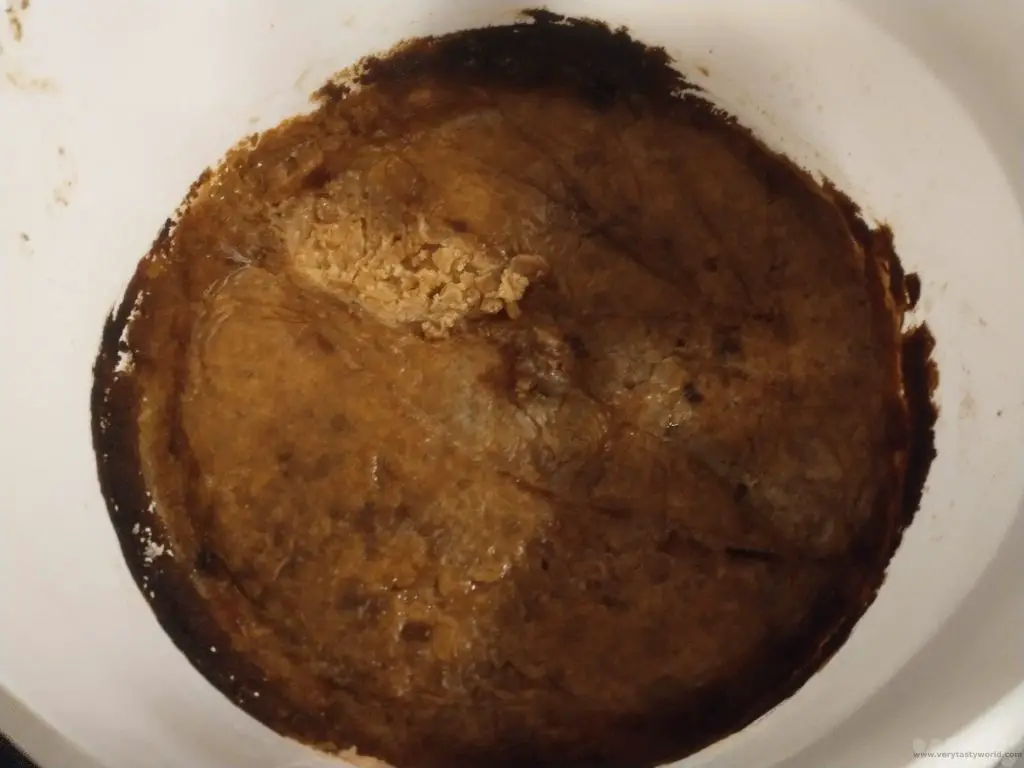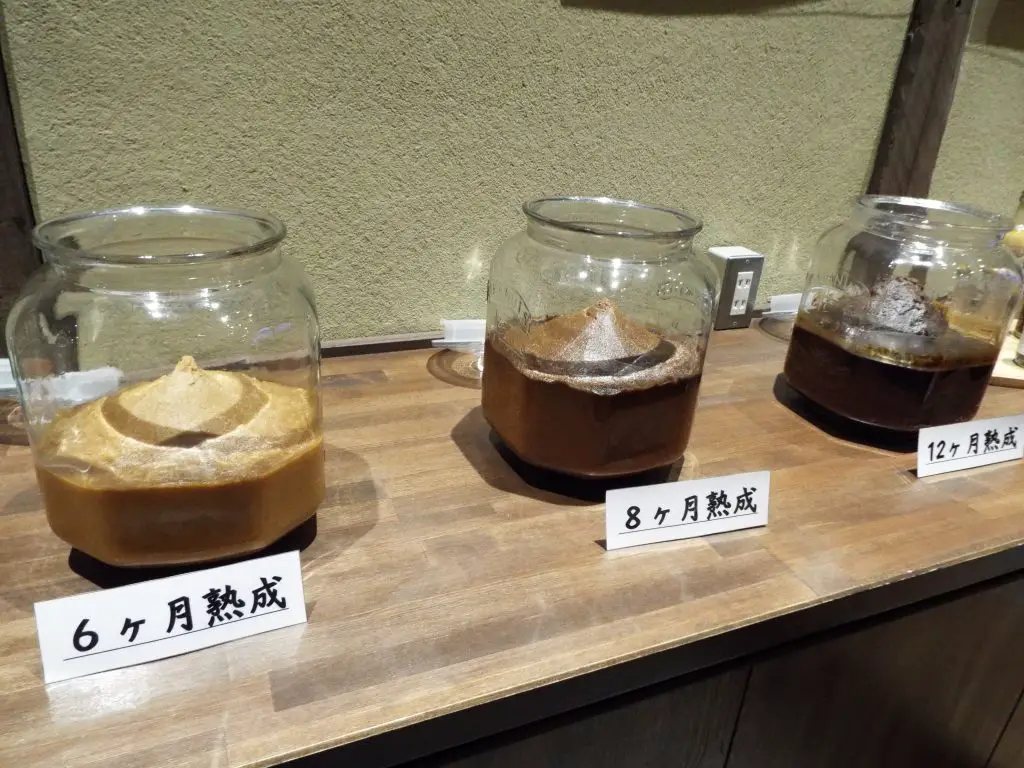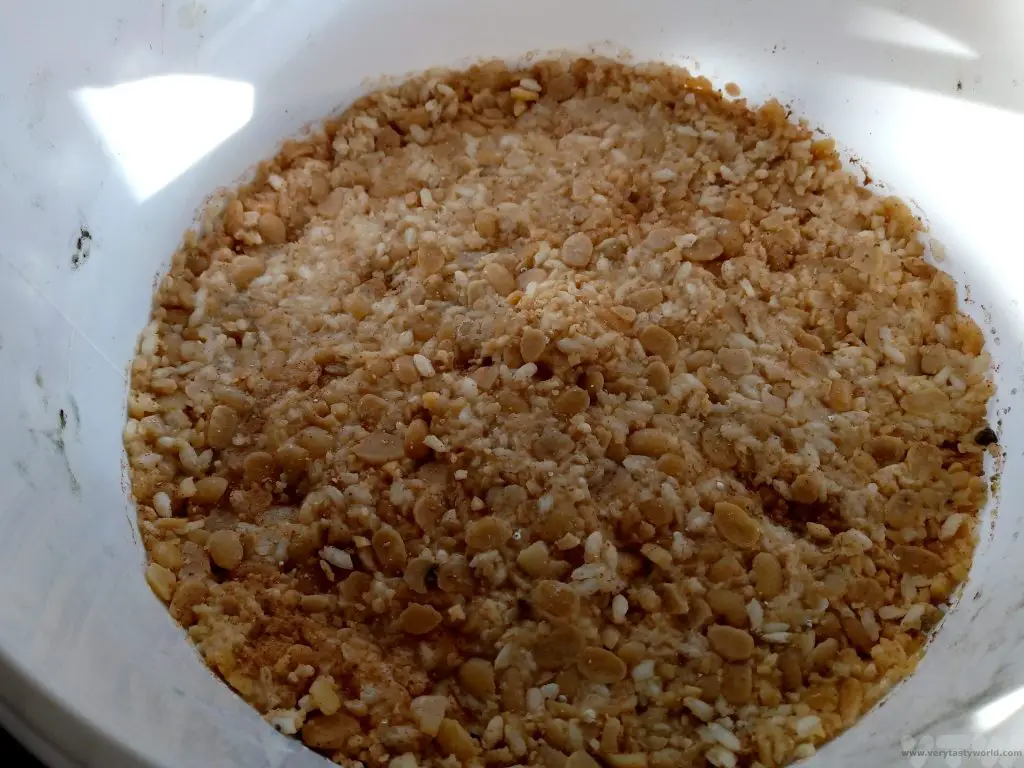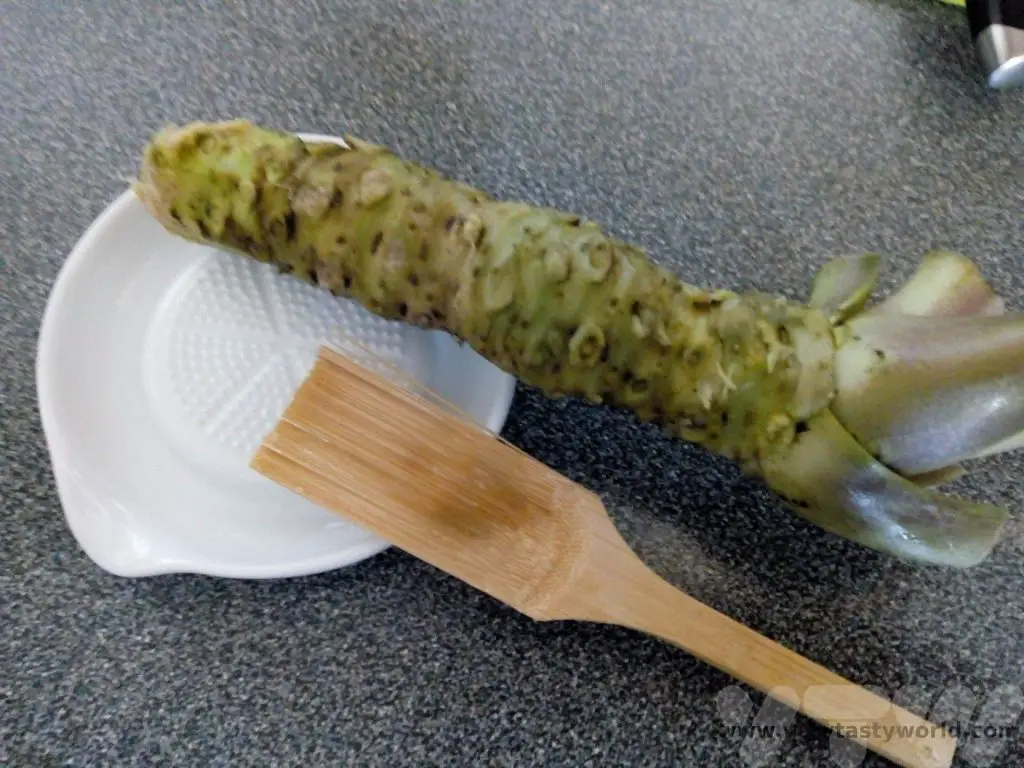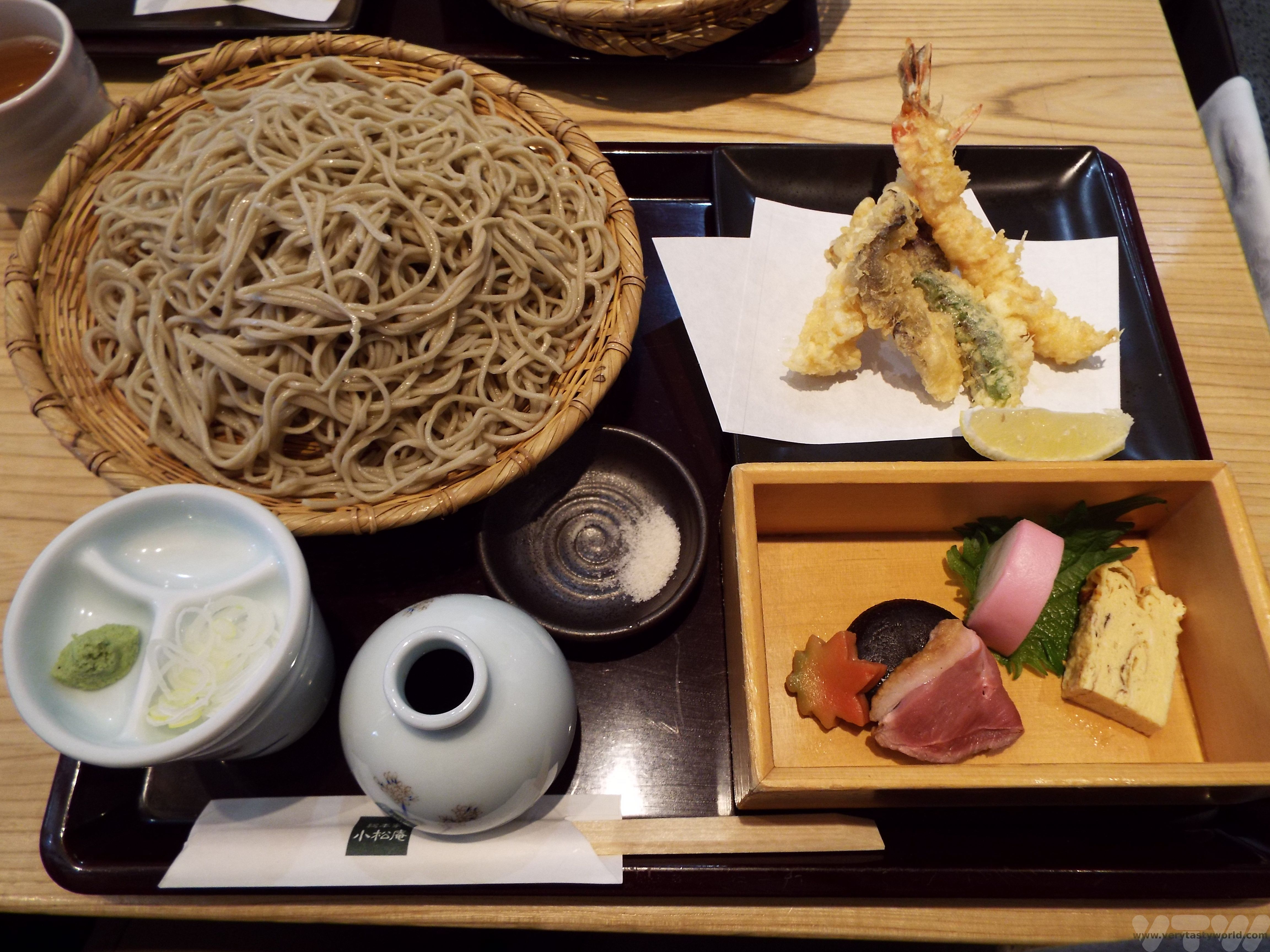Home » Posts tagged 'recipe' (Page 2)
Tag Archives: recipe
RECIPE: How To Make Kimchi
Kimchi is a fundamental part of society in Korea. It is Korea’s national dish and is usually eaten with most meals there. In fact, kimchi making has been assigned as a UNESCO cultural heritage and even has its own day – 22nd November. Kimchi is great fun to make and we have a recipe for how to make kimchi. It isn’t a traditional Korean style but it’s easy to make, is ready very quickly and we reckon it’s much more delicious than shop-bought.
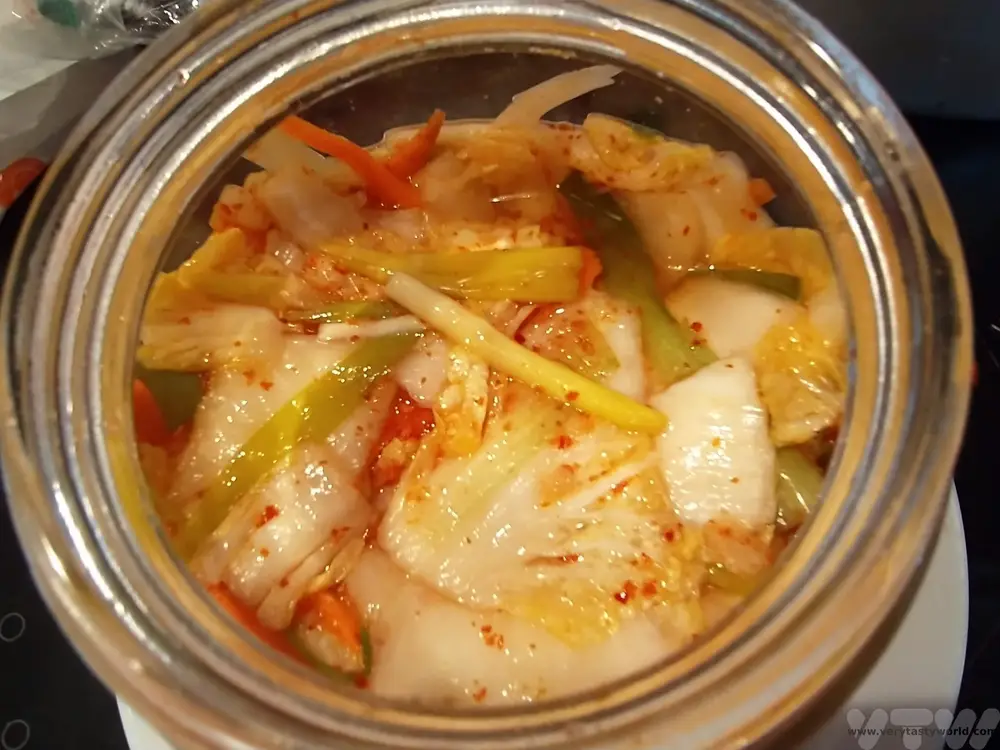
We first tried kimchi over 20 years ago and it was love at first bite – sour, spicy and crunchy, it has a unique flavour. Being a fermented food it is also purported to have properties that are beneficial for your gut health but, far more importantly, it’s delicious.
It’s surprisingly easy to make but it does take a while to ferment and you do have to watch out for potential explosions but that is what makes it so exciting! (Don’t worry, we’ve been making it for years and have never had an explosion – we have some advice on the best equipment to use at the end of this post.) We have tried fermenting lots different foods over the years, including miso, and it’s a very satisfactory process.
Kimchi is made via a lacto fermentation process whereby good bacteria, known as lactic acid bacteria, convert the sugars in vegetables into lactic acid. The joy of fermentation is that it isn’t a precise art. You need a bit of patience while the bacteria do their thing but once fermentation is complete, the finished product will last for many months, if not years – that is, if you don’t eat it straight away!
Ingredients For Making Kimchi
1 Chinese leaf cabbage (also known as Napa cabbage)
1 carrot
2 spring onions (green onions)
A carrot’s length of daikon white radish, also known as mooli (optional)
2 fat cloves of garlic (3 if your garlic isn’t portly enough)
1 tbs fish sauce (vegetarians can use soy sauce, but use less – 1/2 tbs)
1 thumb-sized piece of ginger
1 tbs Korean chilli red pepper powder known as Gochugaru (you should be able to find this in Asian stores and even supermarkets these days). A variation is to use Korean chilli paste, known as Gochujang. Gochujang is traditional but we prefer the chilli powder for this kimchi.
3 tbs salt. You want to use a salt that doesn’t have anti-caking additives. Table salt isn’t recommended. Equally you don’t really want to use really posh salt. We tend to use Himalayan pink salt.
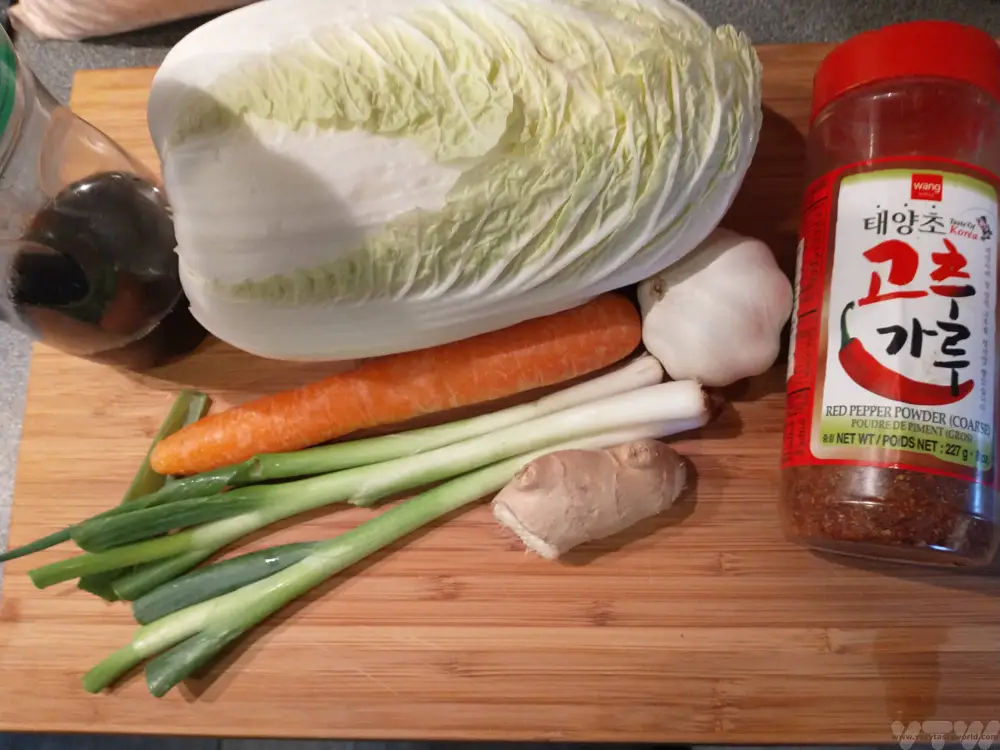
How To Make Kimchi: Method
Slice the cabbage into chunks. You want to have easily pick-upable bite-sized pieces. One of the nice things about the Chinese leaf is that it has a lovely broad ribs which retain their crunch when the kimchi is finished which makes a nice contrast with the softer leaves.
Place cabbage into a bowl and sprinkle with the salt. Massage the salt into the cabbage and wait a couple of hours. It is a lot of salt but you will be washing it through later.
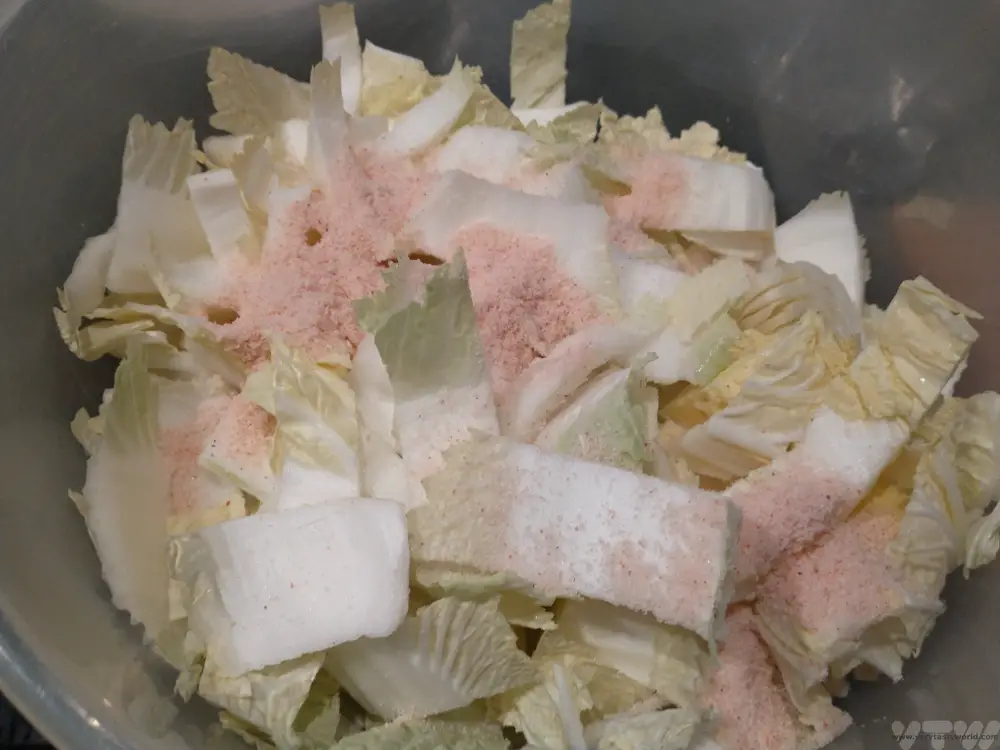
Prepare your fermentation jar. The size of the jar is important. You want to fill the jar up as much as possible and not have too much headspace. The jar size that suited our cabbage was 1.4 litre capacity. We recommend clip top Kilner jars as they have a good seal to keep air out but also let the liquid escape. There are some types of jar specifically designed for fermentation. We’ve had greater success with some than others.
The jar needs to be clean. We find the best way to clean the jar is to wash it in warm, soapy water and rinse. Then we boil a kettle and fill the jar (not forgetting the lid) with boiling water. After 10 minutes, drain and let the jar cool down. Some people put the jar into the oven on a low heat for 20 minutes but we haven’t found this step to be necessary for this type of fermentation.
After some time has passed, give the cabbage a quick rinse with water. Have a taste – it should taste salty but not overpoweringly salty. You don’t need to pat the cabbage dry.
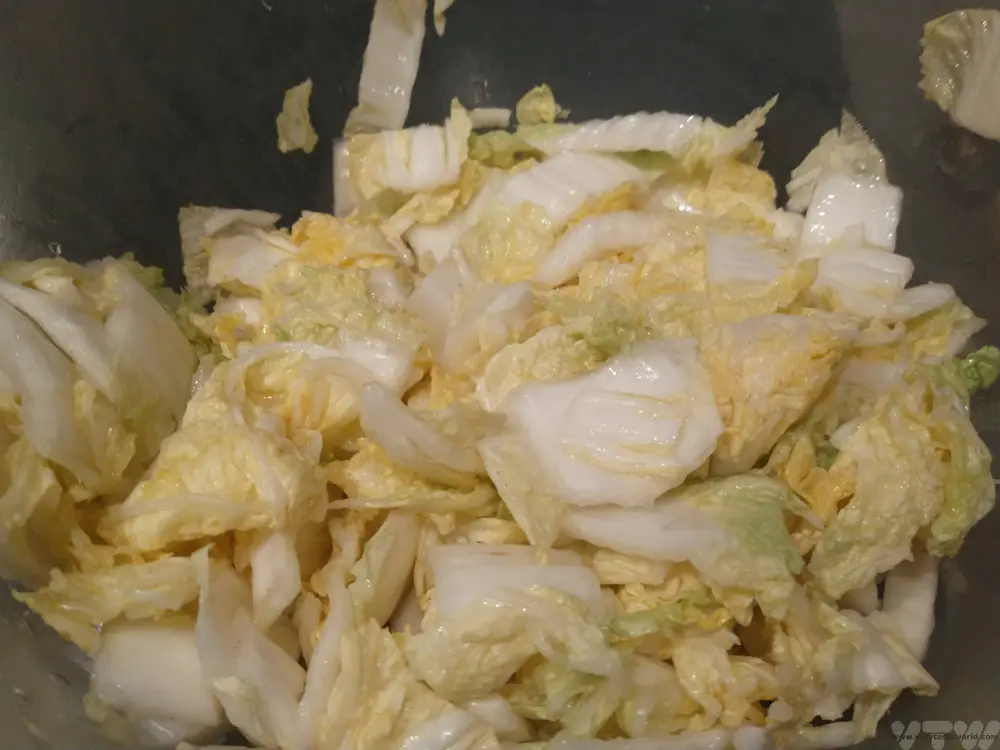
Julienne the carrot and daikon, if you are using it, slice the spring onions lengthways.
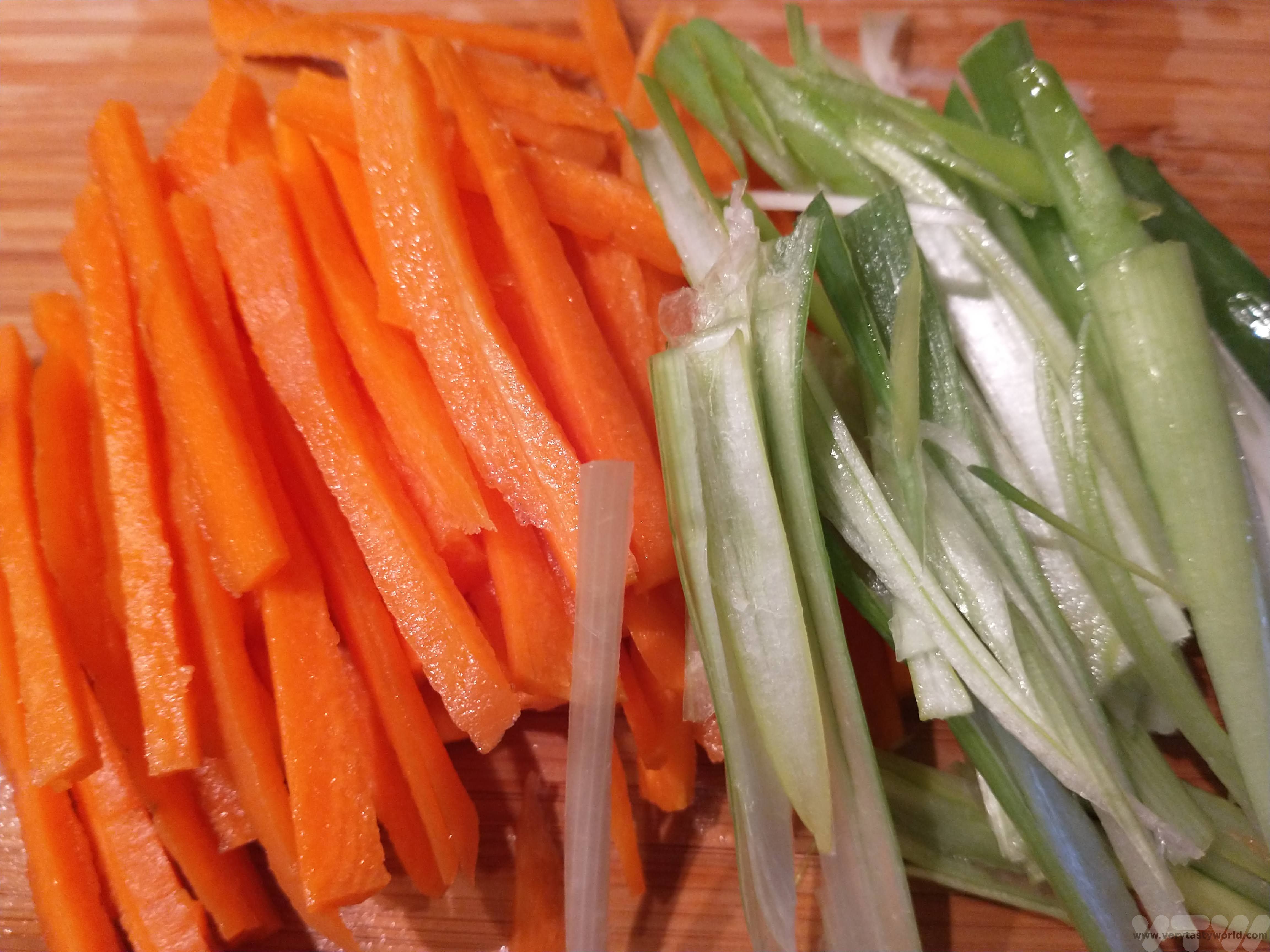
Put the garlic, ginger and fish sauce into a pestle and mortar and grind them together to create a paste. It will have quite a liquid consistency.
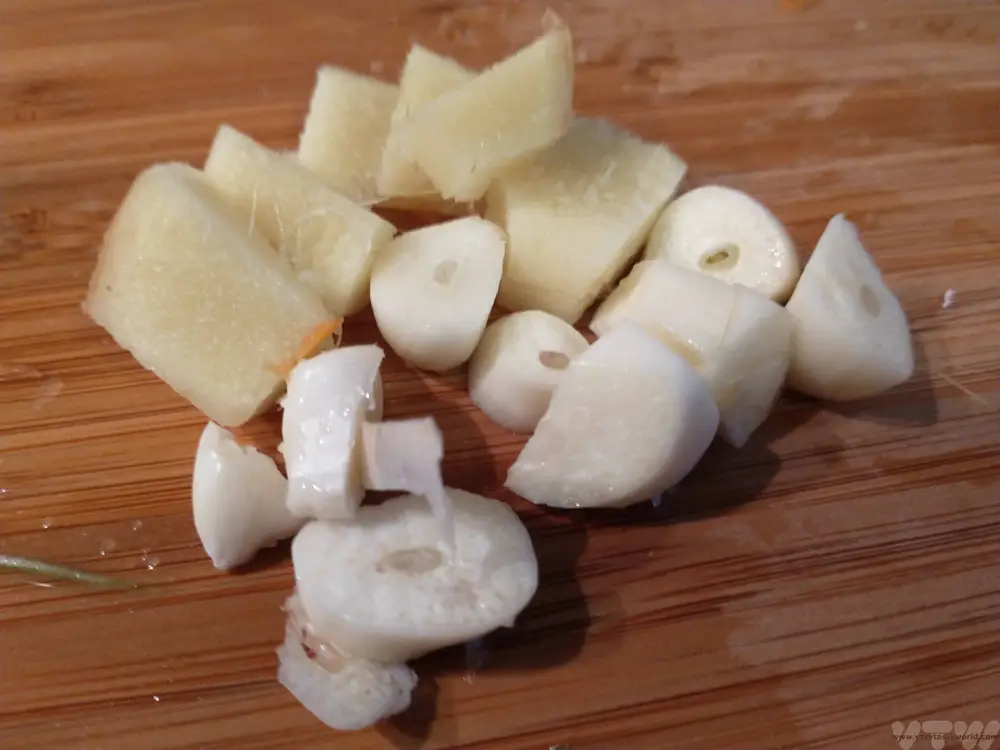
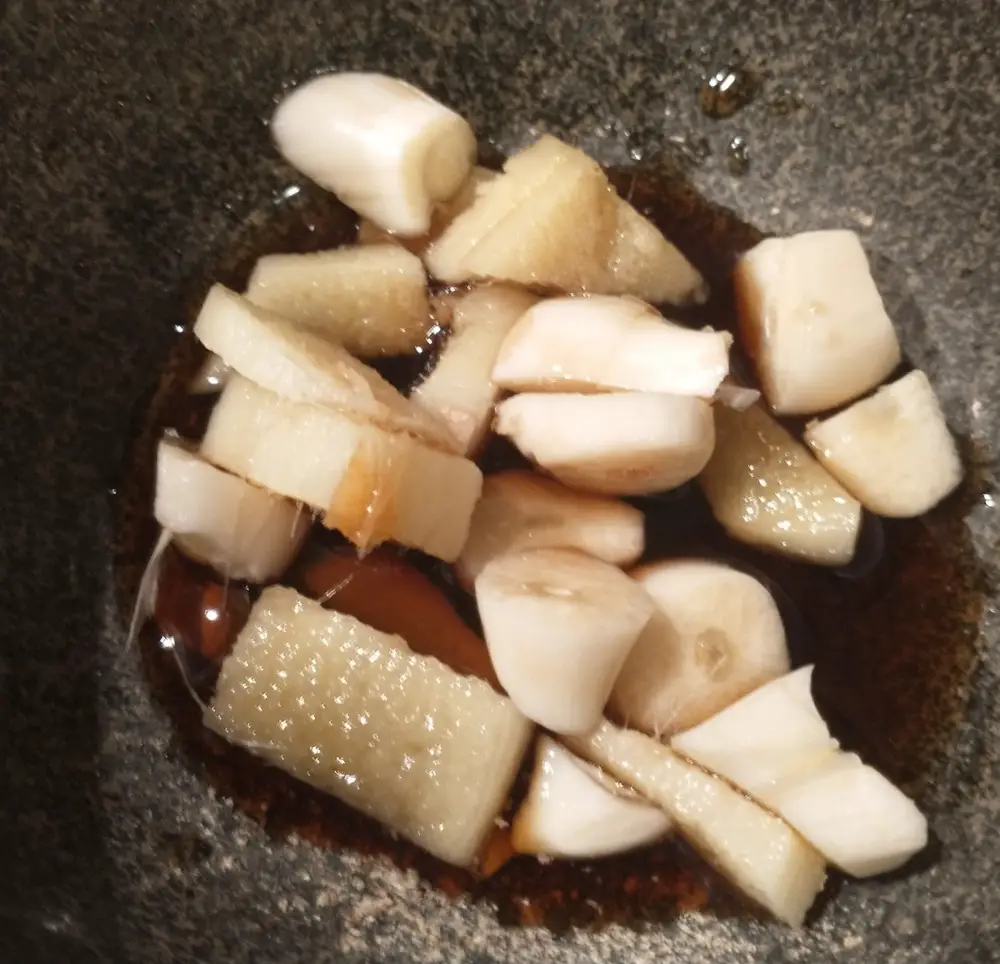
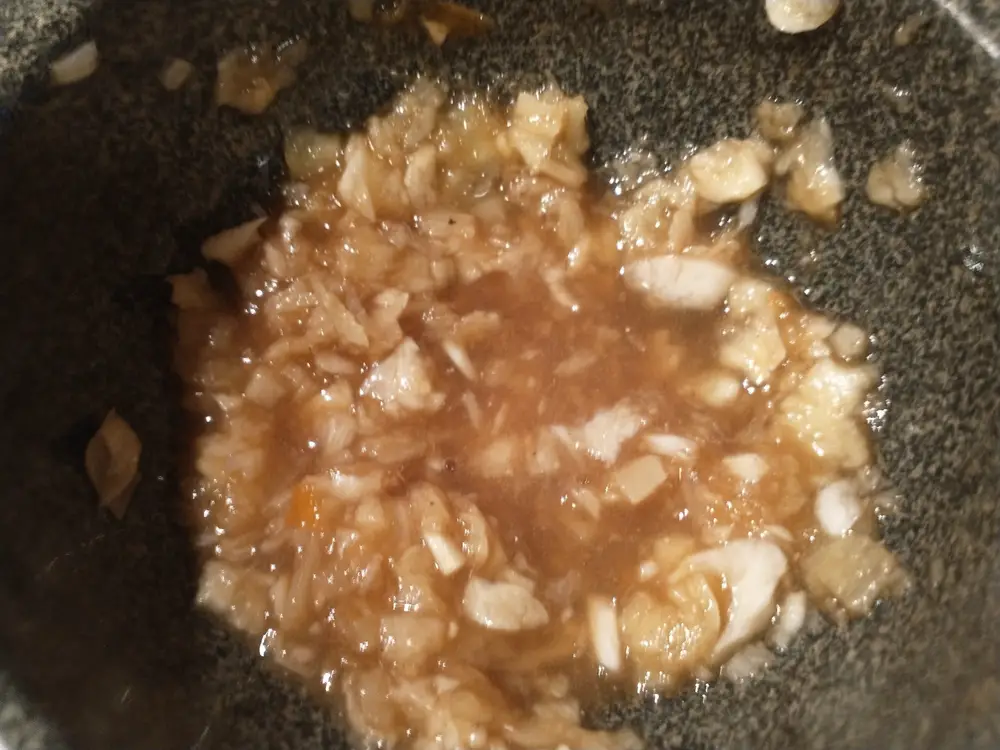
Add the vegetables to the cabbage.
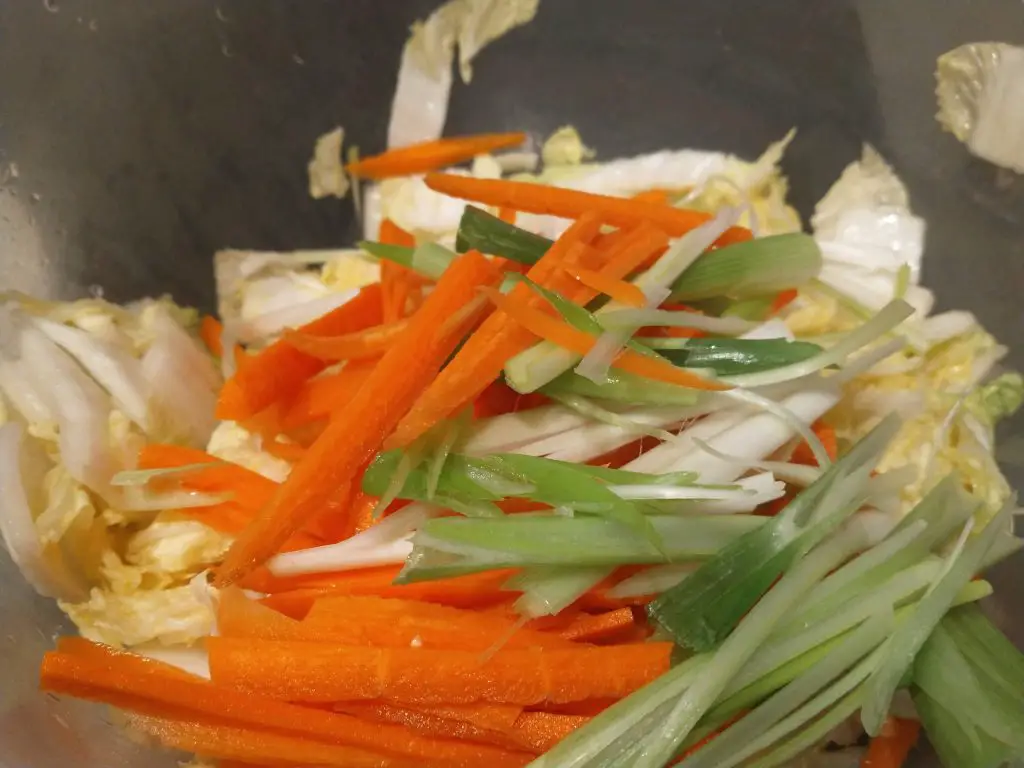
Pour over the garlic-ginger-fish sauce paste and sprinkle the chilli powder over the cabbage and veg. Mix well. We find it’s easiest to do this with our bare (clean) hands.
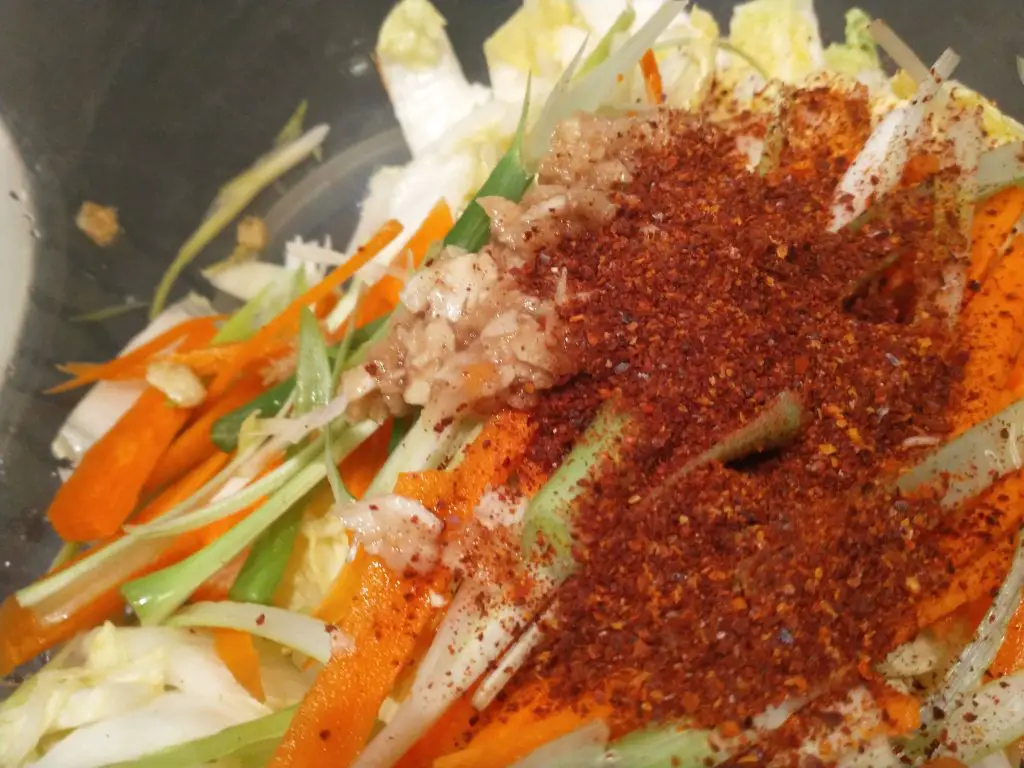
Then you need to pack the jar. Pick up handfuls of the cabbage mix and place into the jar, pushing down to squish it in – really pressing hard to make sure there aren’t any air gaps.
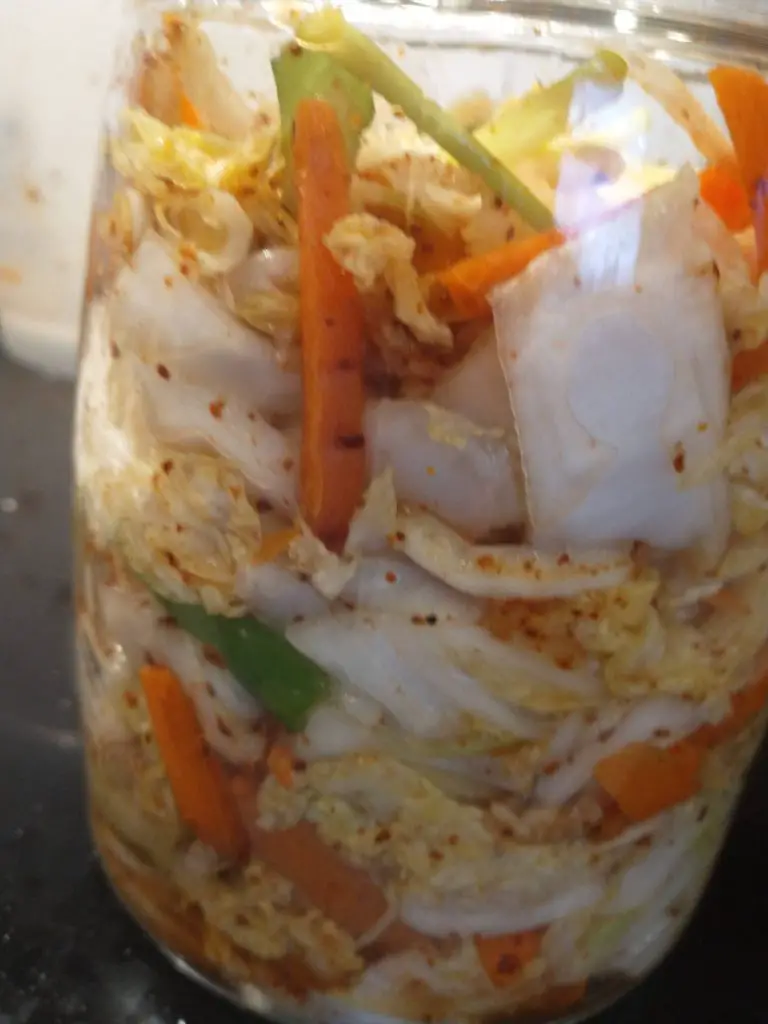
You should try and aim for minimum headroom at the top of the jar to reduce the air space. You also want to make sure the cabbage mixture remains pressed down. You can get all sorts of weights but a glass dessert ramekin type container (e.g. Gu) works well or, cheaper and less calorific than eating a chocolate dessert, fill a small plastic bag with water, tie at the end and squish into the top of the jar.
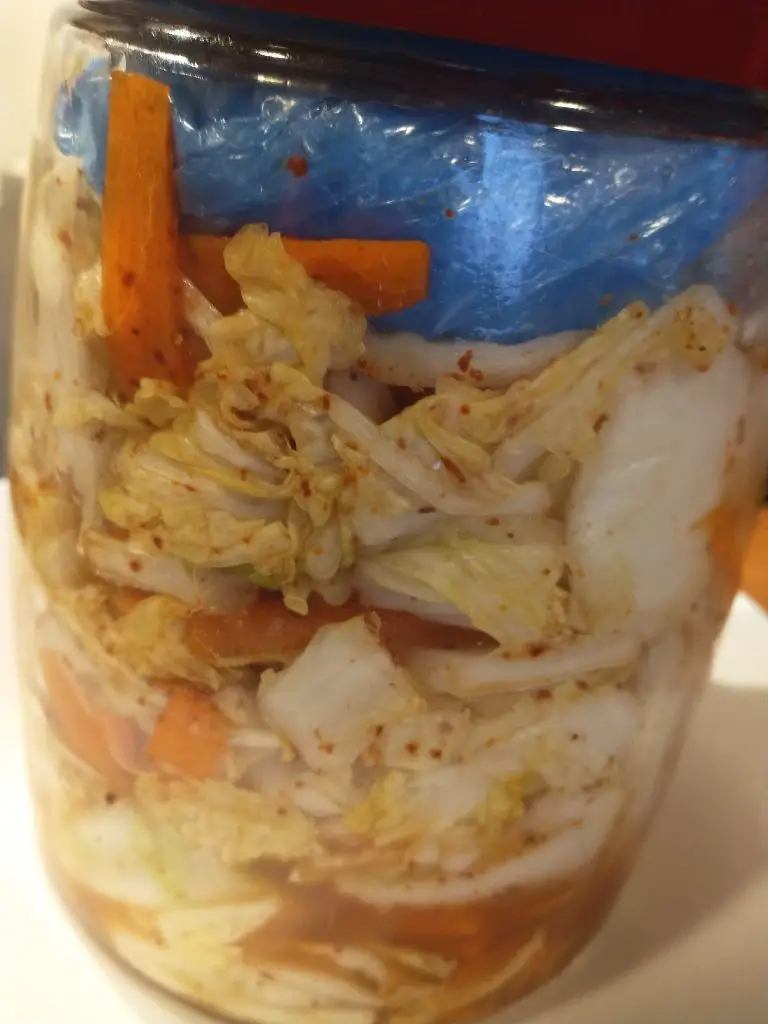
Close the jar and place the jar on a deep plate or in a bowl to catch any liquid escaping.
Check The Ferment Over Several Days
Over the next few days the cabbage will begin to ferment. The time it takes will depend on how warm the ambient temperature is. You’ll see a liquid start to form in the jar and cover the cabbage and the lactic acid bacteria will start to form lactic acid and C02. It is because of the C02 that you need to keep an eye on your ferment. If you are using a specific fermentation jar you should be fine. If you are using a conventional jar you will need to ‘burp’ your ferment, at least once a day. Open the lid – very briefly – and close immediately, just to let the C02 out. This will ensure that the pressure doesn’t build up. If you don’t burp there is a risk of the jar exploding. We’ve never had a glass jar break but there have been numerous occasions when I’ve burped the jar and ended up with a brine shower!
The kimchi should be ready within a week to 10 days. You can leave it longer if you wish and this will ensure further development of the flavours.

When the kimchi is ready you can store the jar in the fridge or decant it into smaller jars (just go through the process of cleaning them, then adding boiling water and letting them dry). The kimchi will store in the fridge for months as long as it is airtight.
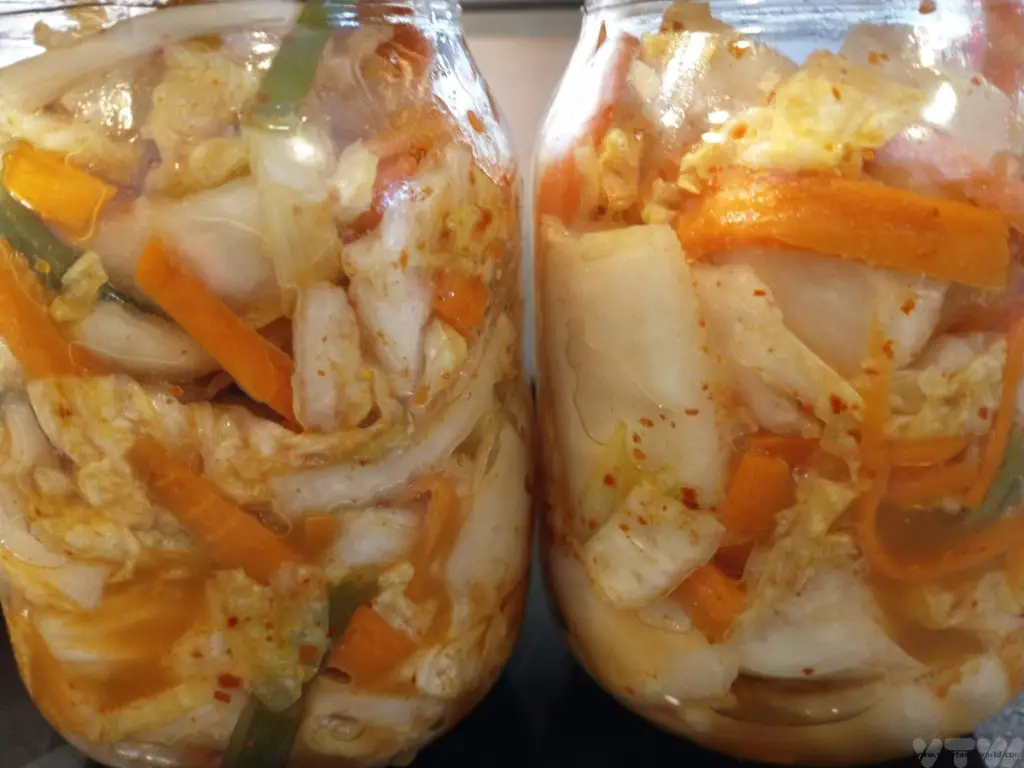
Beware
The two greatest issues with fermenting food is risk of explosion (which can be reduced/eliminated if you use the right equipment) and mould. When the ferment is exposed to air there is the potential for mould to develop. If you open your jar and see fuzzy mould of any colour you should discard the ferment. It’s heart-breaking but the safest thing to do as the mould could make you very ill. (It’s not advisable to scrape off the mouldy bits – by the time the fuzz has appeared the spores will have permeated the whole jar.) Obviously this creates something of a dilemma – you need to open the jar to burp but don’t want to let the air in. So, the key is to open the jar very quickly to release pressure then close immediately. With some types of fermentation jar you don’t need to worry.
Some Notes On Fermentation Equipment
You don’t need too much specialist equipment to ferment food. A kilner jar with a metal clip lid ‘self-burps’ – it allows CO2 to escape whilst not letting air (which can contain mould spores) in. You can get various fermentation vessels in varying sizes.
Salt should not have anti-caking properties.
You can get chilli flakes or gochujang in Asian supermarkets.

- RECIPE Oyakodon Donburi
- Zero Waste Recipes Before Your Holiday
- RECIPE: Vegetable Biryani Tamil Nadu Style
- RECIPE: Vegan Wild Garlic Pesto
- Recipe: Venetian Pasta Sauce
- RECIPE: Biryani Raita Recipe
- RECIPE: How to Make Costa Rica’s Gallo Pinto
- Recipe: Japanese Simmered Pork Belly – Buta no Kakuni
- RECIPE: How to Make Umeboshi
Please note that this post contains affiliate links. If you click the link and decide to make a purchase we will earn a small commission, at no cost to you, which helps towards running this site.
RECIPE: How to Make Vietnamese Spring Rolls
How to make Vietnamese Spring Rolls Summer Rolls
Vietnamese cuisine is amongst the most delicious in the world. It is also amongst the prettiest. We have a Vietnamese spring roll recipe. While most people think of spring rolls as being deep-fried, gỏi cuốn are actually served cold – at room temperature. In Western countries they are referred to as spring rolls, salad rolls or even summer rolls. They have slightly different names depending on the region of Vietnam: they are gỏi cuốn, meaning salad rolls in the south and nem cuốn in the north. Apparently they are called “rice paper” rolls in the central regions of the country, which is a simple description but accurate.
Gỏi cuốn comprise cold vermicelli noodles, salad, protein such as prawns or pork and herbs all wrapped up in rice paper, known as bánh tráng. They are usually served with a dipping sauce. Unlike fried spring rolls, these are really fresh and, like so much of Vietnamese food, full of flavour.
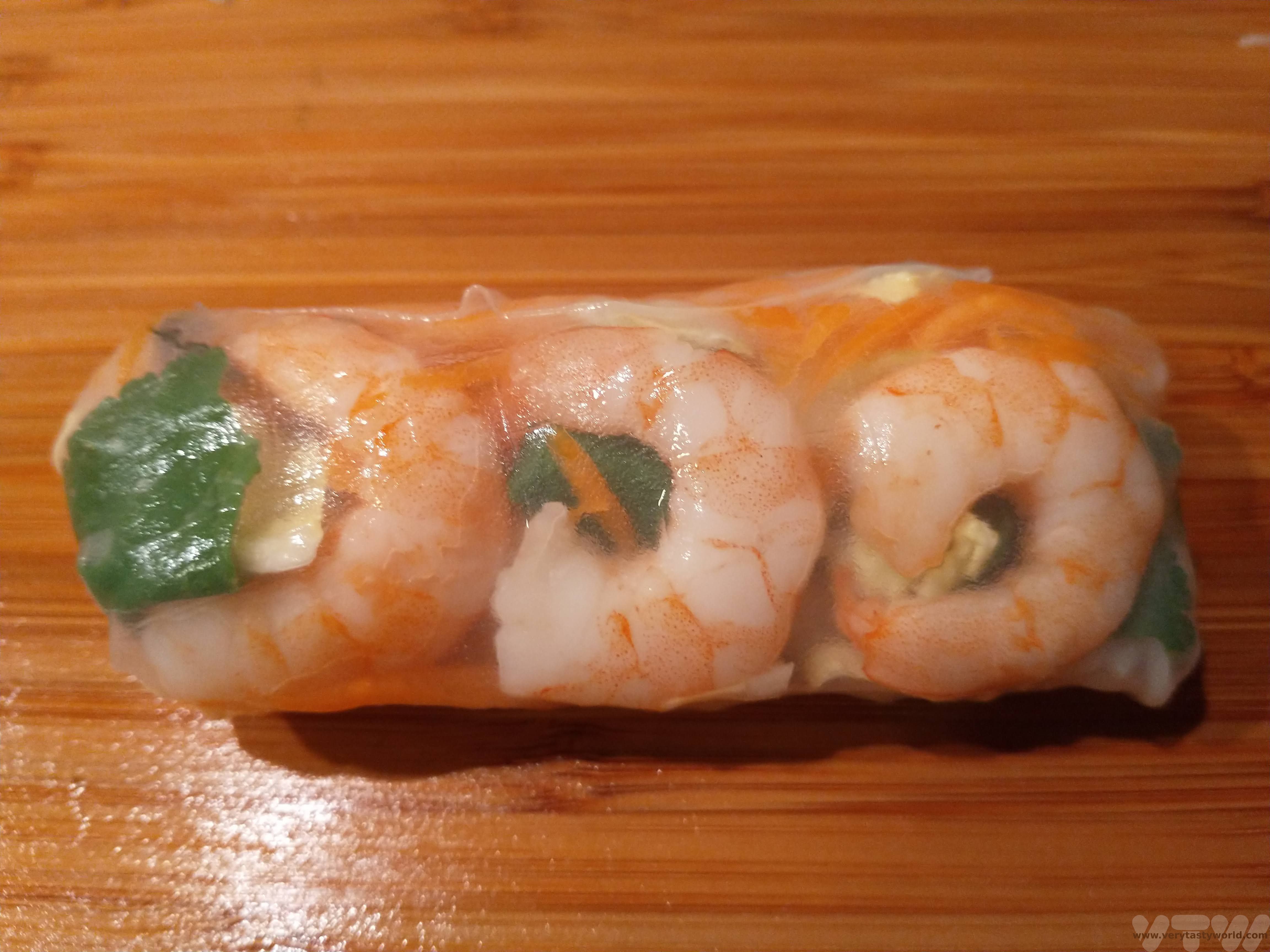
Vietnamese Spring Roll Recipe
- Makes 12 rolls
Ingredients
For the Rolls
Rice paper wrappers (you can get these from Asian supermarkets)
100g vermicelli rice noodles
36 king prawns (3 per roll, or one more each if you are feeling greedy), cooked and peeled.
2 carrots
Shredded lettuce or cabbage
Handful of fresh mint and/or coriander (or a herb of your choice)
For the Dipping Sauce
2 tbs sweet chilli sauce
Juice of ½ a lime
Splash of fish sauce (or soy sauce for vegetarians)
How To Make Vietnamese Spring Rolls Method
Prepare the noodles. Pour boiling water over the vermicelli and leave for 5-7 minutes until they are soft. Drain and allow to cool.
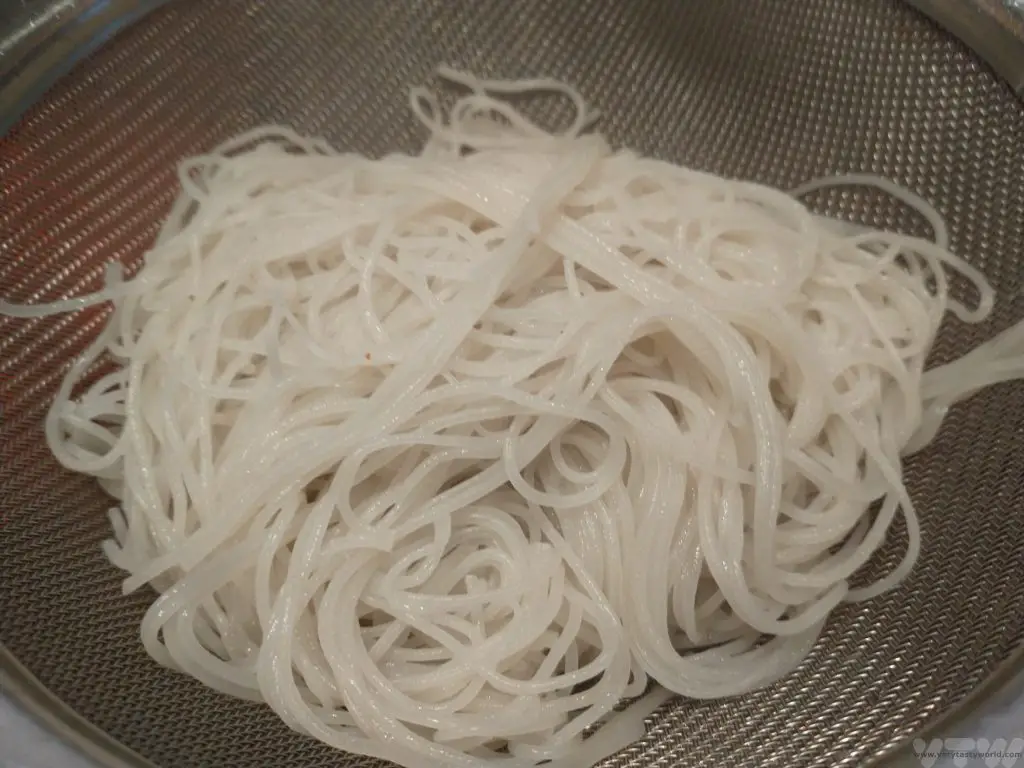
Prepare the filling. Shred the lettuce/cabbage.
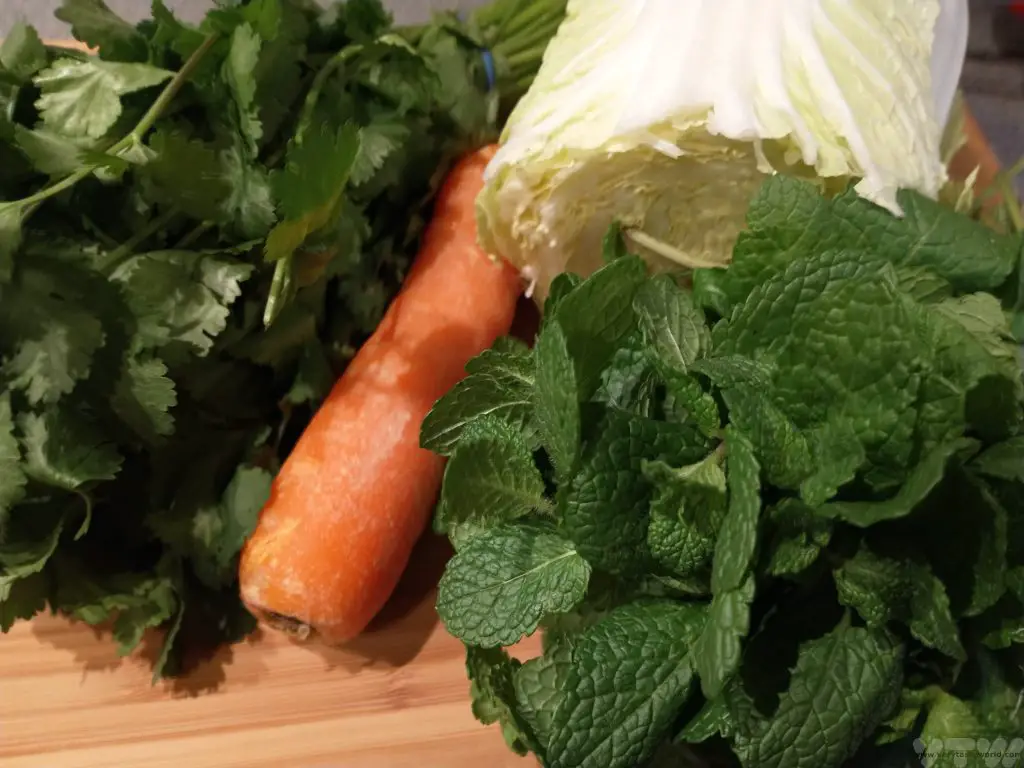
Finely slice the carrot. There is a tool that you can buy easily in South East Asia which is a little like a vegetable peeler that juliennes the carrot. If you don’t have one of those you could use a mandolin. And if you don’t have a mandolin a grater will do just fine.
The packaging on the paper skins – and many other recipes – states that you only have to soak them in warm water for a couple of seconds. We found that actually some of them need quite a bit longer soaking time. (And some just didn’t go soft at all- those should be discarded, these are not crunchy rolls and will not only not taste very nice, they will have a horrid texture and be really difficult to roll.)

When the paper is super-soft and totally translucent take it from the water and lay it flat on a clean surface. The skins are much more robust than they appear.
Start placing your filling onto the paper. You want to place it around 1/3 to 1/2 of the way up from the bottom of the paper and leave about 2 cm space on each side. Because the papers are partially transparent you can take your time to make the rolls look pretty. To do this make sure that the colourful items such as the prawns, herbs (try to keep the leaves whole for extra prettiness) or carrot are on the bottom of the pile, so that they can be seen through the wrapper.
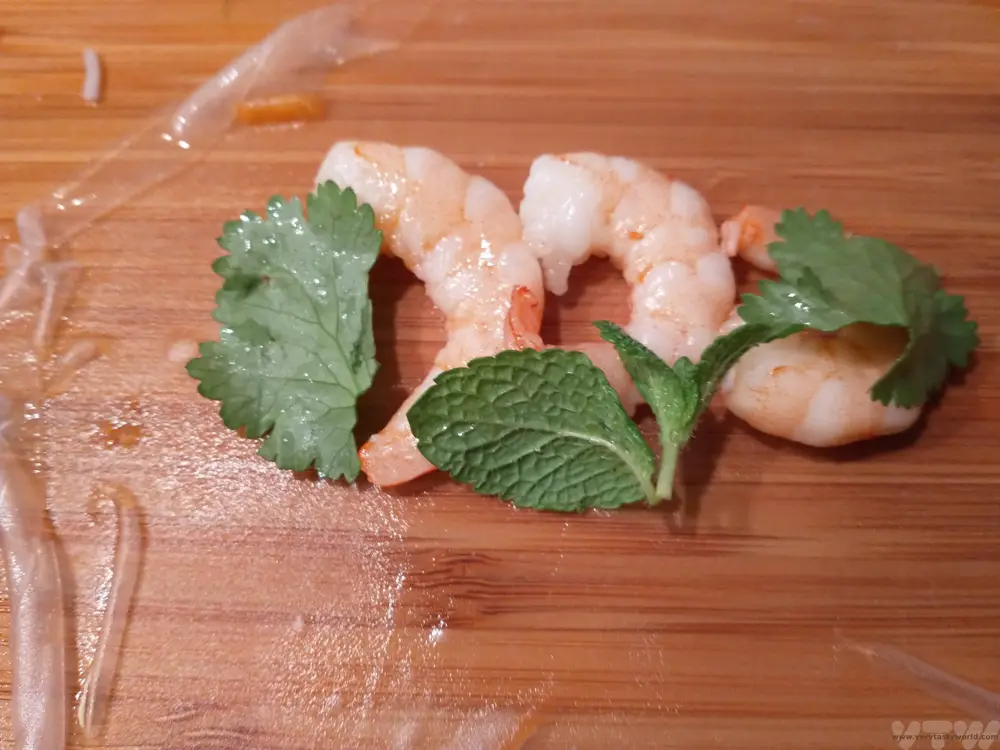
Add a small handful of vermicelli, remembering that less is more – you don’t want to overstuff the rolls.
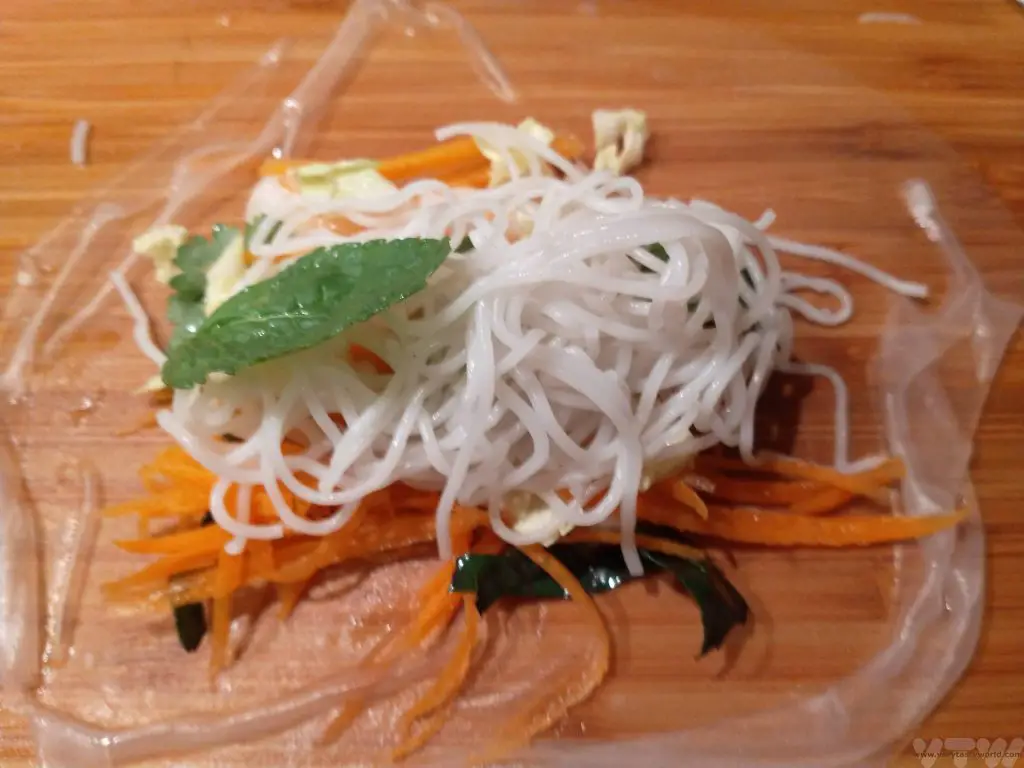
Variation: We also added some slices of home-made pickled garlic to some of the rolls to add an extra zingy flavour.
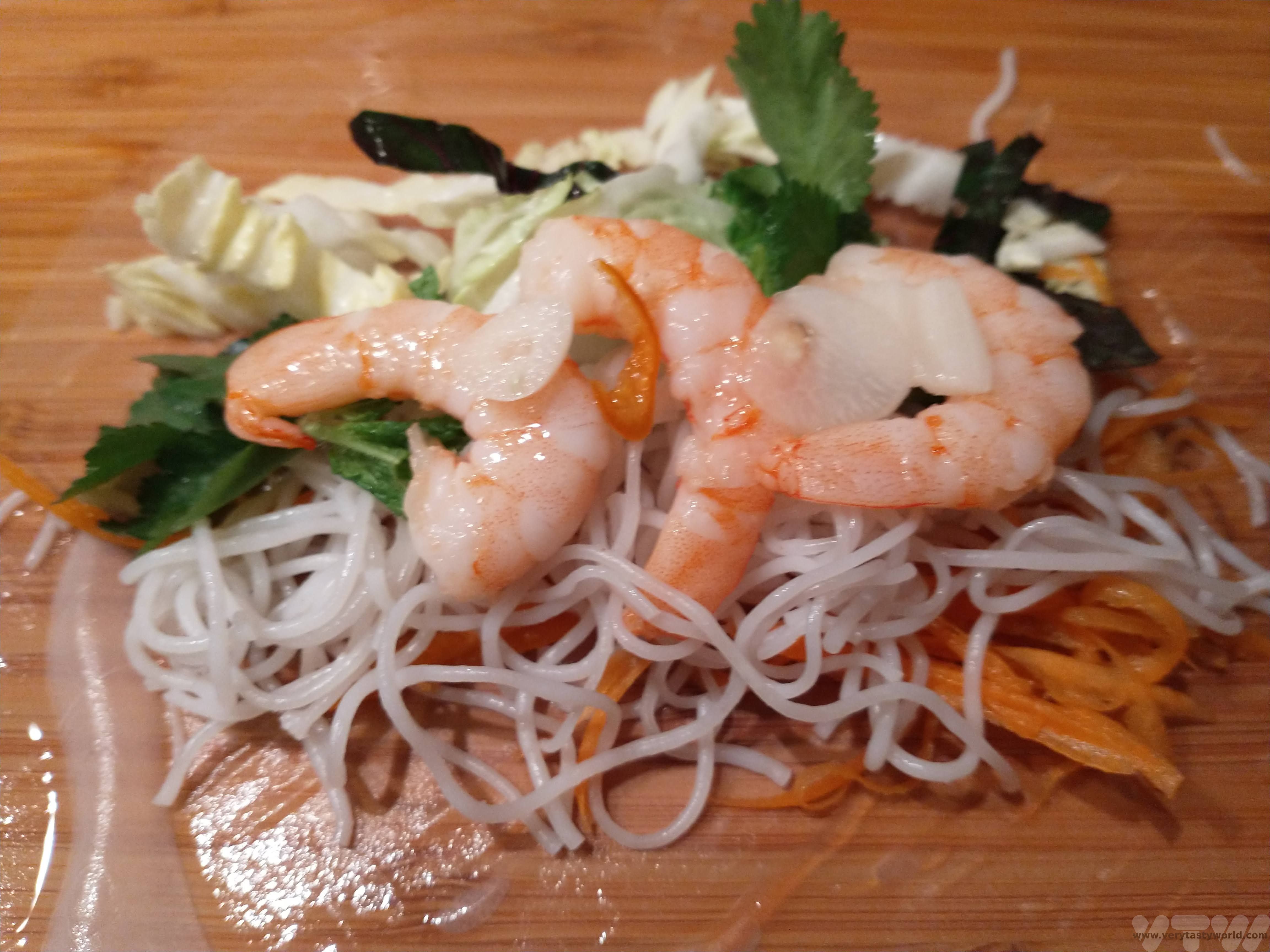
Now the tricky bit: the rolling of the rolls. It’s not as difficult as it might appear. Firstly, pull the filling together and fold the bottom of the paper over it, pressing gently into the filling so that the wrapping is tight.
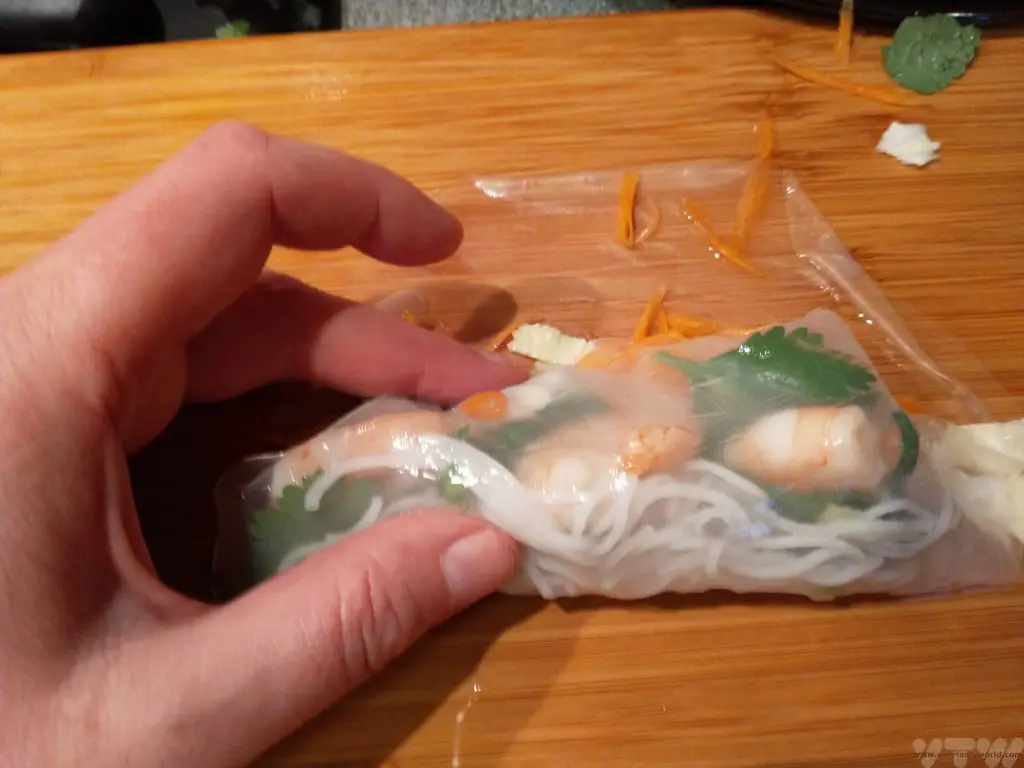
Next, fold each side in towards the centre of the wrapper to form a little parcel.
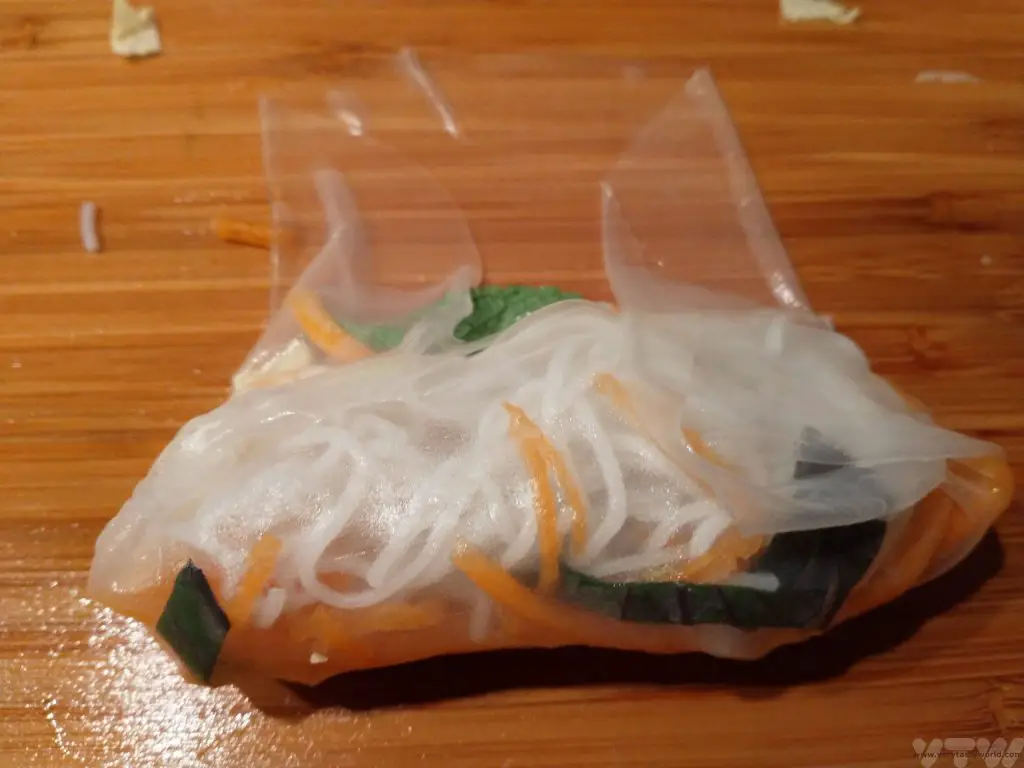
Then roll forwards to complete the spring roll, trying to keep the filling inside as tight as possible. The paper is soft so will stick at the end easily. When the rolling is completed, keep the seam on the underside which will also help it stick.
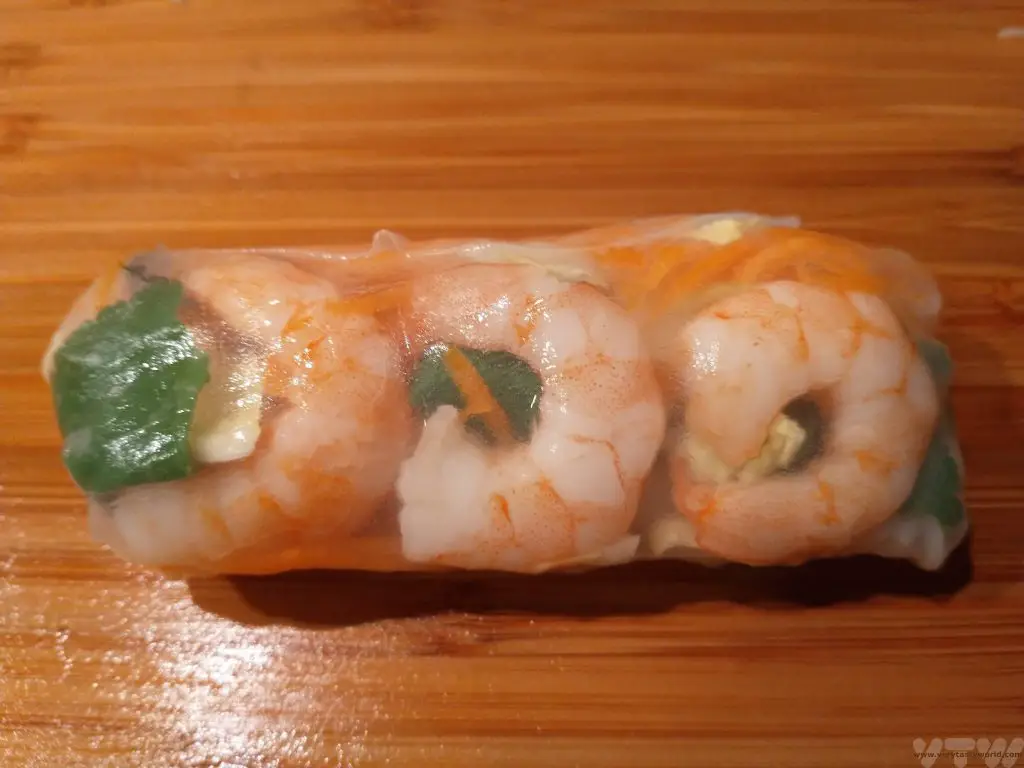
There are a variety of dipping sauces. A popular one is hoisin and crushed peanuts but we made a sweet chilli dipping sauce.
We used sweet chilli sauce, half a lime and a splash of fish sauce to give us that characteristic sweet, sour, salt and spice flavour. Just mix the ingredients together in a bowl. Then it was simply a case of serving the rolls, dipping and enjoying.
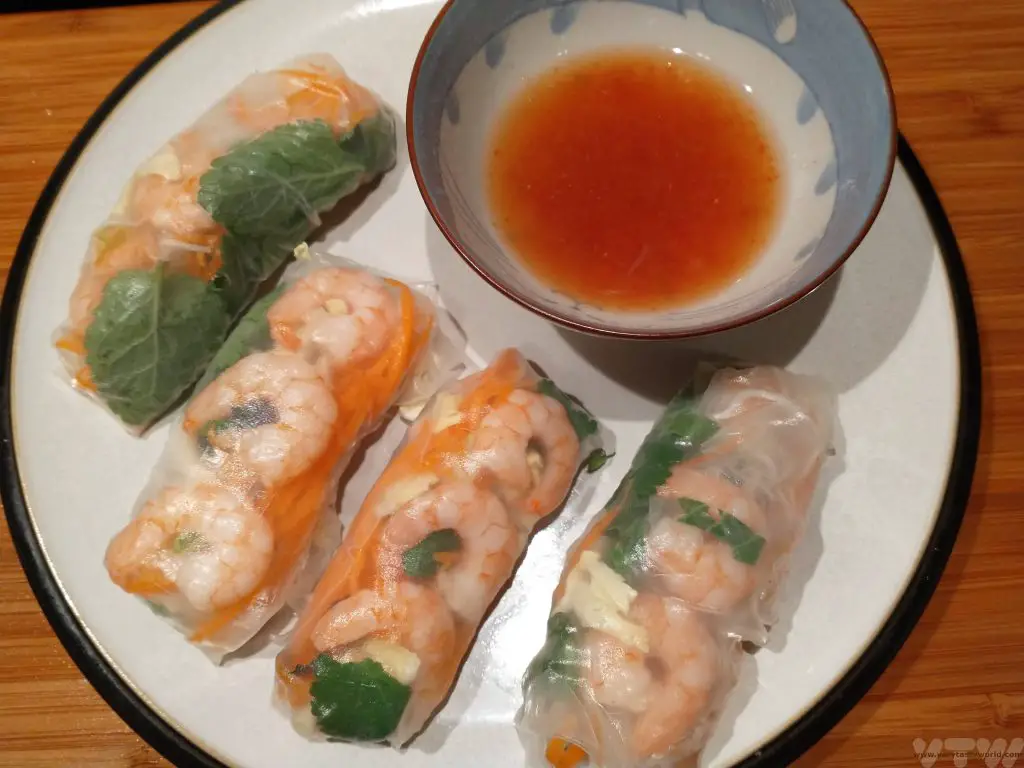
How to make Vietnamese spring rolls summer rolls
These are some of the tools and ingredients we used to make the summer rolls:
Please note that this post contains affiliate links. If you click the link and decide to make a purchase we will earn a small commission, at no cost to you, which helps towards running this site.

- A One Day Hanoi Itinerary
- Mekong Meanderings
- A Chiang Rai Temple and A Country Retreat
- A Chiang Mai Tour in Northern Thailand
- Sunrise at Angkor Wat and Other Temples
- Mekong Delta River Cruise in Vietnam

- RECIPE Oyakodon Donburi
- Zero Waste Recipes Before Your Holiday
- RECIPE: Vegetable Biryani Tamil Nadu Style
- RECIPE: Vegan Wild Garlic Pesto
- Recipe: Venetian Pasta Sauce
- RECIPE: Biryani Raita Recipe
- RECIPE: How to Make Costa Rica’s Gallo Pinto
- Recipe: Japanese Simmered Pork Belly – Buta no Kakuni
- RECIPE: How to Make Umeboshi
RECIPE: Vietnamese Pickled Garlic
We were in our favourite local Vietnamese restaurant recently and, while eating a delicious bowl of Bún Bò Chân Giò Huế – Beef, Pork Hock, Meat Balls in a vermicelli noodle soup (Bún means vermicelli and the dish originated in Huế, a coastal city in central Vietnam that used to be its capital), the restaurant staff brought out a jar containing pickled garlic to be used as a condiment. It was delicious – it added another dimension to the dish – a zap of sour garlic with just a hint of spice from the chilli infused vinegar. It’s a really popular condiment and apparently some of the restaurant’s customers will devour the whole jar when it’s brought to the table. We figured it probably wasn’t too difficult to make ourselves so we did some experimenting and, indeed, it’s a really easy recipe.
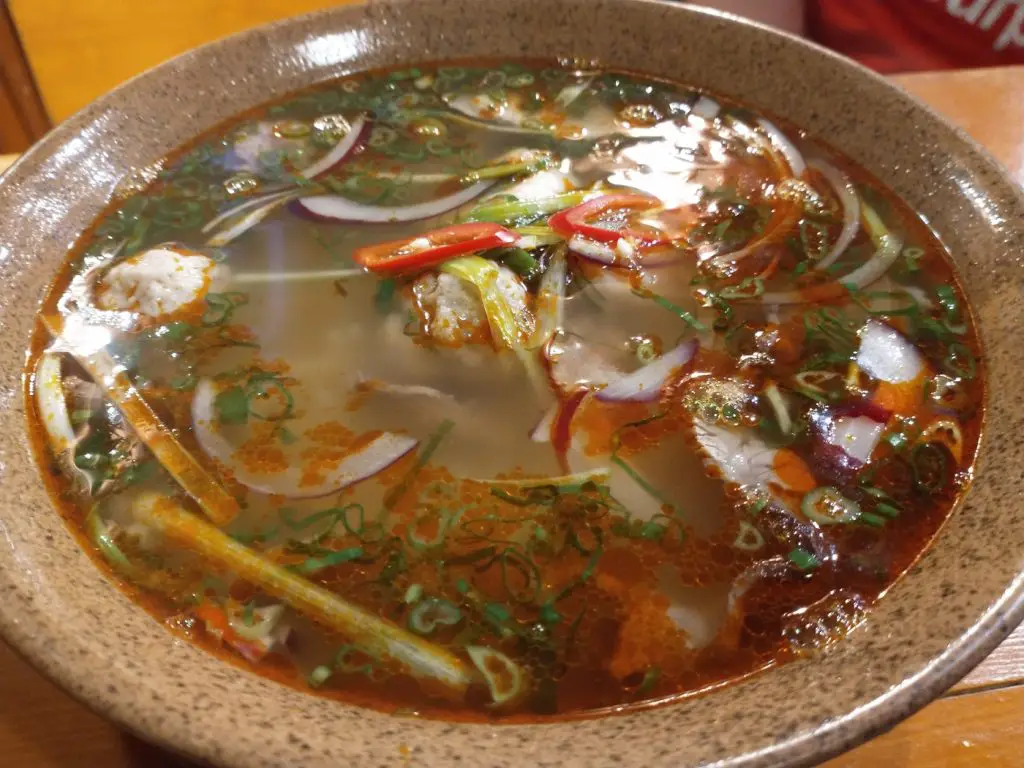
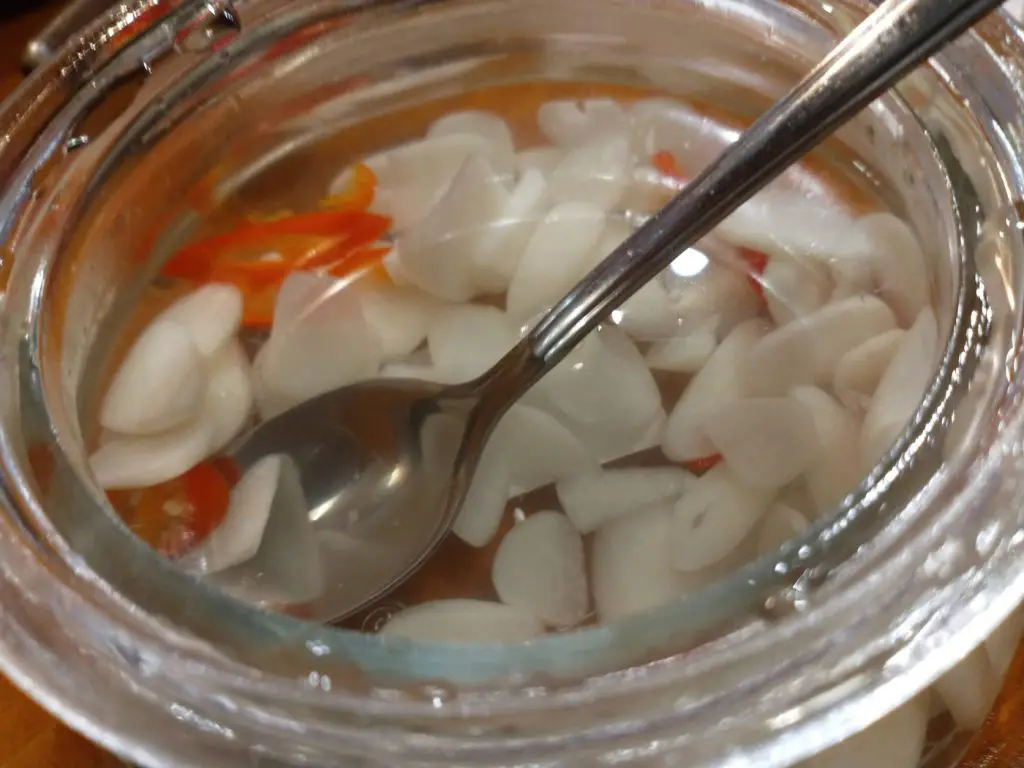
We had grown a bunch of garlic earlier in the year – planted in the late autumn we harvested it mid-summer. We also have a habit of keeping empty jars for preserving purposes, so had most of the ingredients and equipment to hand. It’s very flexible to make and the quantities in the recipe really depend on the size of your container. You will need a clean empty jar – you can use any old jar. Just wash it out thoroughly and fill it with boiling water, which will make sure it’s clean enough to store pickles, then let it cool down. Our jar was around 300 ml capacity.
Vietnamese Pickled Garlic Recipe
Ingredients
Several bulbs of garlic (the quantity will depend on how large the bulbs are and how finely you wish to slice it)
Two red chillies
White vinegar (you can use rice vinegar if you are feeling decadent but the garlic has a strong flavour and we feel it would dominate the subtle flavour of the rice vinegar)
2tsp white sugar
1/2 tsp salt.
Method
Peeling the garlic is the most time-consuming part of this job. Garlic is one of the stickiest substances known to human kind but you don’t realise this until you start peeling lots of it.
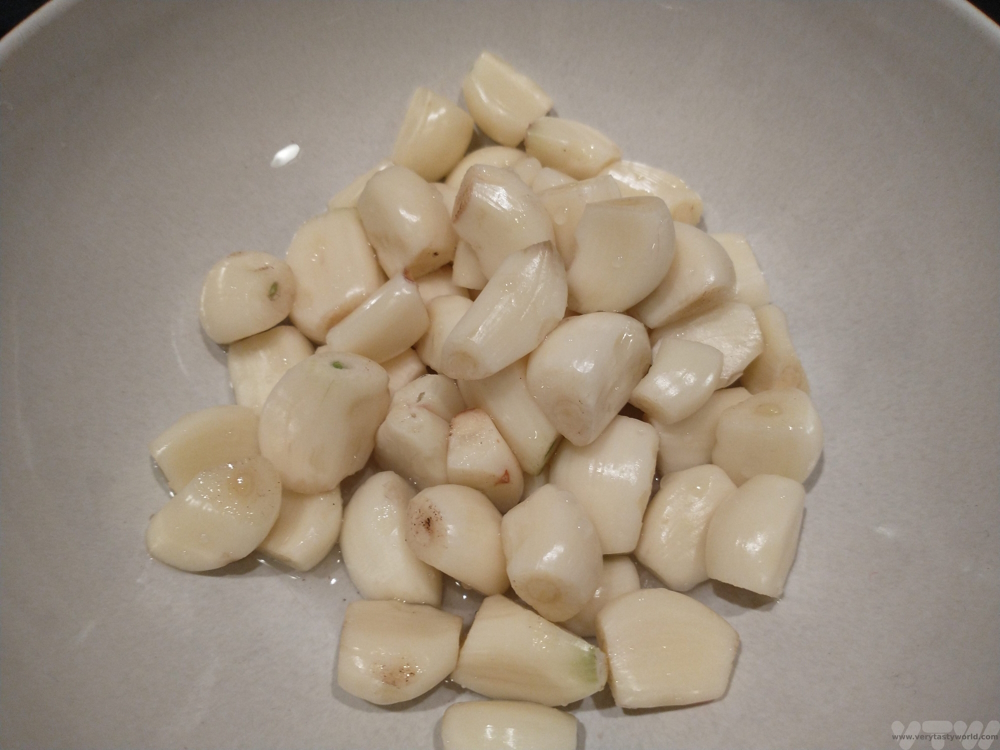
Once peeled, you have a number of choices. You can keep the garlic cloves whole, you can slice them with a knife or you can slice them wafer-thin using a mandolin. We prefer the very thinly sliced garlic because when you add it as a condiment the flavour enhances rather than dominates the food.
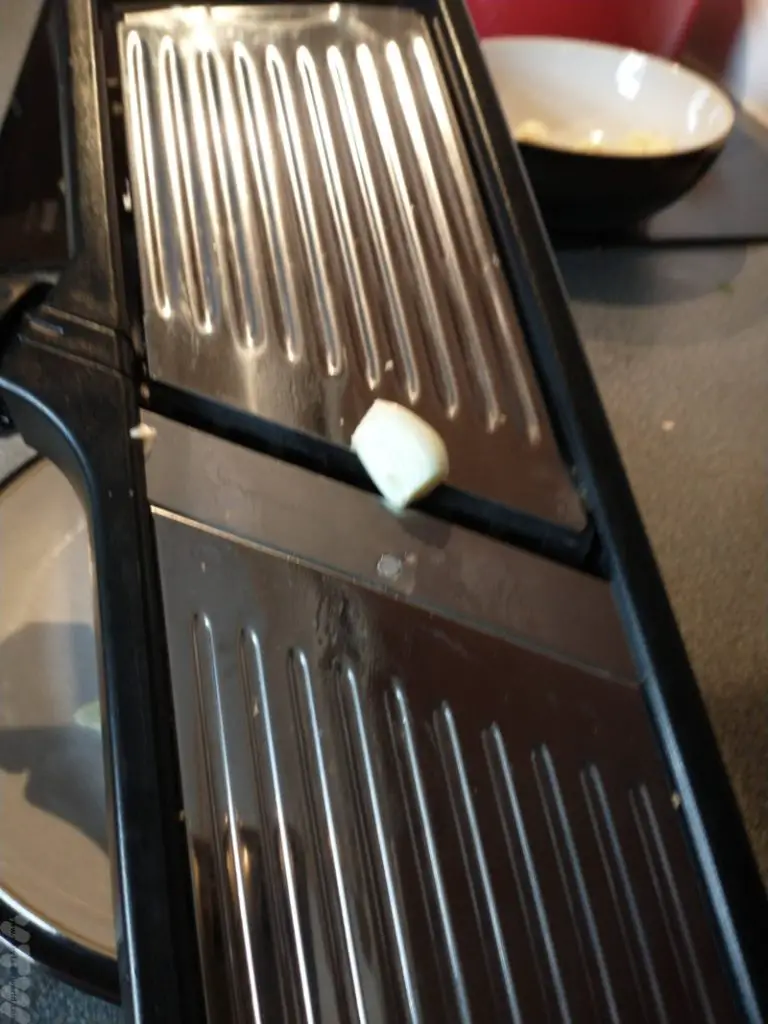
If using a mandolin, be really careful. Being clumsy cooks, we use a knife glove which means that you can slice the garlic very close to the blade without risking sliced fingers. Bloody garlic pickle is not a good idea.
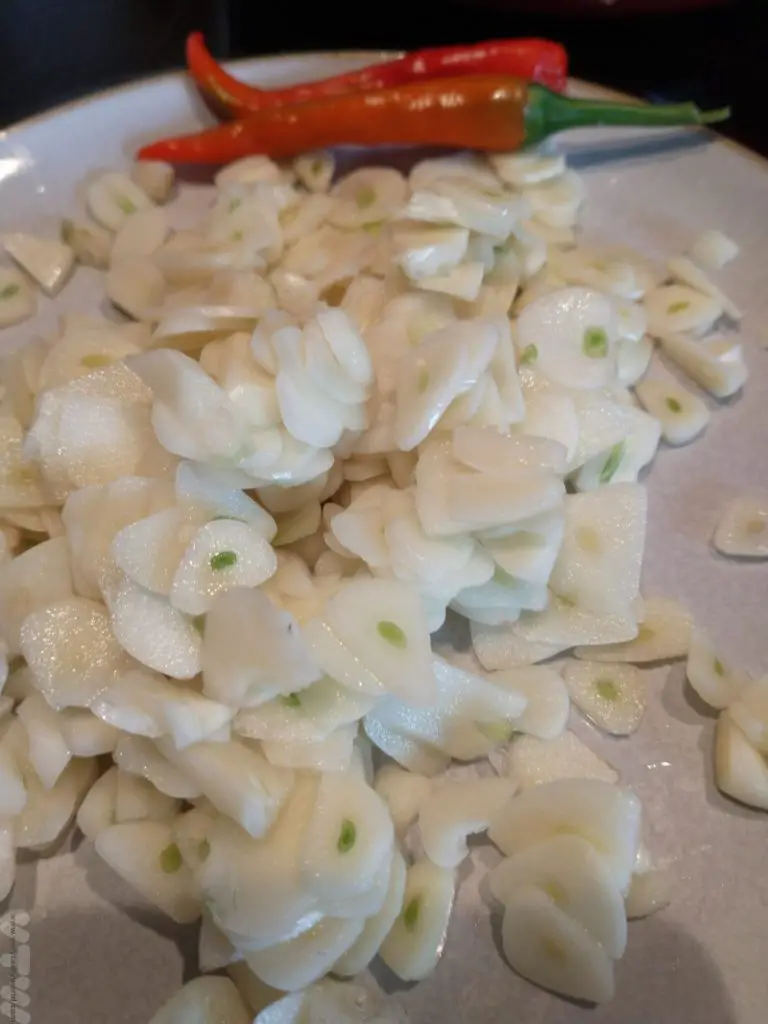
Place the sliced garlic, slice the chillies and add everything to the jar.
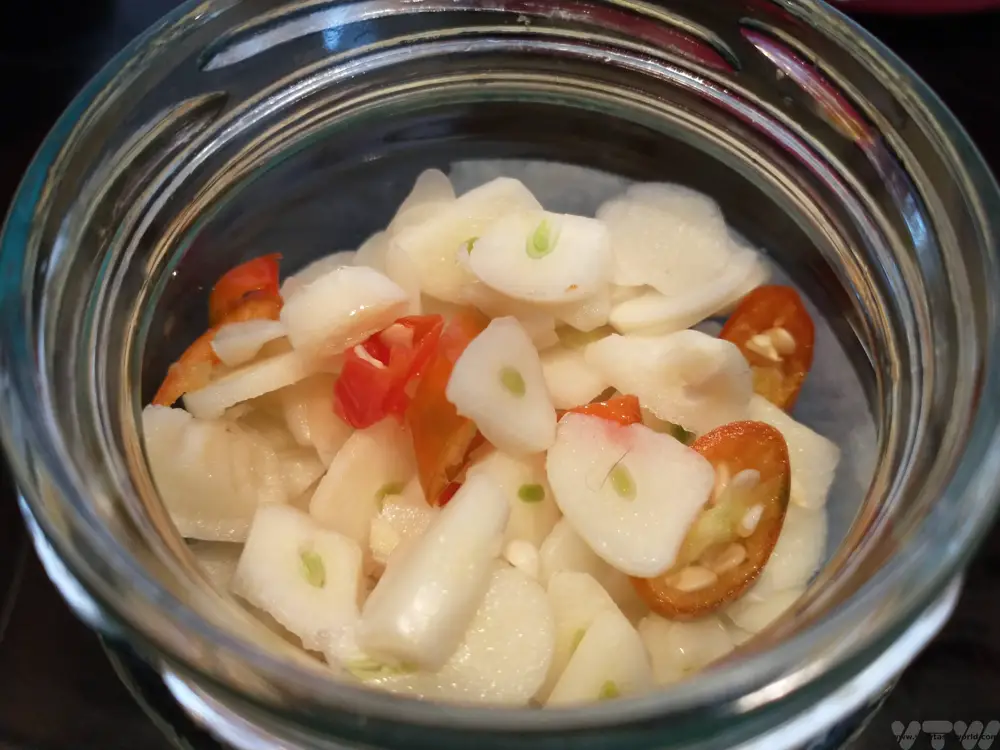
Top up with the vinegar. Add the sugar and salt.
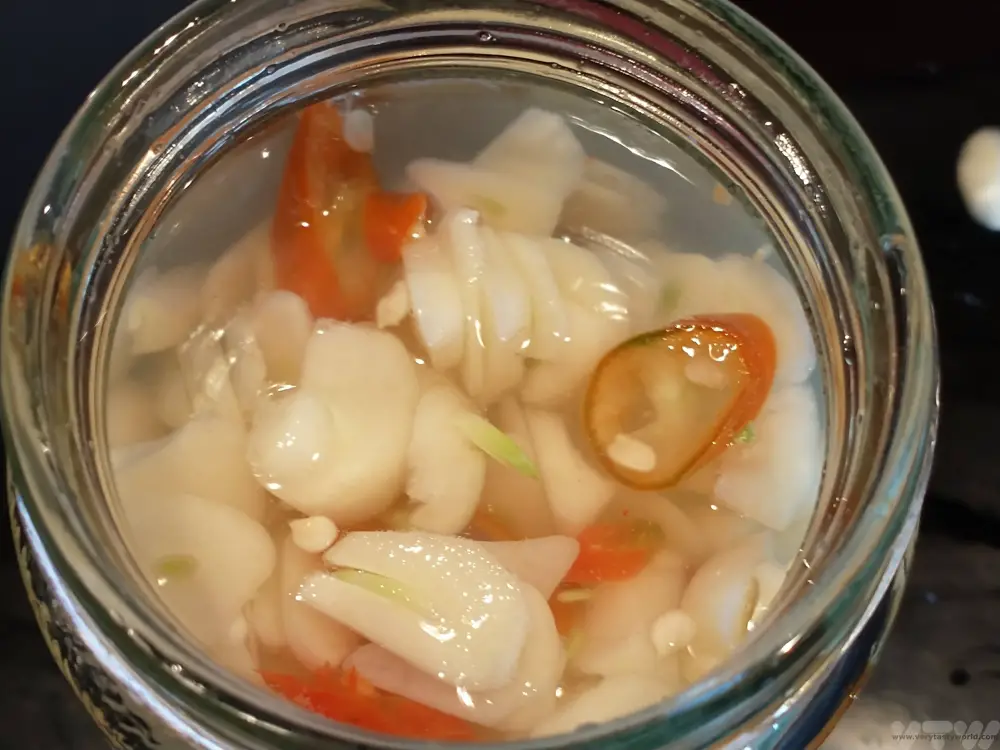
Shake the jar.
Leave to infuse for at least a week. The pickled garlic will last for months… but is likely to get scoffed much sooner. Also, because the vinegar is acidic you can add additional sliced garlic or another chilli as you use up the existing condiment.
Although this dish goes really well with Phở and Bún Huế dishes, we’ve also used it to add a bit of zing to Vietnamese summer rolls.
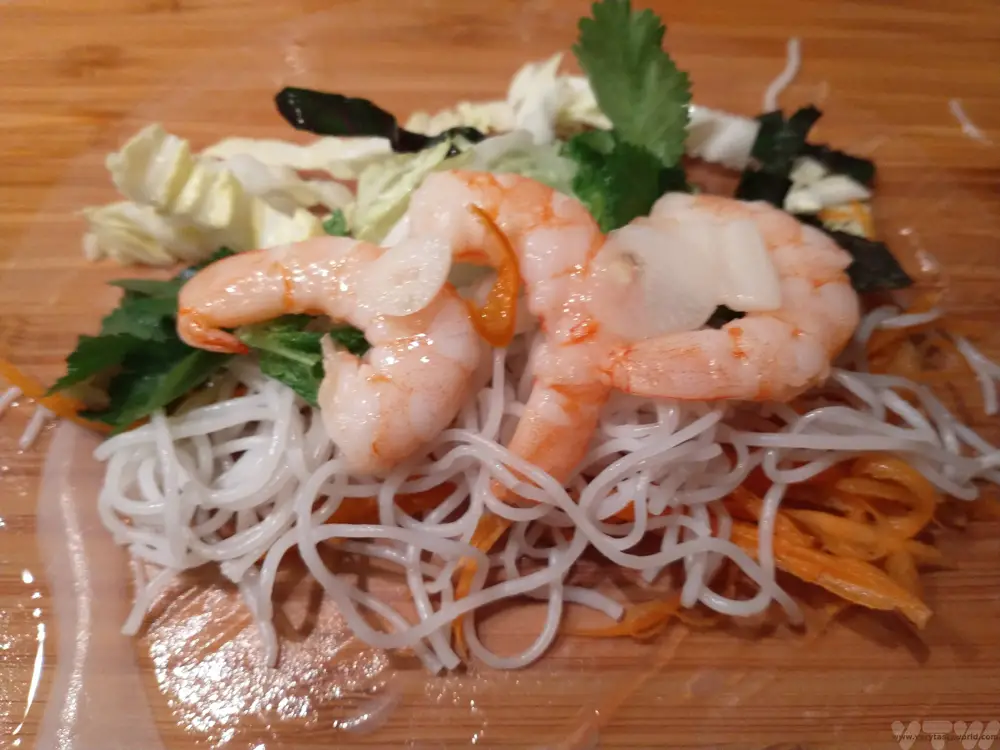

And this condiment isn’t just for Vietnamese cookery. We use this pickle to garnish soups – this is a home-made vegetable soup.
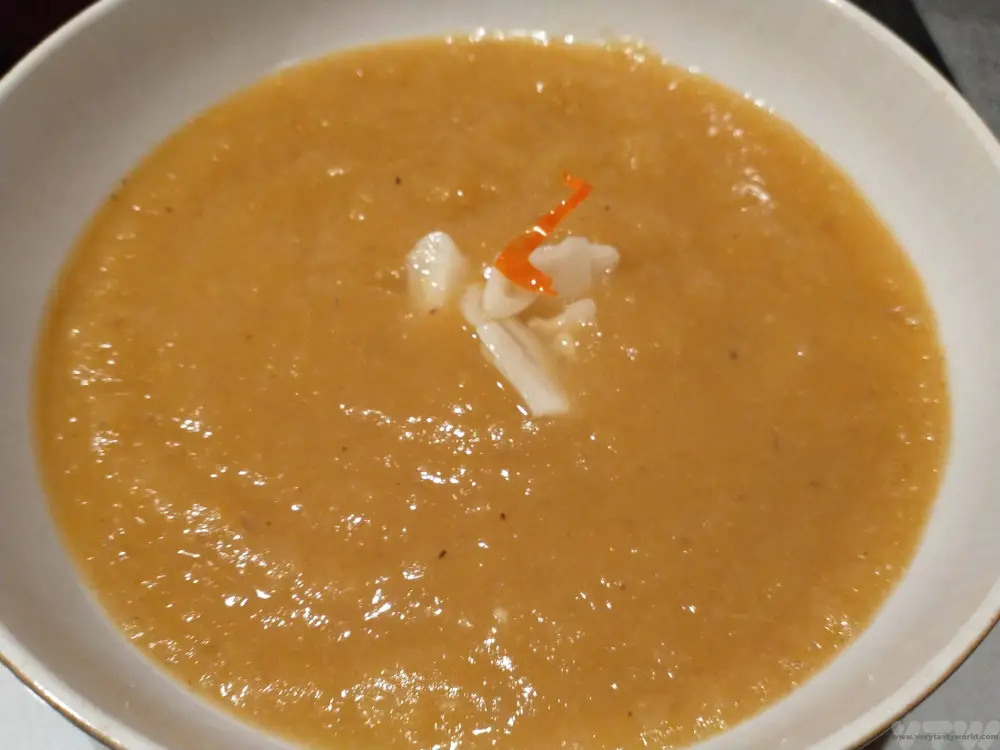
Or it can be used in a meat dish – these are glazed pork belly bites. Just a slice or two atop really cuts through the richness of the meat.
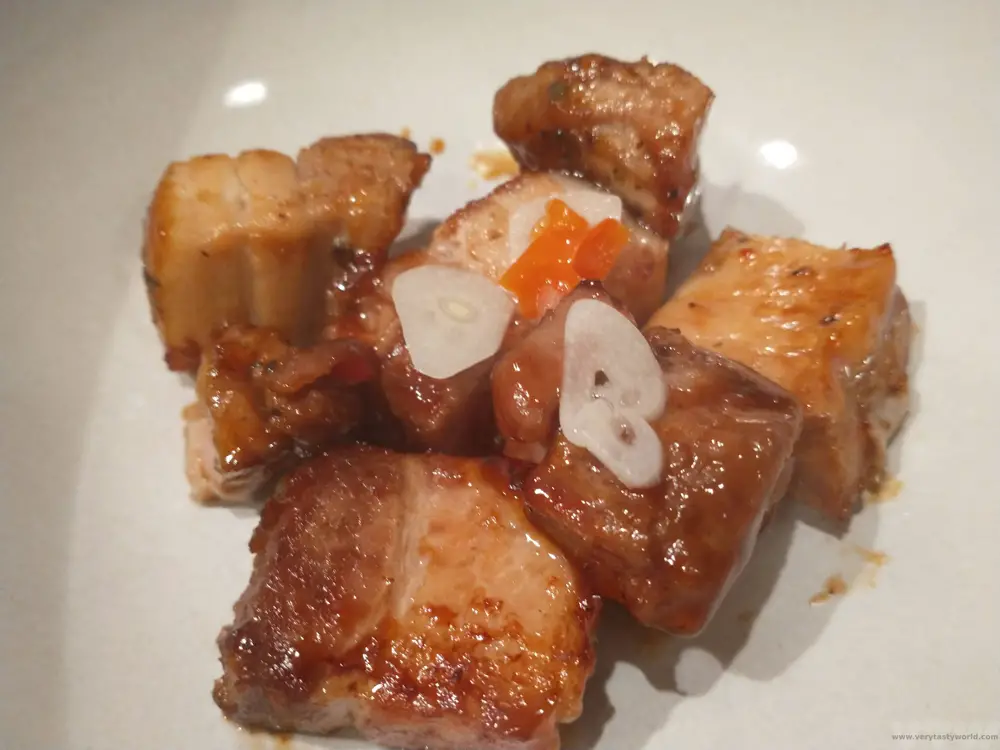
Related Posts You May Enjoy

- RECIPE Oyakodon Donburi
- Zero Waste Recipes Before Your Holiday
- RECIPE: Vegetable Biryani Tamil Nadu Style
- RECIPE: Vegan Wild Garlic Pesto
- Recipe: Venetian Pasta Sauce
- RECIPE: Biryani Raita Recipe
- RECIPE: How to Make Costa Rica’s Gallo Pinto
- Recipe: Japanese Simmered Pork Belly – Buta no Kakuni
- RECIPE: How to Make Umeboshi
Please note that this post contains some affiliate links. If you click the link and decide to make a purchase we will earn a small commission, at no cost to you, which helps towards running this site.

RECIPE – Kabocha Korroke – Pumpkin Croquettes
Kabocha is a type of squash, often called a Japanese pumpkin. It is small-medium in size (around 25-30cm diameter). Its flesh is bright orange which contrasts beautifully with its dark green skin. They are also pretty easy to grow. And it is a truth universally acknowledged that home-grown vegetables are always more delicious than shop bought ones.

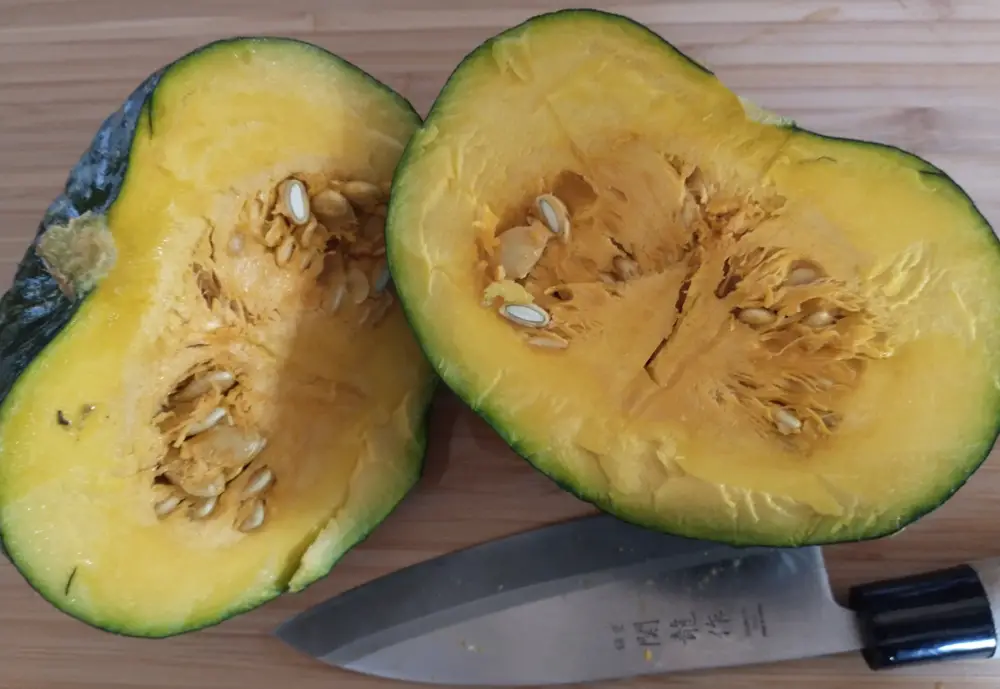
This year we grew three of the beauties in our little garden and the very first thing we wanted to make once harvested, was ‘korroke’, a Japanese version of croquettes (the word is spelled in katakana, the phonetic alphabet used for words of international origin). It’s the sort of dish that you would find in a Japanese izakaya (a bar that sells alcohol and tasty snacks/small dishes). They are simple to make and utterly scrumptious. Here’s our recipe for Kabocha Korroke – Pumpkin Croquettes:
Ingredients For Pumpkin Croquettes
1 kabocha pumpkin. If you can’t get a kabocha, other squash can be used. Pumpkin might be a bit too squishy but something like a butternut squash would work well.
1 egg (vegans can use corn starch mixed with warm water in an approximate ratio of 1:3)
50g (approx) Plain flour
50g (approx) Panko breadcrumbs
Pinch of salt
Oil for frying/spray oil for baking
Tonkatsu sauce to eat with (Brown sauce will work well if you can’t get tonkatsu)
Method
Cut the pumpkin in half and then into slices. Remove the seeds (we kept loads of seeds and dried them so that we can sow them next year).
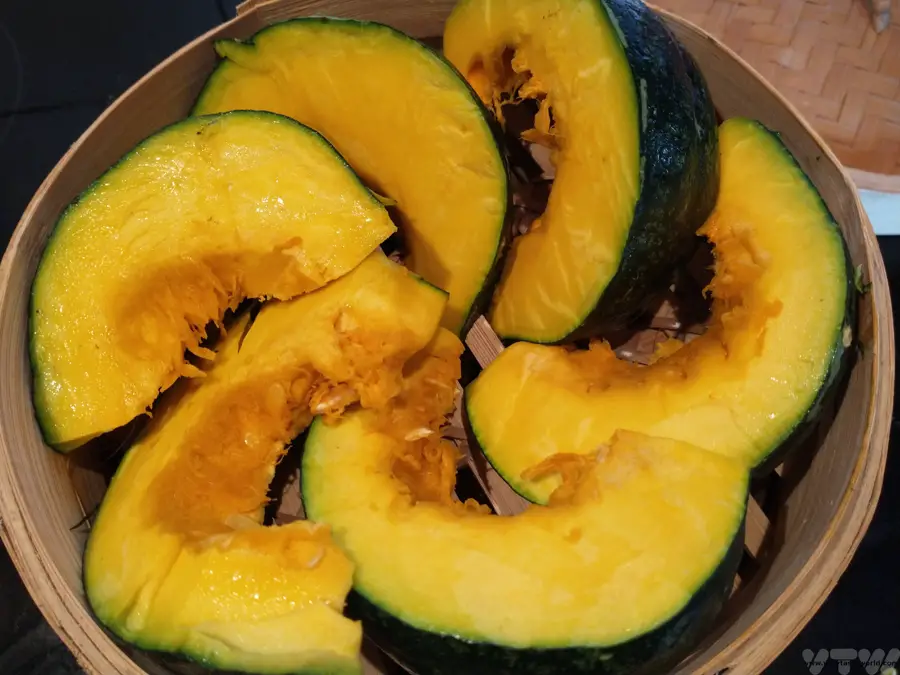
Arrange the slices into a steaming bowl. We tend to use the Asian style bamboo baskets as they stack very nicely and can just sit on top of a saucepan of boiling/simmering water.
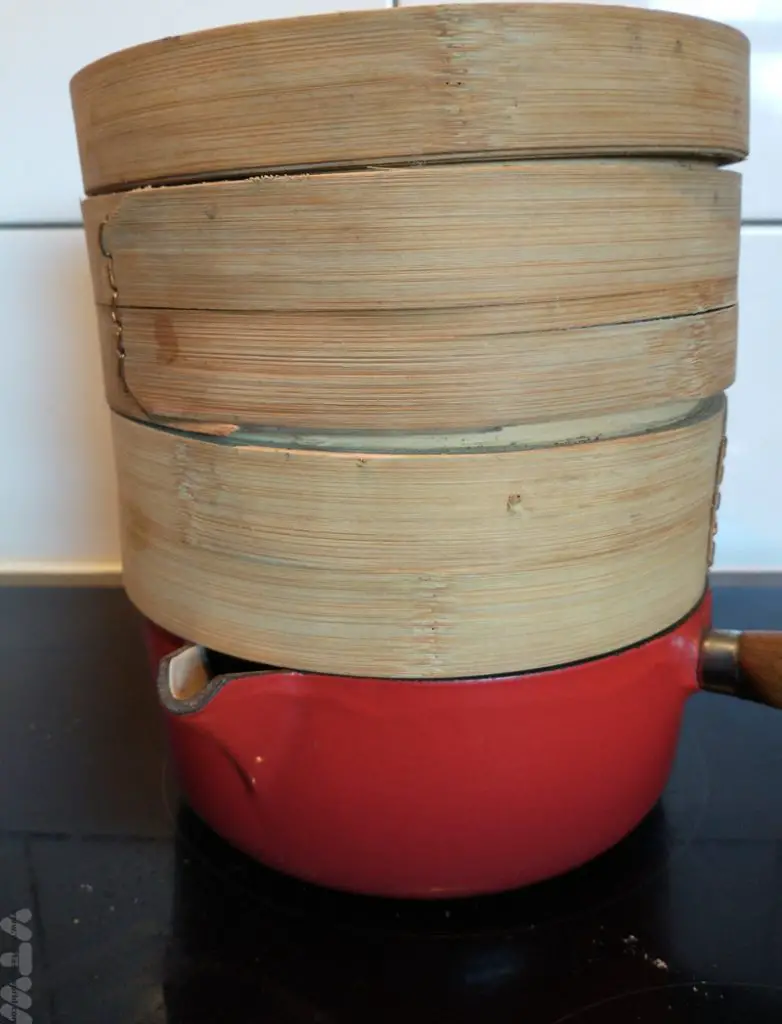
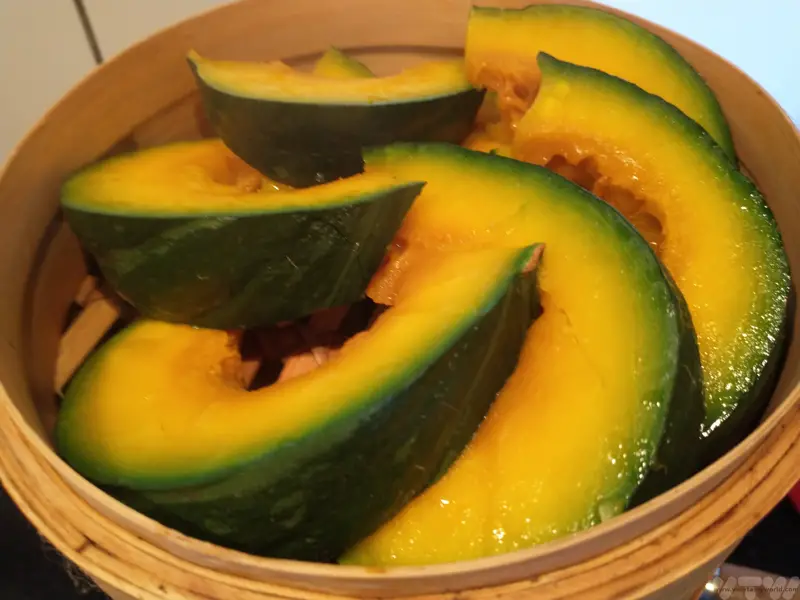
Steam for around 15 minutes or until the pumpkin is soft – a knife should easily sink into the flesh. (If you don’t have a steamer you can bake the pumpkin slices in the oven for around 40 minutes.)
Although the skin of the kabocha is edible, for the purposes of the korroke it is best to remove it. (You can treat yourself to pumpkin skin snacks – once they have cooled down a bit – while you continue the preparation.)
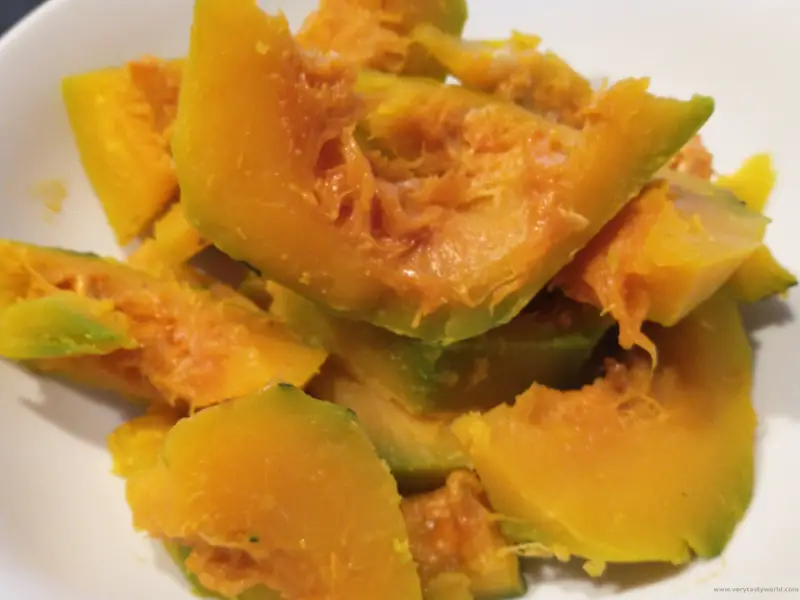
Add a pinch of salt and mash the pumpkin using a potato masher. It is possible to add other flavourings at this stage if you wish. Some recipes add sautéed onions, others lashings of butter, yet others include shichimi (Japanese seven spice mix). We just seasoned with the salt, which brings out the natural flavour of the kabocha, in this instance.
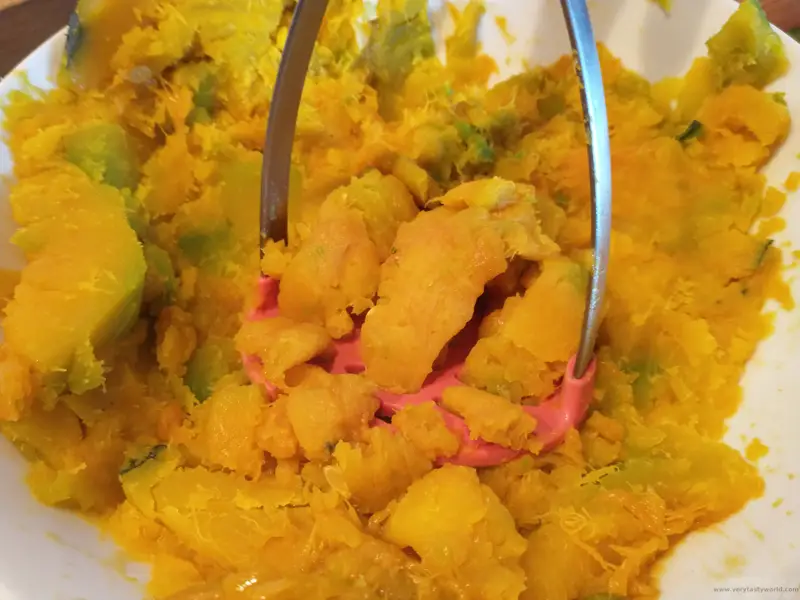
Form into patties.
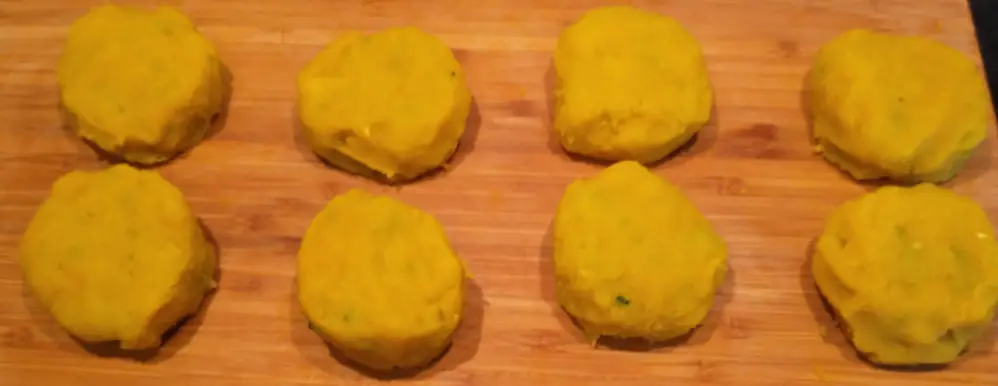
Panko are Japanese breadcrumbs. They are crispy and super dry, usually made from white bread. You can buy panko in most supermarkets these days but ordinary breadcrumbs will be fine if you can’t find them. Set out three bowls. One for flour, one for an egg, lightly beaten, and one for the panko.

Dip each patty in the flour, then the egg, then the panko. This process can get a little messy (especially if you are a clumsy cook). Do not attempt to take photos using your phone if you have sticky fingers.
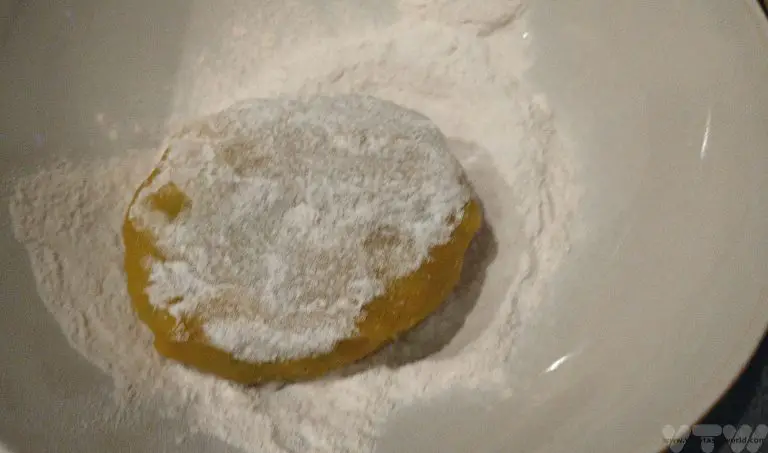
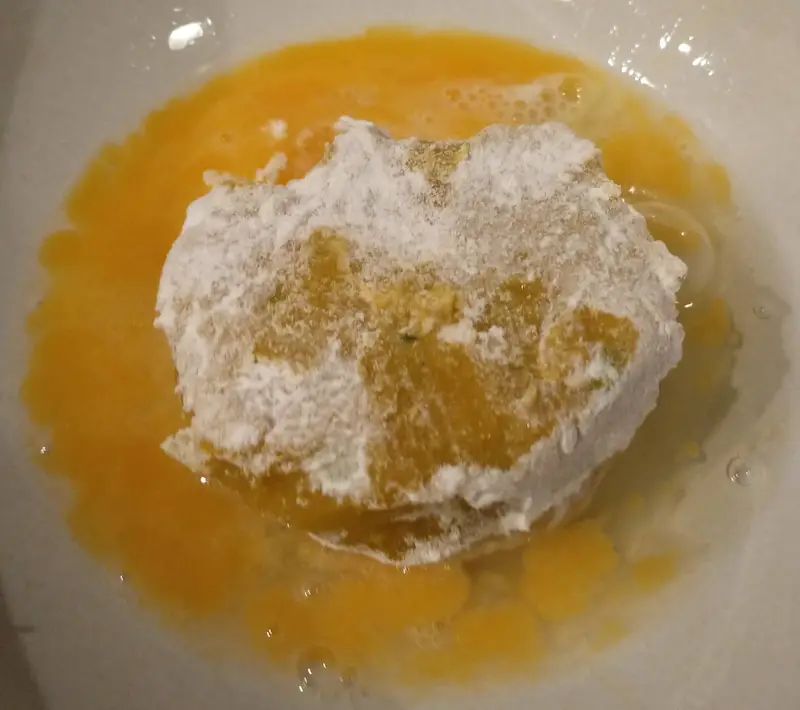
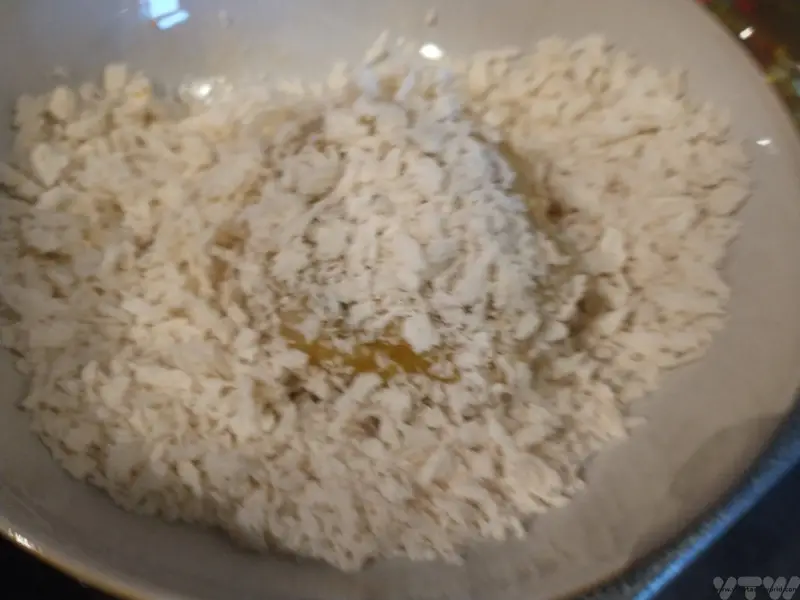
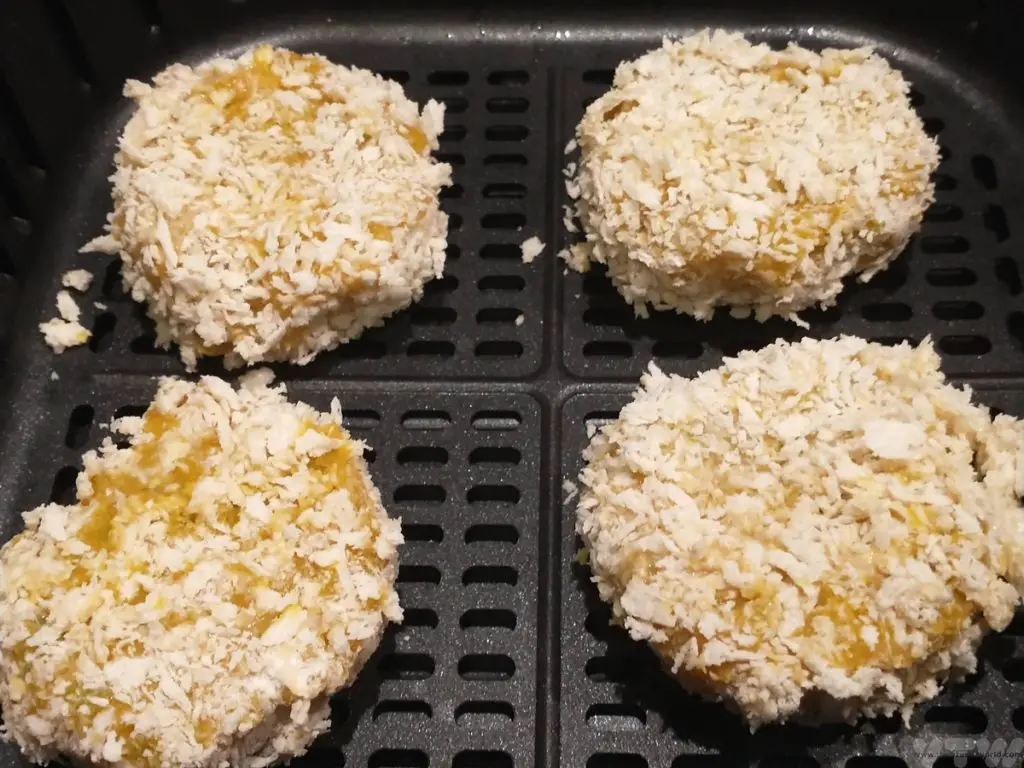
There are several options for cooking. Bear in mind that the pumpkin is already cooked so the korroke don’t need long. We’ve recently invested in an air fryer so thought we would use that. Just spray the patties with oil and cook at 190C for 4 minutes on each side. You can also bake them in the oven for about 8 minutes. Or you can fry them the old-fashioned way in vegetable oil for a couple of minutes on each side or until the panko are golden.
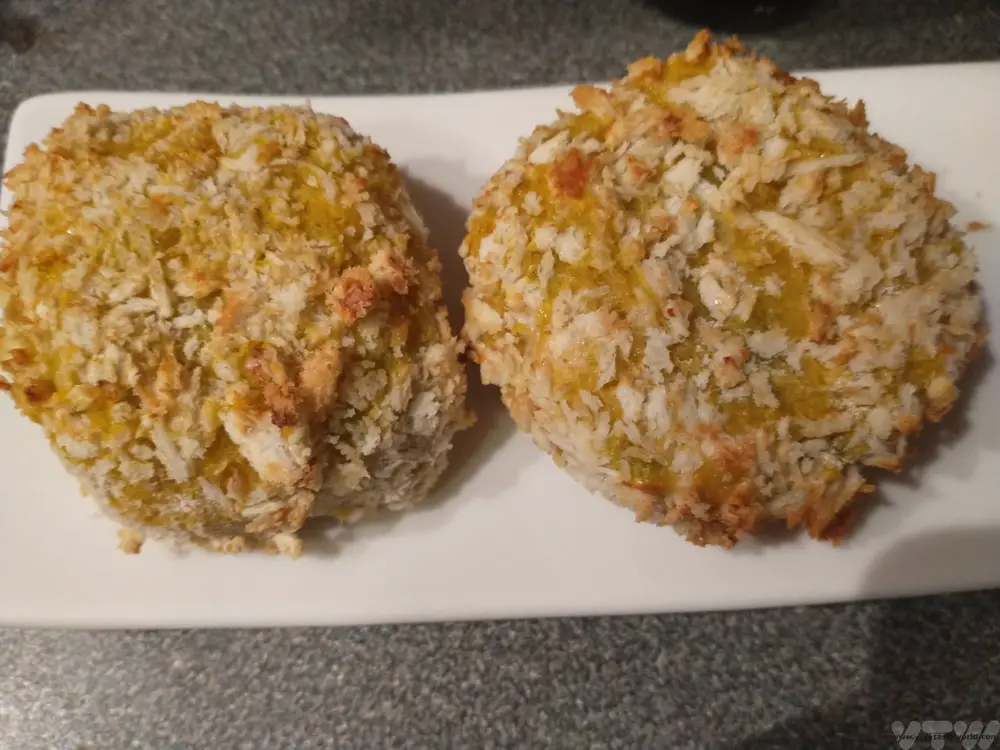
Then it’s time to scoff! Korroke are often served with tonkatsu sauce. This is a sweet and tangy sauce that perfectly complements the pumpkin. If you can’t find tonkatsu, brown sauce (the type you eat with a cooked breakfast) is a good substitution. Other accompaniments can include mayo or a soy based dipping sauce. Best served with a nice, cold beer. Or two.
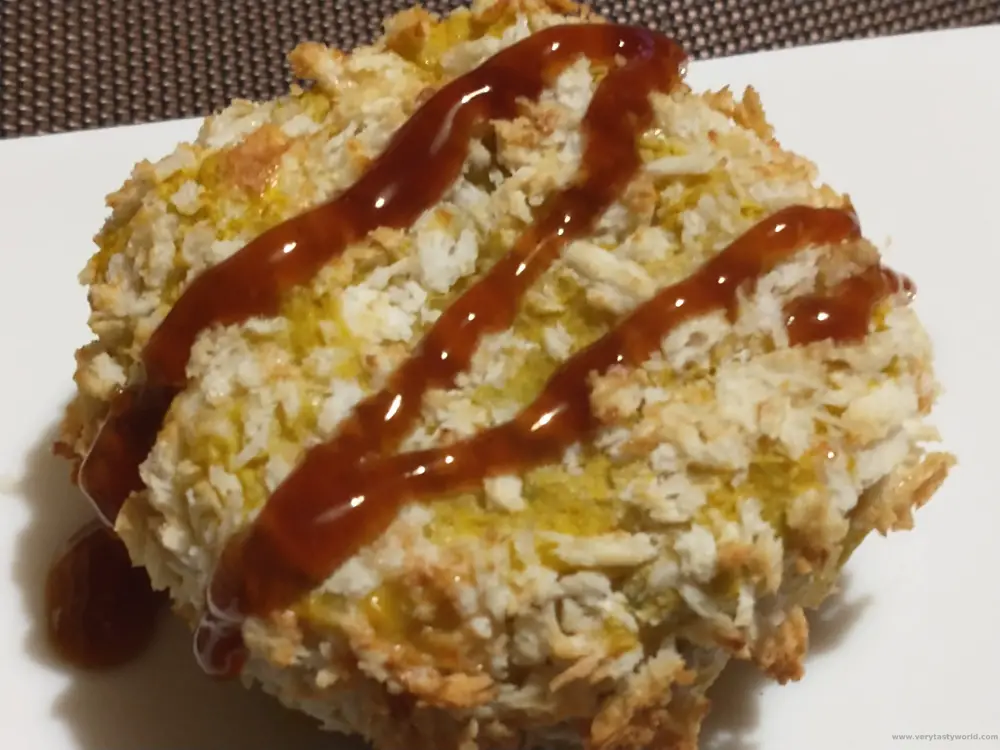

- RECIPE Oyakodon Donburi
- Zero Waste Recipes Before Your Holiday
- RECIPE: Vegetable Biryani Tamil Nadu Style
- RECIPE: Vegan Wild Garlic Pesto
- Recipe: Venetian Pasta Sauce
- RECIPE: Biryani Raita Recipe
- RECIPE: How to Make Costa Rica’s Gallo Pinto
- Recipe: Japanese Simmered Pork Belly – Buta no Kakuni
- RECIPE: How to Make Umeboshi
Go With The Sloe – How to Make Sloe Gin
It’s autumn in the UK, which means it’s the perfect season for foraging for fruit and mushrooms in the countryside. We are lucky to have many sloe (blackthorn) bushes in our local area and one of our favourite things to do at this time of year is to make sloe gin.
Sloe gin is a liquer made from gin and sloes, although other alcohol bases can be used. Unlike gin, which is quite perfumed, sloe gin is much sweeter, deriving its flavour from the fruit infusing into the alcohol as well as some added sugar.
Gin is a very fashionable drink these days, with a huge number of flavours and variations available, as well as it forming the base of a vast array of liquers and cocktails. Sloe gin is available commercially but if you have access to sloe bushes it is great fun to make your own.
It’s a really easy process and you can adapt it to your personal taste. It just needs a little patience.
Here’s a flow chart – or, if you will, sloe chart:

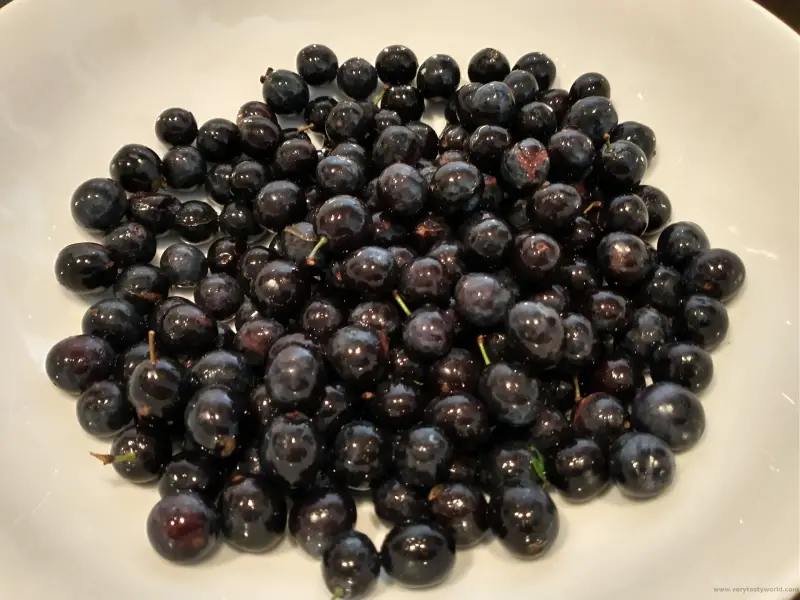
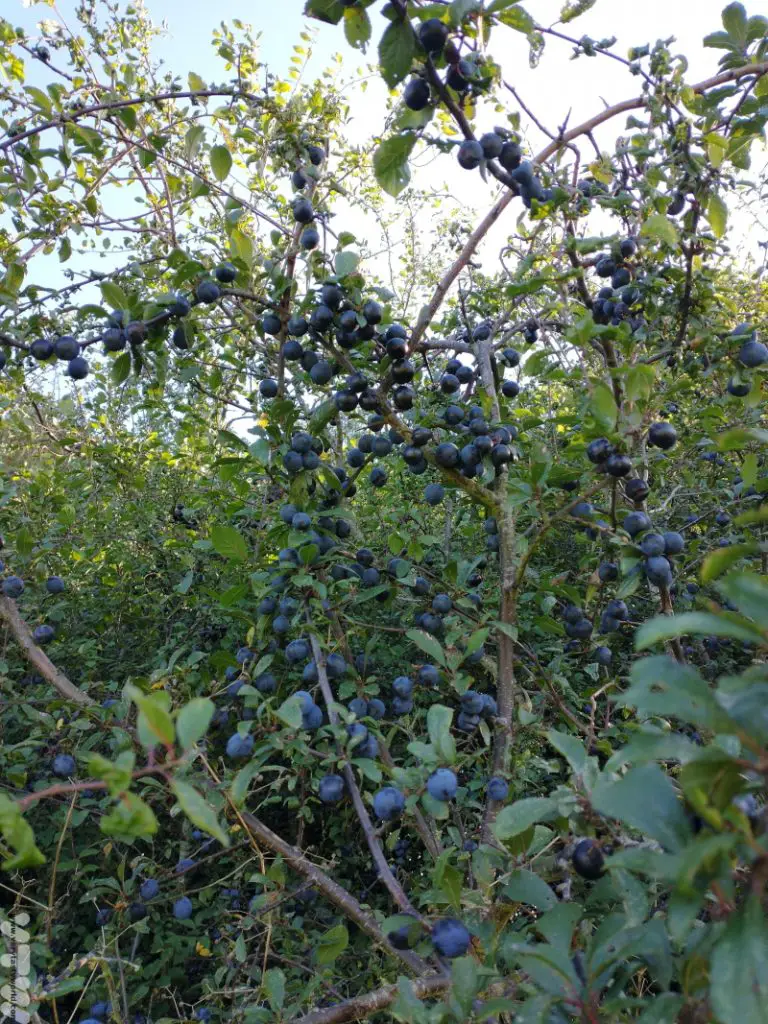
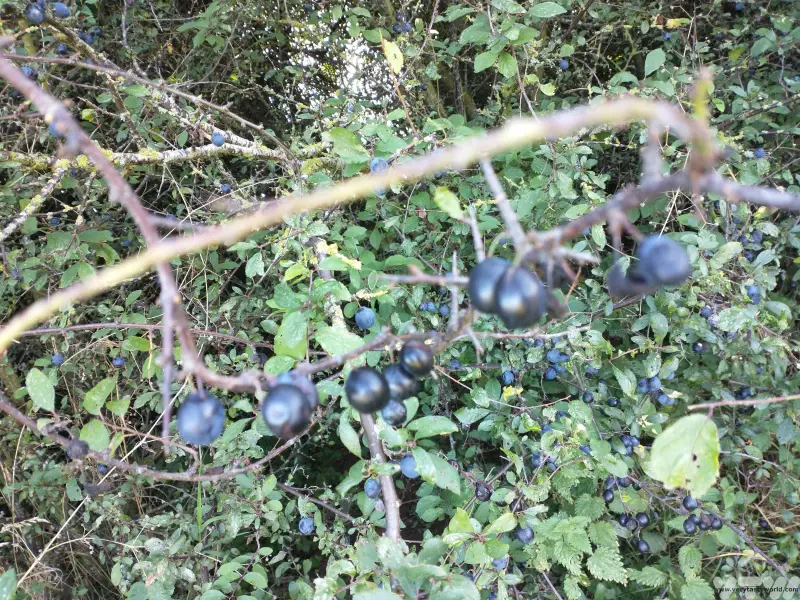
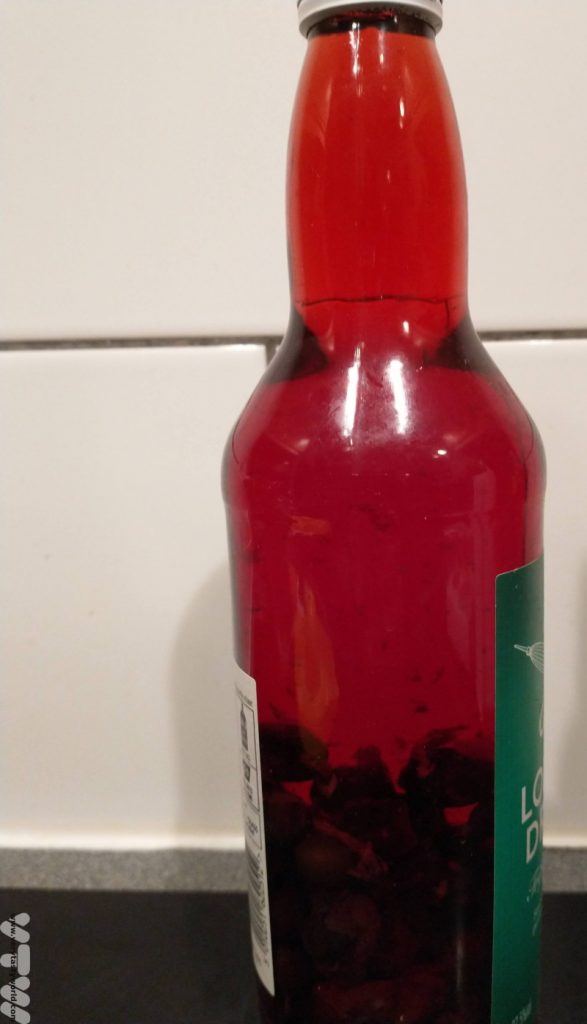
This is what the colour will look like after around three months. You can see that already the gin has acquired the colour of the berries.
Cheers!
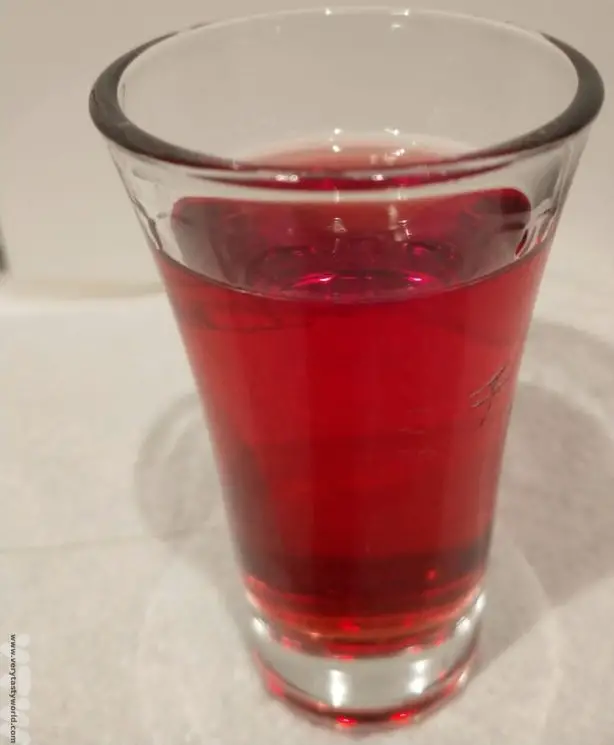
Postscript – sloe gin is also great if you pop the bottle into the freezer for a couple of hours. The alcohol doesn’t freeze fully but becomes slightly syrupy. It’s delicious, so remember to keep some back for summertime.
As with all foraging, do make sure you are 100% certain about the fruit that you are picking. There are some great identification guides.

- RECIPE Oyakodon Donburi
- Zero Waste Recipes Before Your Holiday
- RECIPE: Vegetable Biryani Tamil Nadu Style
- RECIPE: Vegan Wild Garlic Pesto
- Recipe: Venetian Pasta Sauce
- RECIPE: Biryani Raita Recipe
- RECIPE: How to Make Costa Rica’s Gallo Pinto
- Recipe: Japanese Simmered Pork Belly – Buta no Kakuni
- RECIPE: How to Make Umeboshi
RECIPE: How to Make Thai Green Curry
Thailand’s famous curries are amongst our all-time favourites. Kaeng khiao wan is a sweet green curry, kaeng phet is a hot red curry. It’s generally the chillies that determine the colour of the curry, although the milder yellow curry, kaeng kari, uses turmeric. Other popular curries include Massaman (which has Indian and Malay influences in its spicing), Panang (another Malay influence with peanuts as a key ingredient) and sour curry, kaeng som, (which has a more soupy consistency with lime and turmeric being important flavourings). Another, less well known, dish that uses both coconut milk and coconut cream is tom kah gai – chicken and galangal in a coconut milk soup.
Thai green curry is probably the dish we cook and eat most often at home. It’s easy to make and utterly delicious. Its translation means ‘curry green sweet’ – the green chillies comprise a significant part of the paste, which forms the base of the flavour, but this curry is slightly sweeter than other types of Thai curry. Some recipes call for a small amount of sugar to be added, others rely on the natural sweetness of the coconut milk. The flavour components revolve around green chillies, galangal, lemongrass, garlic, shallots, kaffir lime zest and coriander all blended together to form a thick, fragrant paste.
The curries are also remarkably easy to make. One thing that’s worth noting is that it is not at all shameful if you don’t make your curry paste. Even though you can get the ingredients and a blender and produce a paste that suits your particular taste, you will often see huge mounds of curry paste in Thai markets ready made for the locals to buy and use. This was an enormous pile of red paste in a market on the outskirts of Bangkok.
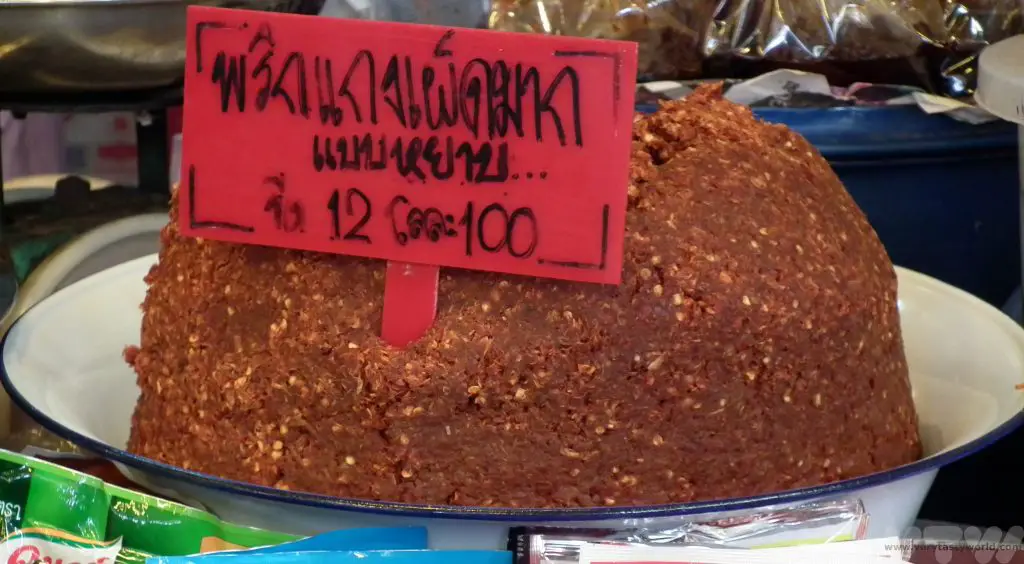
Many supermarkets stock good quality paste these days (as opposed to weaker versions aimed at western markets).
We’ve been using Mae Ploy for years as you can get it in industrial sized tubs which will give you several portions and it lasts for ages (store it in the fridge once opened). Although, to be fair, it doesn’t usually last very long in our household.
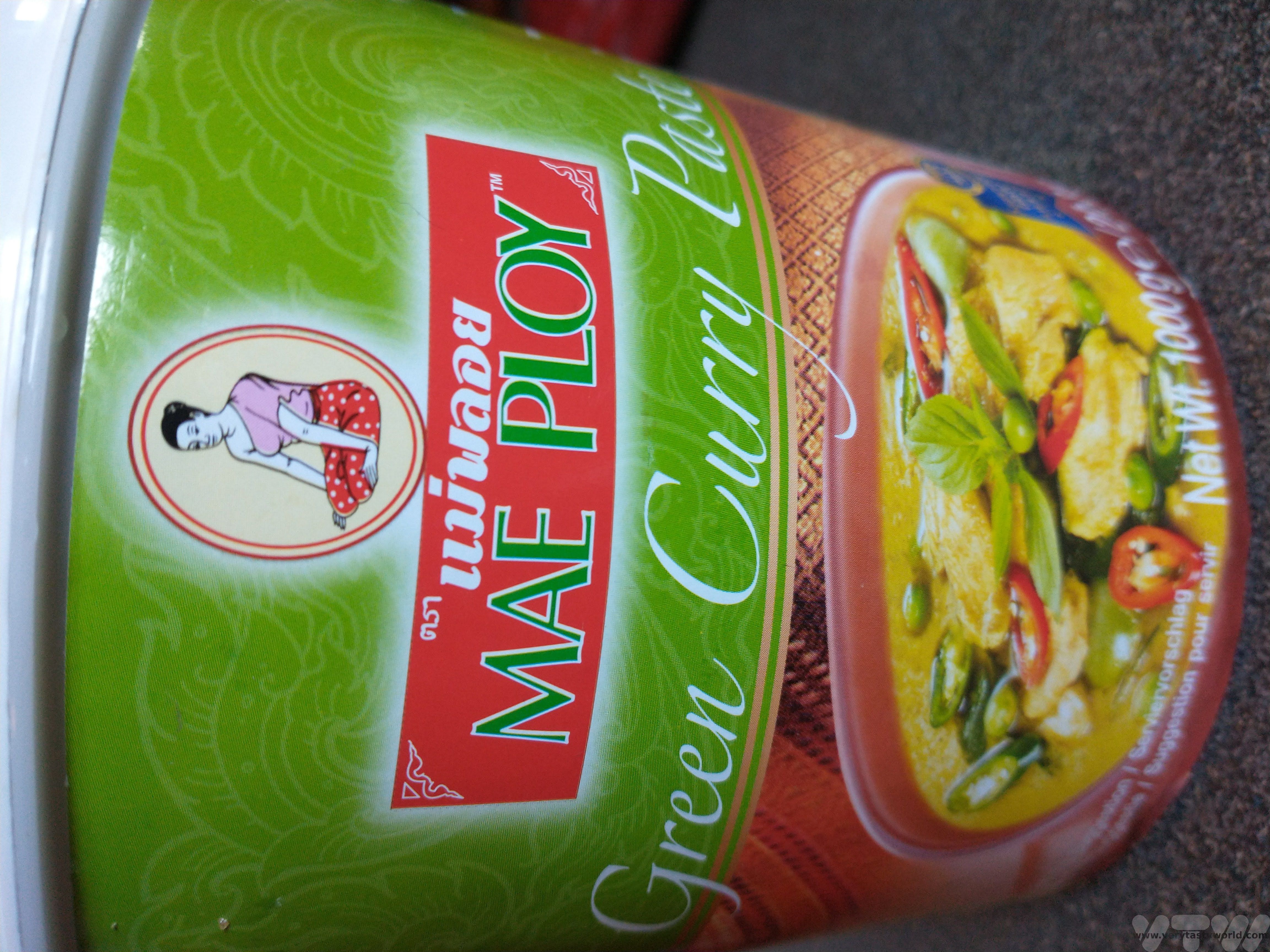
There are approximately three million recipes for Thai curry on the internet. Here’s ours:
How To Make Thai Green Curry
INGREDIENTS
500g chicken thighs, chopped into pieces (thigh meat is definitely recommended over breast meat as it has so much more flavour). Beef and pork also work well with this curry.
Handful of julienned vegetables – e.g. bell peppers, chillies, bamboo shoots, baby aubergine (vegetarians can use these in greater quantities instead of the meat).
A good dollop of green curry paste to suit your preferred level of spicy heat.
1 can of coconut milk.
Splash of fish sauce (probably around a tablespoon).
Bunch of Thai basil (Thai basil is very different to Mediterranean basil), chopped.
A lime.
METHOD
Put a small amount of oil into a pan and add the curry paste. It’s really up to you how much paste to add – if you like more spice, then add more, if you prefer a milder curry, add less. Fry it off to a couple of minutes then add the coconut milk.
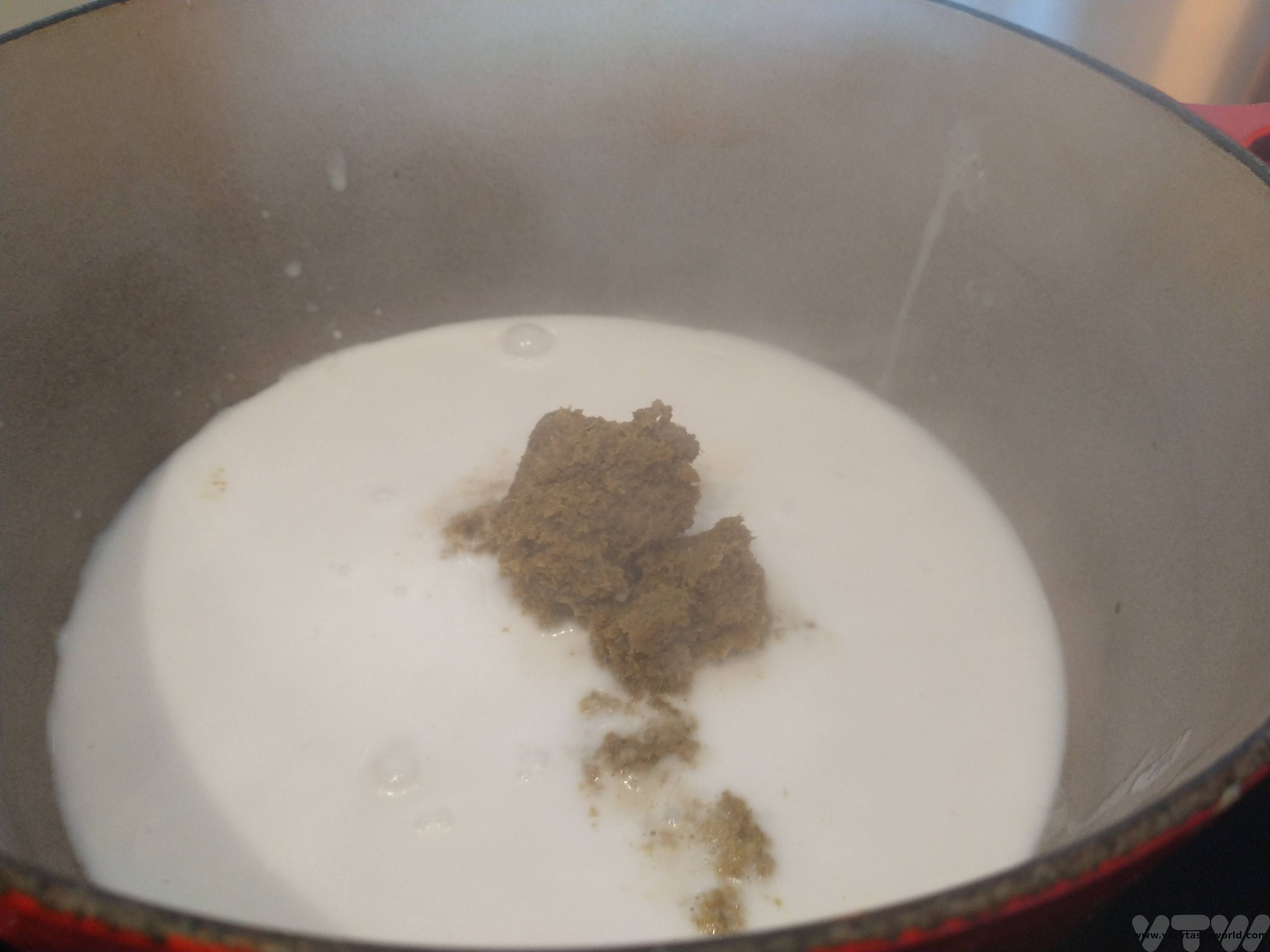
Add the raw chicken and bring to the boil.
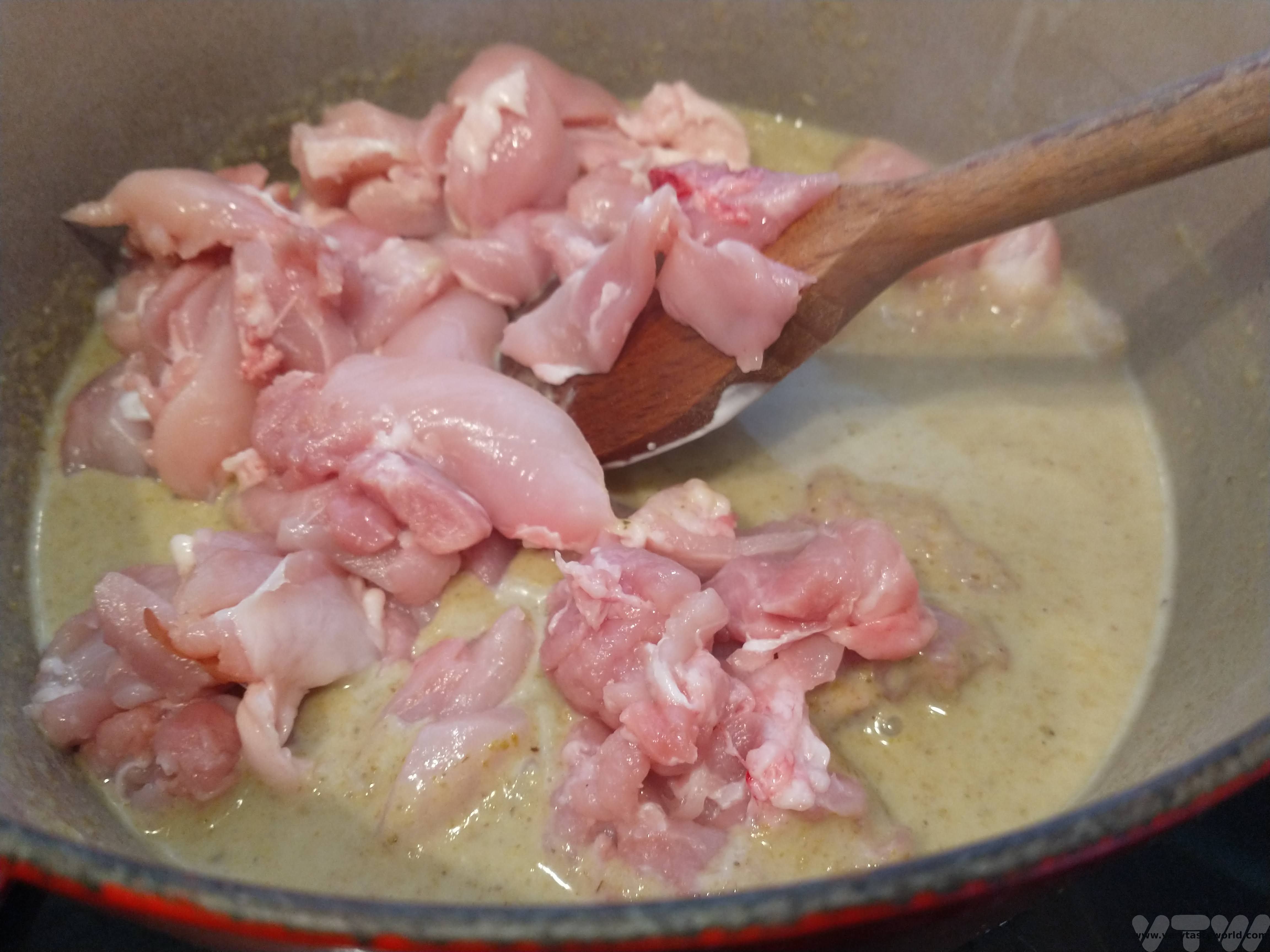
Then turn the heat down and let the chicken simmer for around 15 minutes.
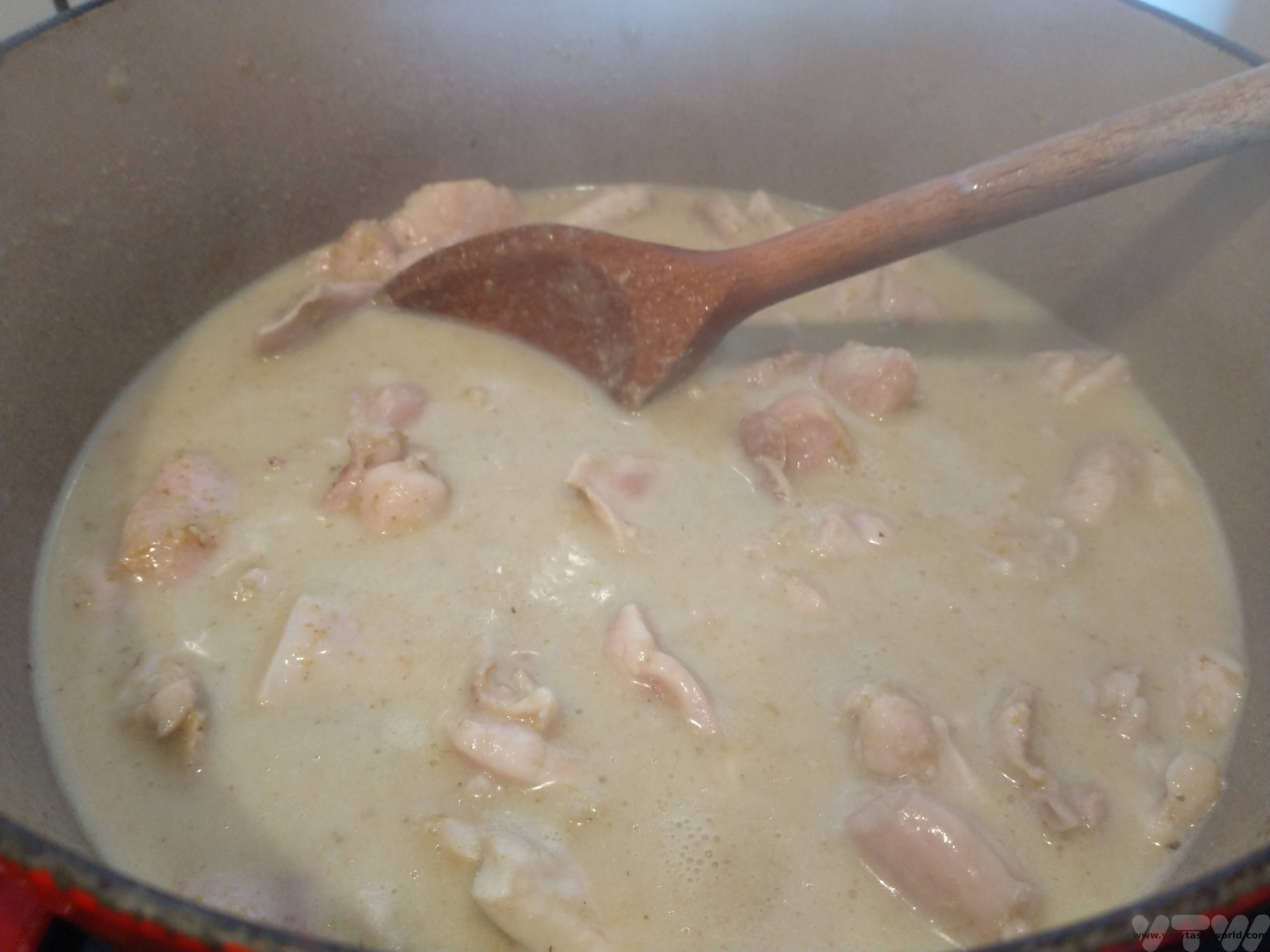
Add the vegetables and allow them to cook. Add the fish sauce and Thai basil. Allow to simmer for a few more minutes.
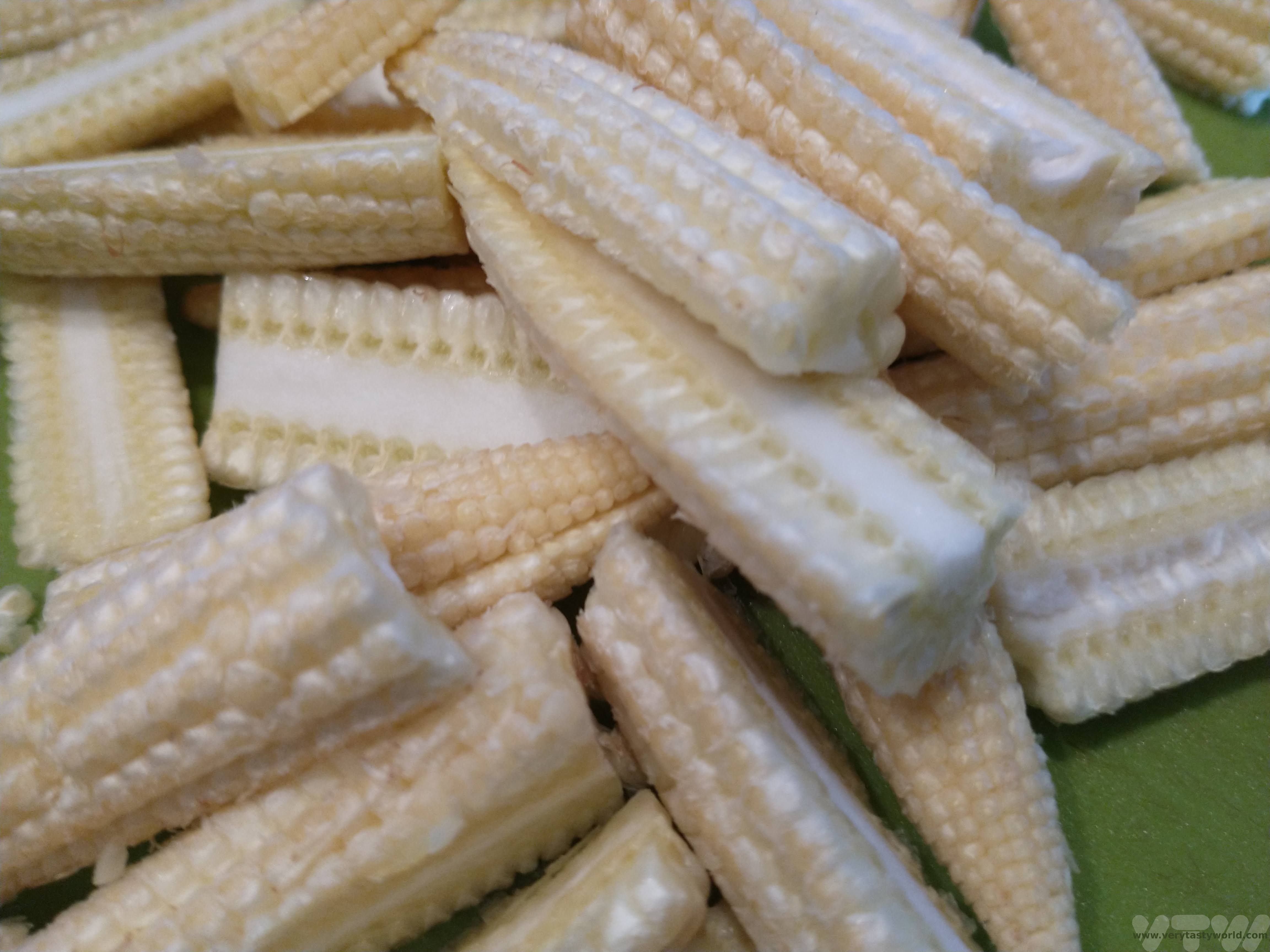
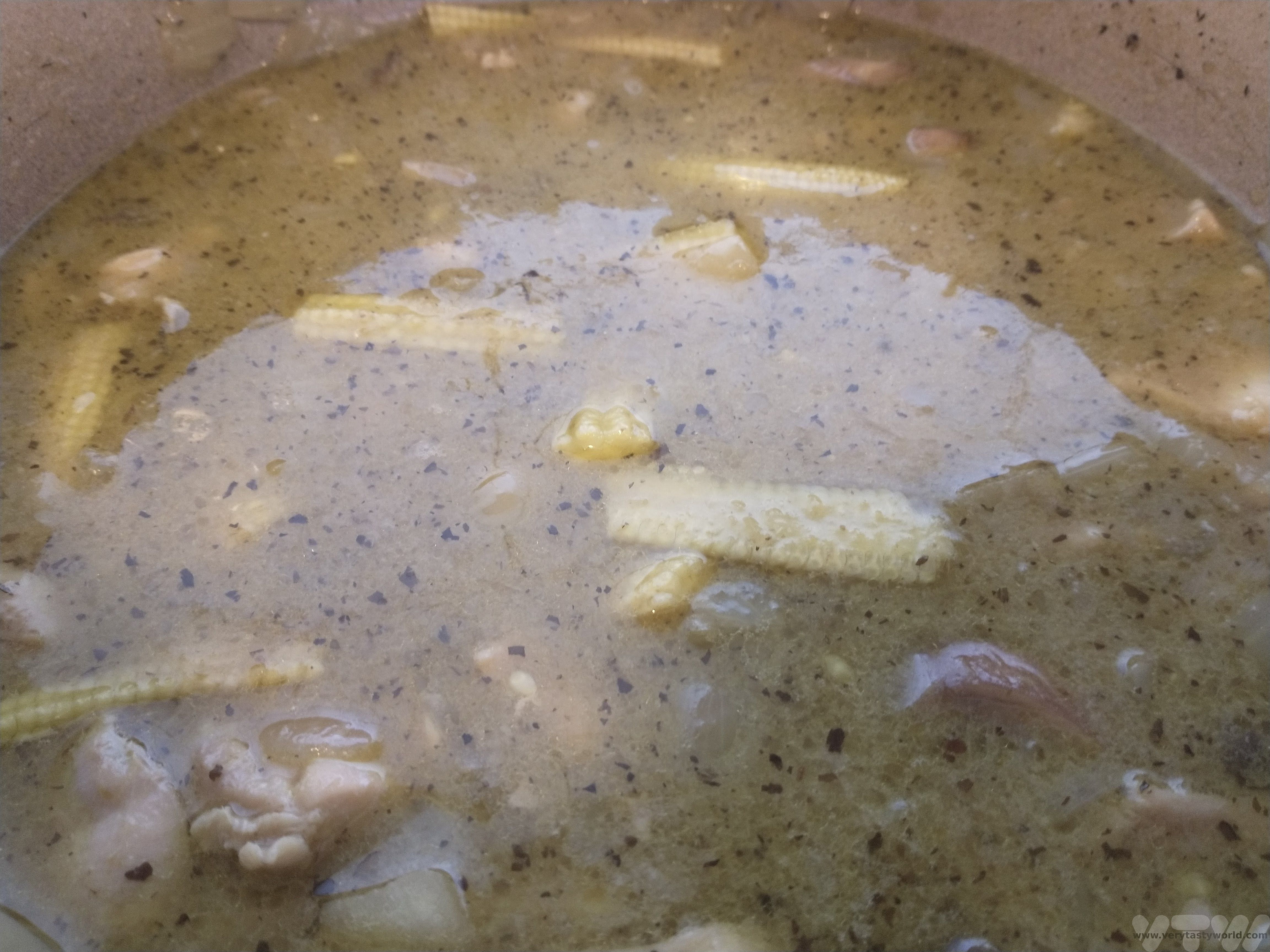
We often add a spritz of lime juice at the end (always at the end) to add some zing.
Serve with jasmine rice.

Scoff. Serves four.
Variations: One of the marvellous things about Thai cuisine is that it has a wonderful combination of sweet, sour, salt and hot flavours. Some Thai green curry recipes incorporate a couple of tablespoons of palm sugar (brown sugar can be substituted if palm sugar isn’t available) to the sauce. If you have a sweet tooth you can add it in as an option, although we don’t as we tend to prefer the sour flavours that the lime offers. This recipe is very flexible in terms of you being able to tailor it to your own palette: the coconut milk gives you sweetness (but you can add sugar if you want more), the curry paste gives heat, the fish sauce provides salt and the lime gives the sour flavours – perfect seasoning.
Related Posts You May Enjoy

RECIPE: How to Make Japanese Dashi stock
Dashi is a Japanese soup stock which is really easy to make and very delicious indeed. It is a fundamental component of many Japanese dishes, such as miso soup, surinagashi and noodle dishes such as ramen and udon. It’s a very simple stock but provides a huge amount of flavour and definitely puts the “mmm” into umami, the fifth flavour. You can buy instant powdered dashi and just add water but if you can find the ingredients in your local Asian supermarket it’s really not much effort to make. The process is very simple and much quicker than traditional stock making in European cuisines, which generally require ingredients such as meat, vegetables and herbs to be boiled for several hours. Here is our Japanese dashi stock recipe
Japanese Dashi Stock Recipe
Dashi usually only uses a couple of ingredients. The dashi we made used konbu (kelp – a seaweed) and katsuobushi (bonito flakes, which are skipjack tuna flakes that have been simmered and smoked, then dried in the sun to ferment and finally shaved to wafer thin slices). Katsuobushi, like many fermented fish products (think nam pla – fish sauce from Thailand), smells somewhat stinky and not very pleasant when you open the packet, but somehow it adds a magical quality to the finished stock. Other dashi ingredients could include dried shiitake mushrooms or dried anchovies.
Ingredients
3 sheets of kombu kelp seaweed
EITHER
40g bonito flakes
OR
5 dehydrated shiitake mushrooms (for vegetarian or vegan version)
1 litre of water
Method
Make the dashi: Put kombu and bonito flakes (or shiitake mushrooms) into a saucepan of water.
Bring to a simmer. Skim off any froth.
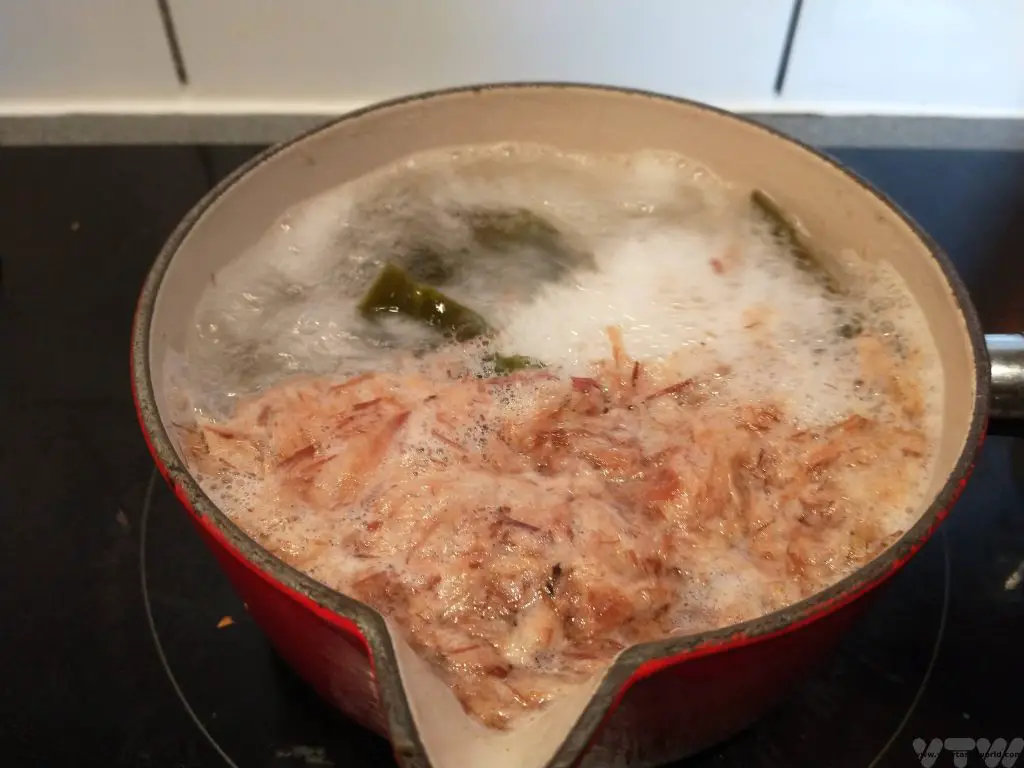
After 15 minutes, turn off the heat. You should have a clear broth
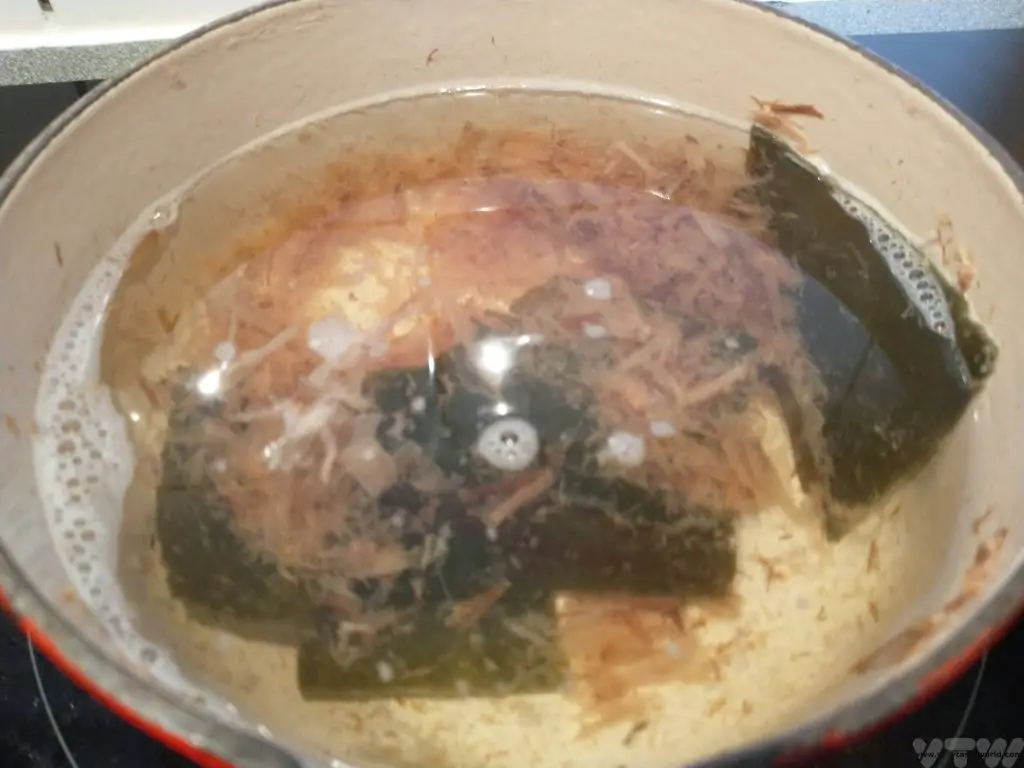
Sieve the solids from the broth.
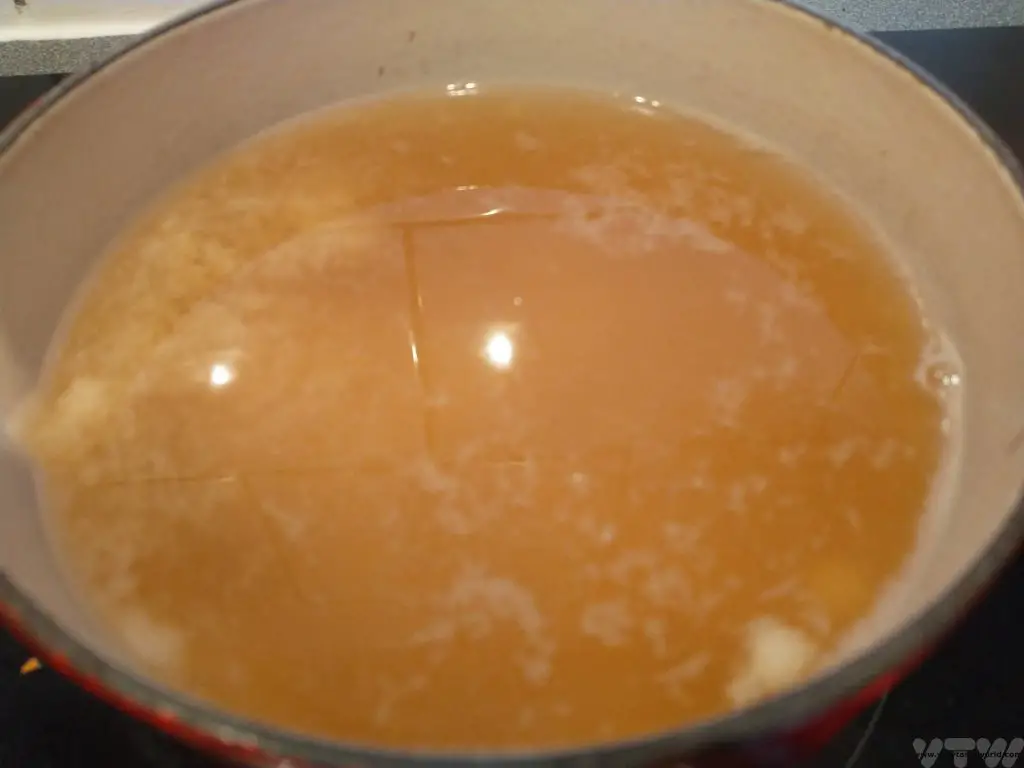
Keep the solid ingredients. You can dry these out and use them again to make a secondary dashi.
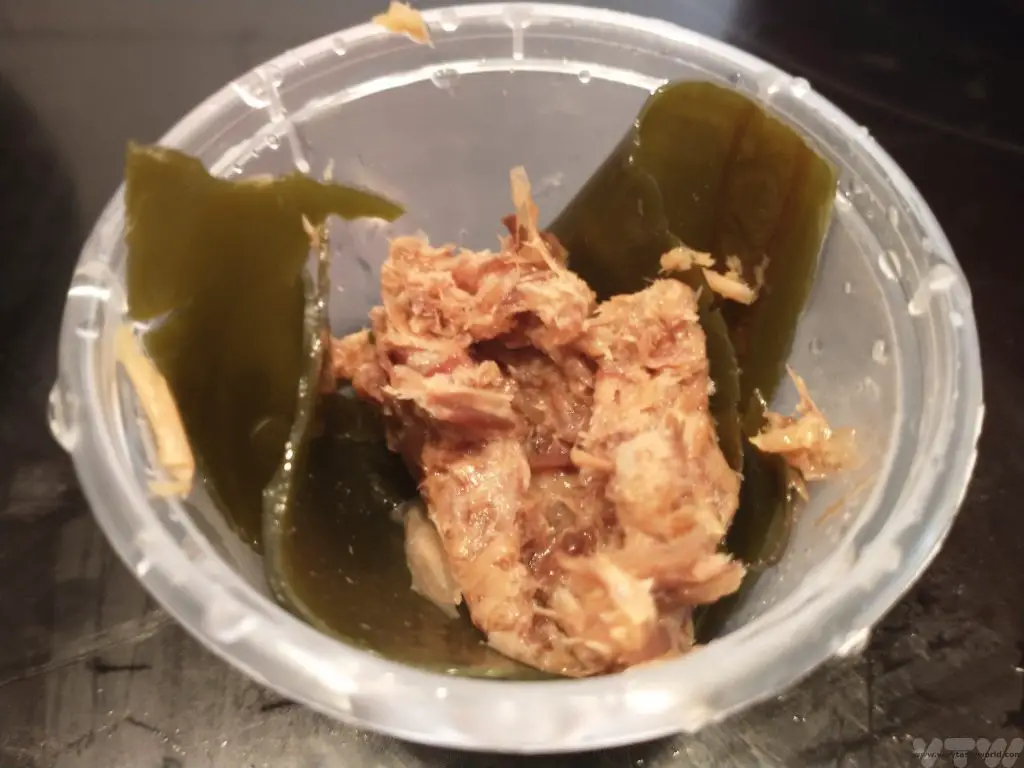
This Japanese dashi stock recipe is so easy to make and can be used in many delicious dishes.
Related Posts You May Enjoy
Please note that this post contains affiliate links. If you click the link and decide to make a purchase we will earn a small commission, at no cost to you, which helps towards running this site.

- RECIPE Oyakodon Donburi
- Zero Waste Recipes Before Your Holiday
- RECIPE: Vegetable Biryani Tamil Nadu Style
- RECIPE: Vegan Wild Garlic Pesto
- Recipe: Venetian Pasta Sauce
- RECIPE: Biryani Raita Recipe
- RECIPE: How to Make Costa Rica’s Gallo Pinto
- Recipe: Japanese Simmered Pork Belly – Buta no Kakuni
- RECIPE: How to Make Umeboshi
RECIPE: How To Make Lao Larb
Lao larb, also known as moo larb, is the perfect dish for a hot summer’s day. It’s incredibly easy to make and really refreshing. It’s kind of a meat salad which hails from South East Asia; we first tried it in Lao , where it holds the status of national dish, but we have also eaten it in Thailand, and quickly became hooked. Even better, all the ingredients are really easy to find in our home country. There’s a tiny bit of preparation needed prior to assembling the dish, so worth thinking about making it ahead of time. The following recipe will feed four as a starter or two hungry people.
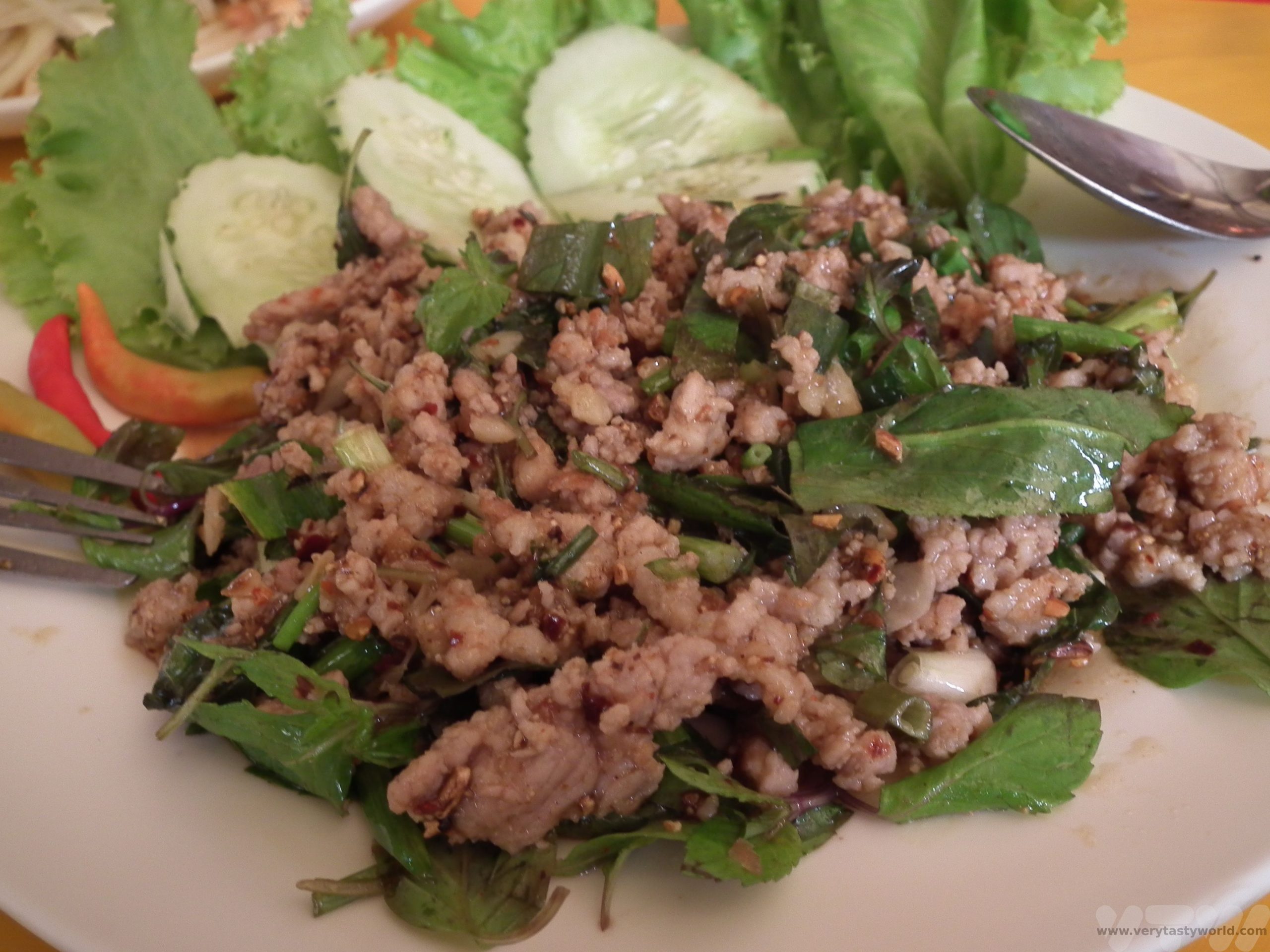
INGREDIENTS
300g pork mince. (The ‘moo’ of moo larb is pork.) Chicken mince also works really well and quorn mince or mushrooms can provides a vegetarian alternative. Lamb isn’t recommended as it’s quite fatty and the fat tends to congeal a little when it cools, which doesn’t provide a very nice texture.
1 large red onion (or 2 small)
Generous handful of fresh mint
Generous handful of fresh coriander
Freshly milled black pepper
1 or 2 juicy limes
Generous splash of fish sauce (vegetarians can use veggie fish sauce or a combination of soy sauce with a dash of vinegar) – around half a tablespoon
Optional: chilli flakes, toasted rice, teaspoon of sugar, Thai basil leaves for garnish
METHOD
You need to allow enough time for the mince to cook and cool before assembling the dish. It’s the perfect ‘make in advance’ dish.
Cook the mince. Pour a little oil into a pan and fry until the meat is cooked through. Allow it to cool.
Finely chop the onion, coriander and mint and add to the mince.
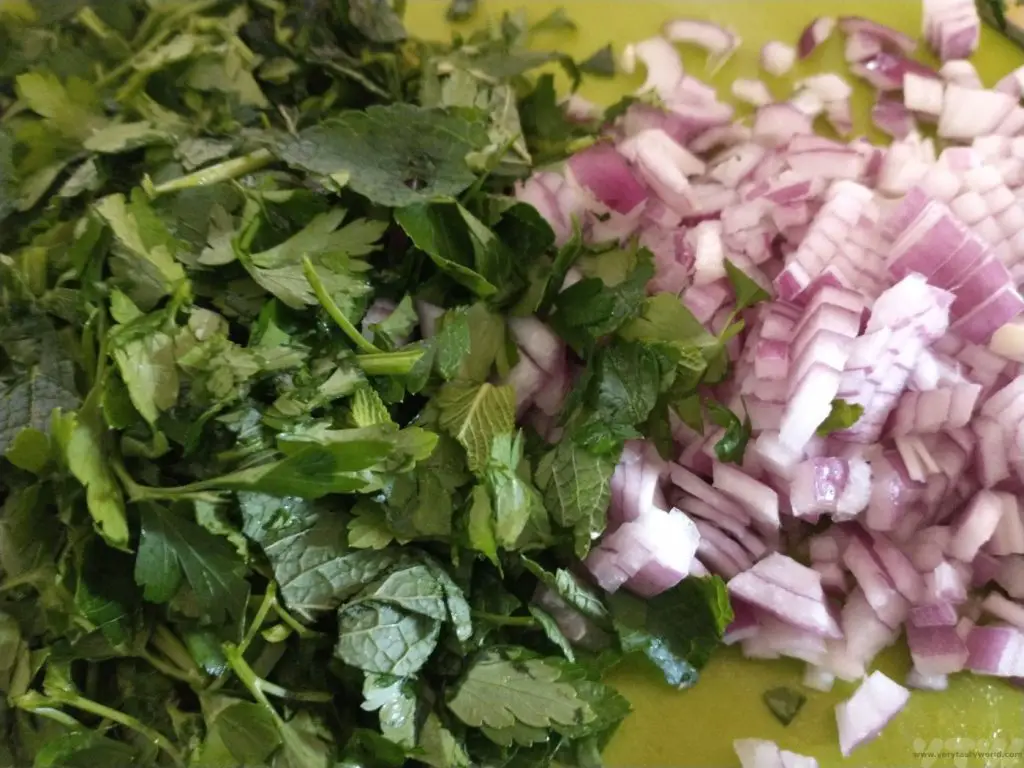
Add the fish sauce, lime juice and black pepper to taste. We really like coarsely ground black pepper so grind ours in a pestle and mortar. This is really where you can adapt the flavour to your personal taste.
Mix well. It’s fine to make in advance and let the flavours infuse.
Serve with steamed rice and a salad garnish.
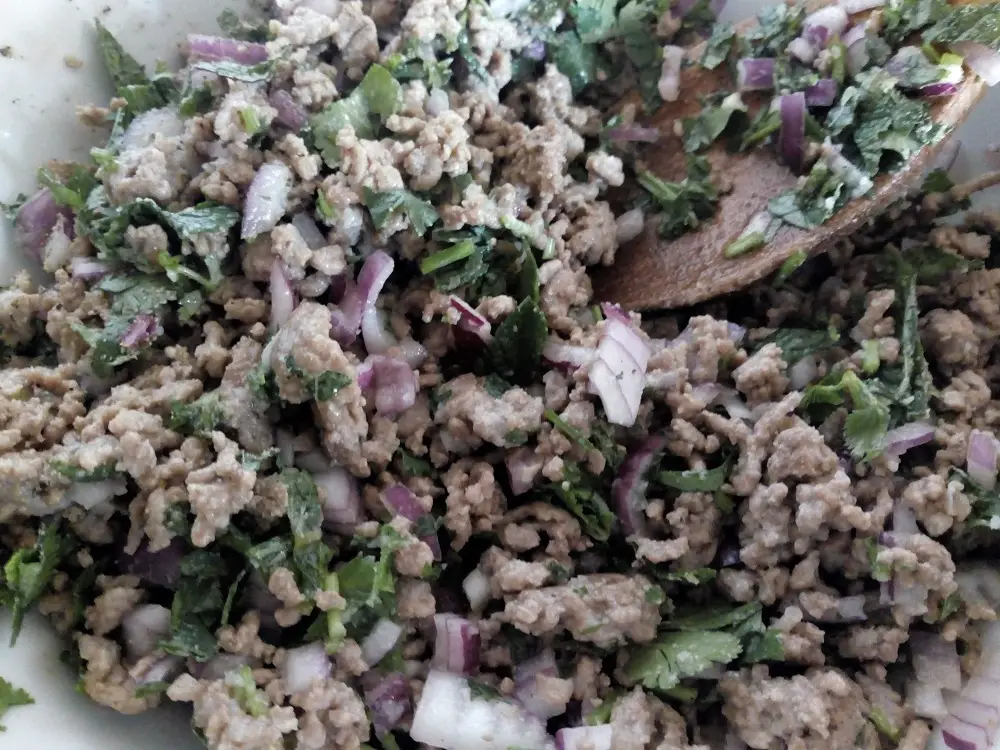
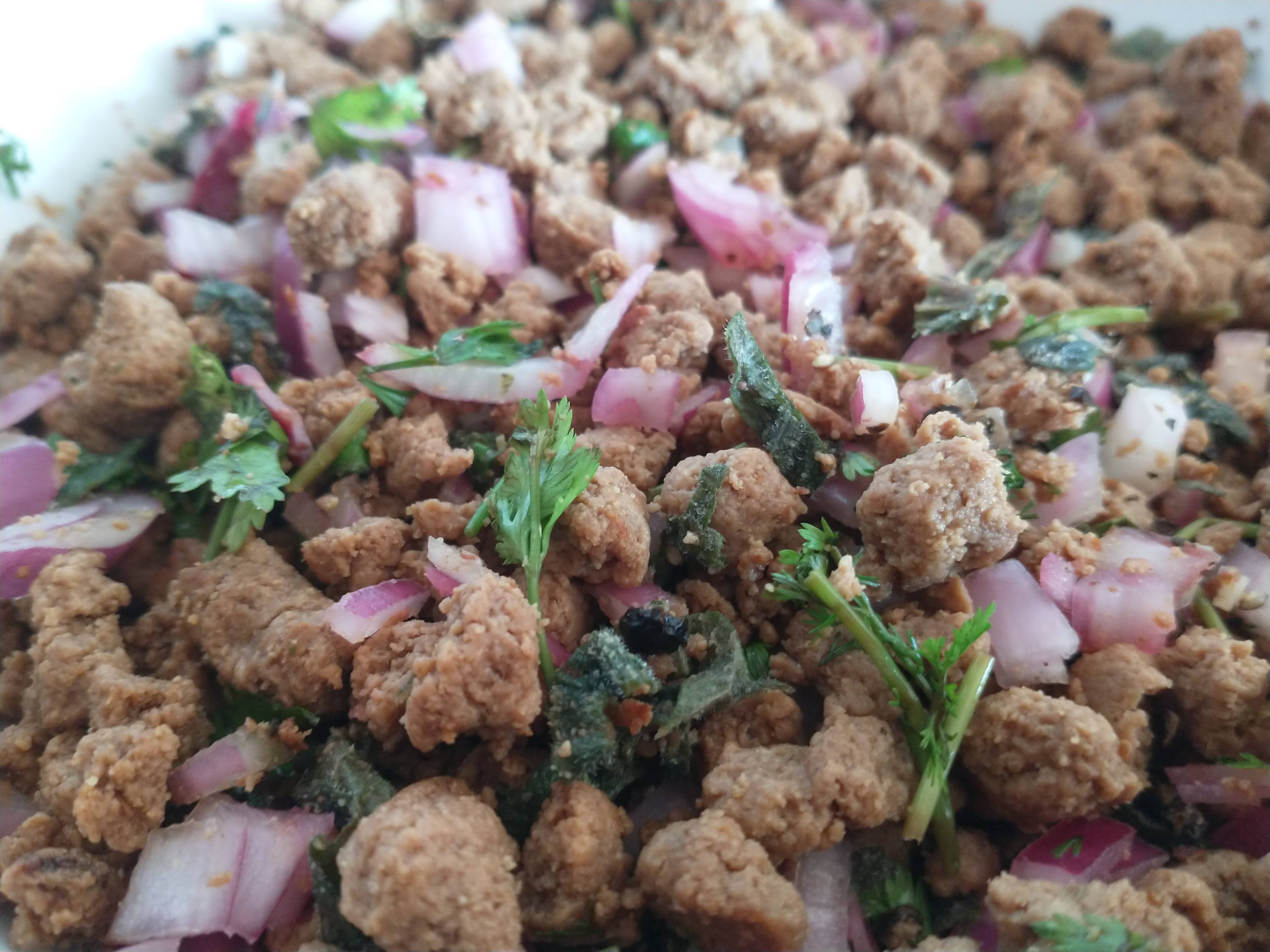
VARIATIONS
One of the lovely things about this dish is that you really can adjust it to your taste. There are some variations. If you like heat, add chilli flakes (flakes are better than fresh chilli). This was one of the dishes we tasted in Lao that wasn’t searingly hot, the spice coming from the pepper rather than chilli, but it’s fine to add more heat if you like it. If you’d like to add some sweetness, sprinkle in a little sugar and mix in.
There is also an important and popular variation where you can add roasted ground rice powder for an additional nutty complexity to the flavour and texture. It’s very simple: place a handful of uncooked Thai rice in a dry frying pan and roast the rice for 10 minutes or so, moving about in the pan until the rice is brown. Then transfer to a pestle and mortar or a spice grinder and grind to a powder.
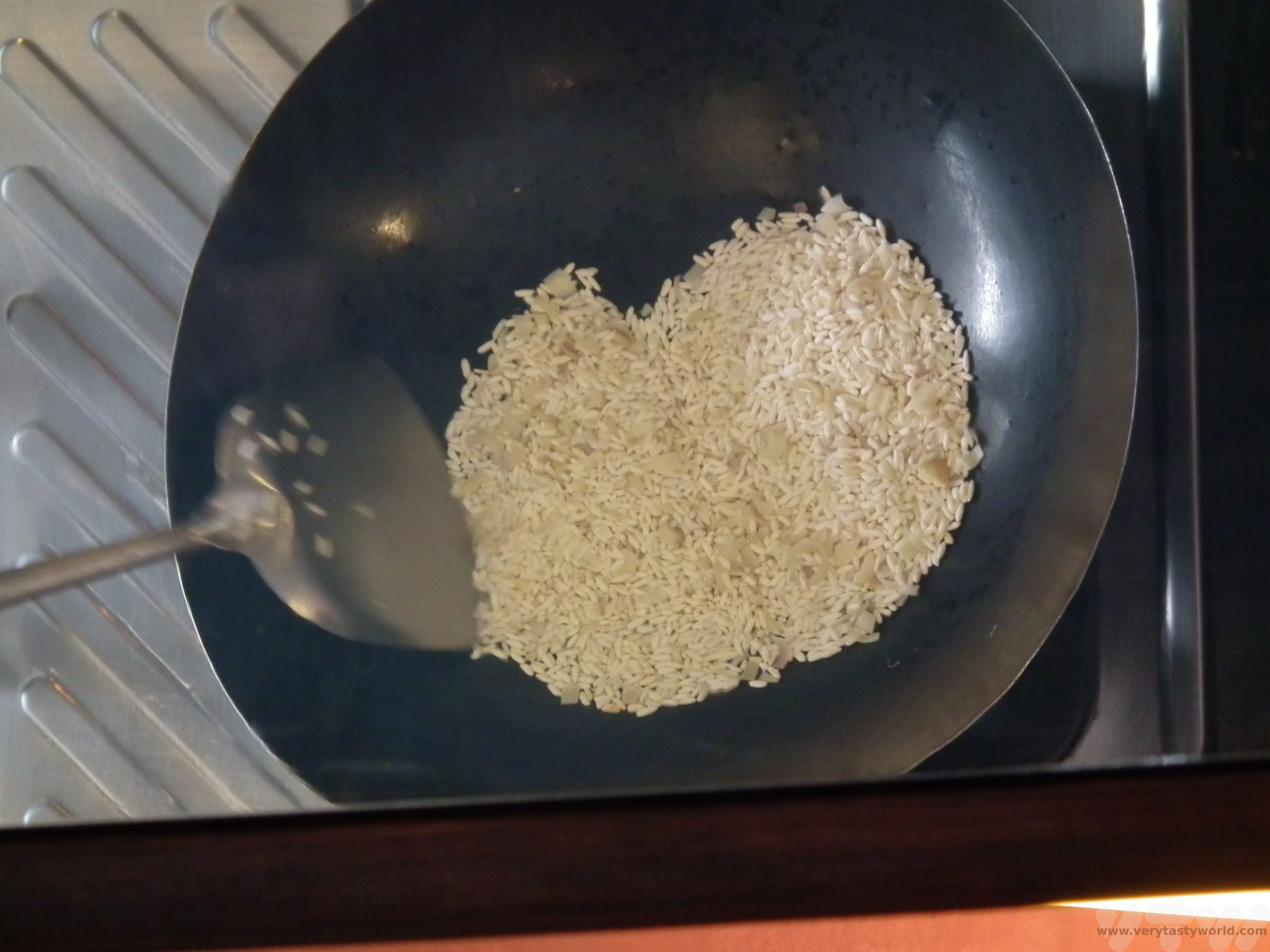
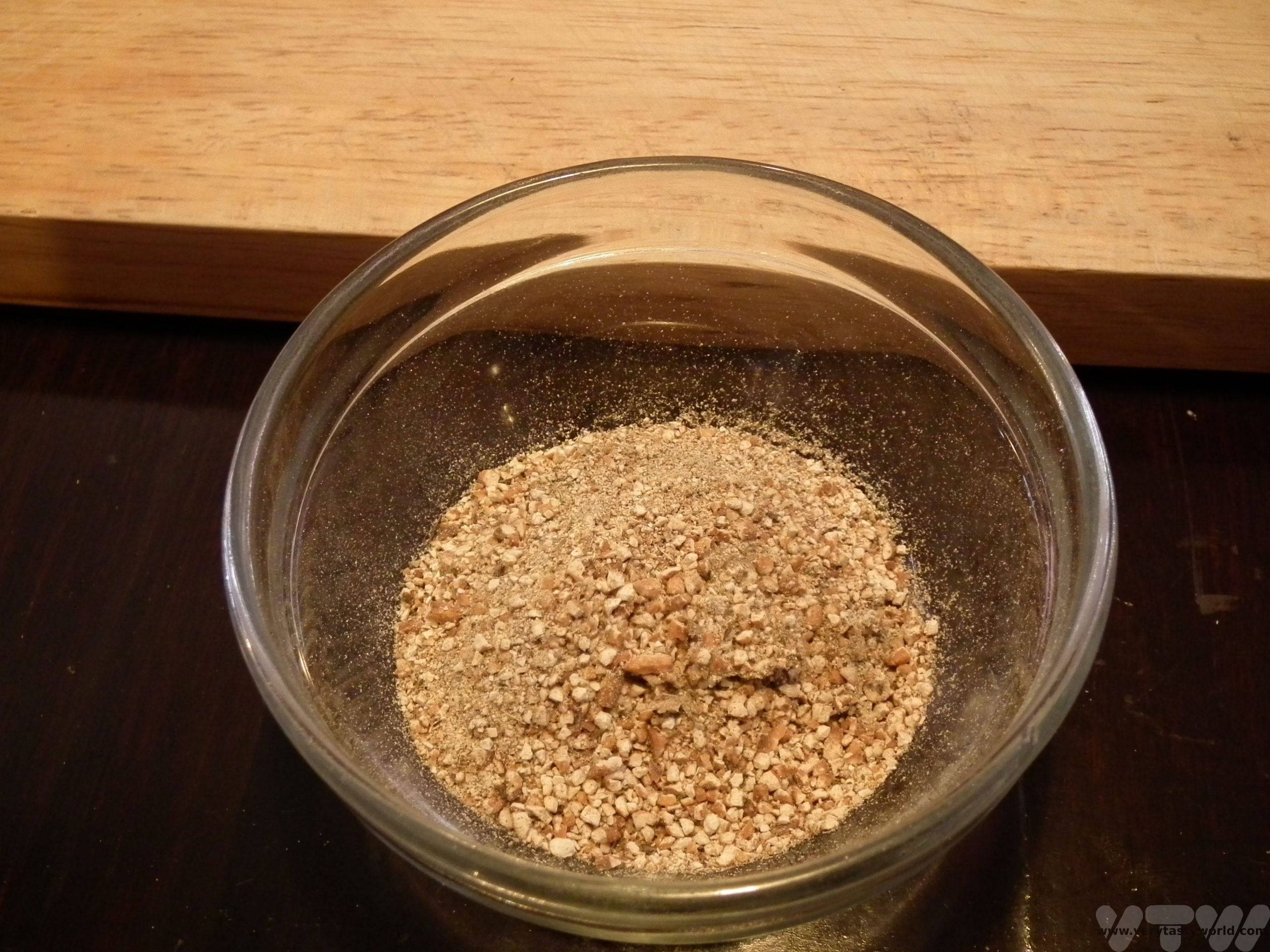
(You can actually toast more rice to make a greater quantity of this powder; it will keep for a couple of months in an airtight container.)

- RECIPE Oyakodon Donburi
- Zero Waste Recipes Before Your Holiday
- RECIPE: Vegetable Biryani Tamil Nadu Style
- RECIPE: Vegan Wild Garlic Pesto
- Recipe: Venetian Pasta Sauce
- RECIPE: Biryani Raita Recipe
- RECIPE: How to Make Costa Rica’s Gallo Pinto
- Recipe: Japanese Simmered Pork Belly – Buta no Kakuni
- RECIPE: How to Make Umeboshi
Recipe: Miso Soup
Miso soup is a traditional Japanese broth made with miso (fermented soy bean paste), dashi (a simple but delicious stock) and a variety of other ingredients of your choice. It’s the perfect accompaniment to so many Japanese dishes. Here’s our miso soup recipe.
Ingredients
3 sheets of kelp seaweed (kombu)
1 packet of bonito flakes (40g)
1 litre water
1 tbs miso paste (home made or shop-bought)
Optional:
spring onions
block of silken tofu
wakame seaweed
enoki mushrooms
Method
It should be possible to buy kombu (kelp) and bonito flakes from Asian supermarkets. The dashi really adds to the deliciousness of the soup but if you can’t get hold of the ingredients, you can make a vegetable/fish stock and skip to the step where you add the miso paste.
Make the dashi: Put kombu and bonito flakes into a saucepan of water.
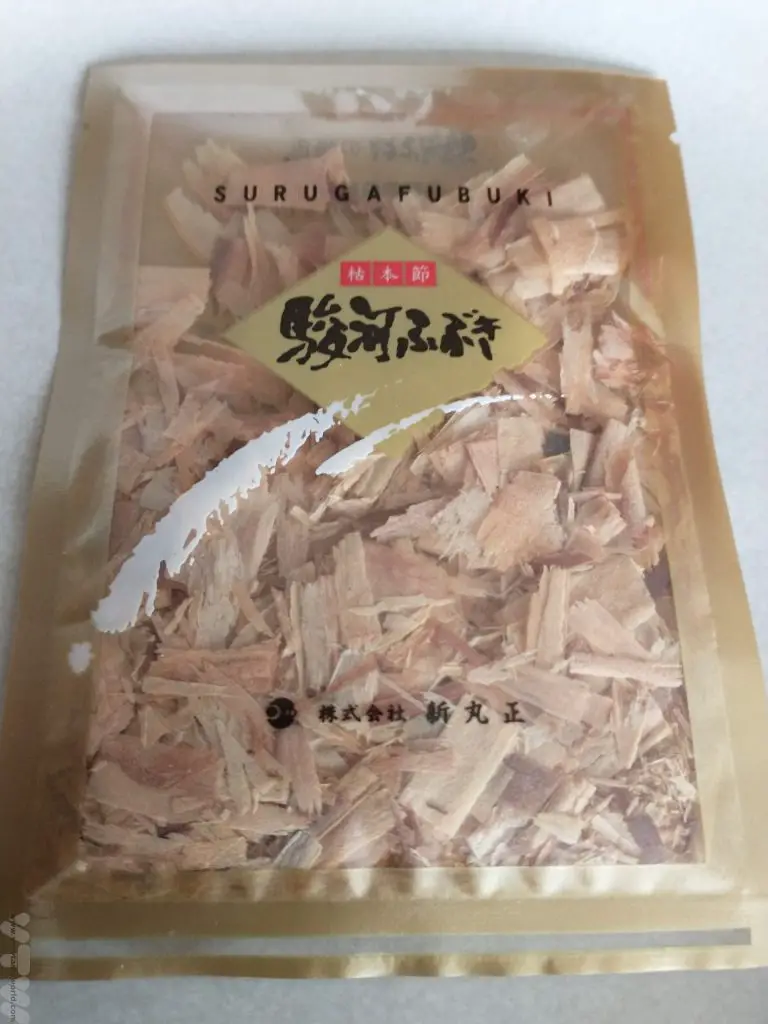
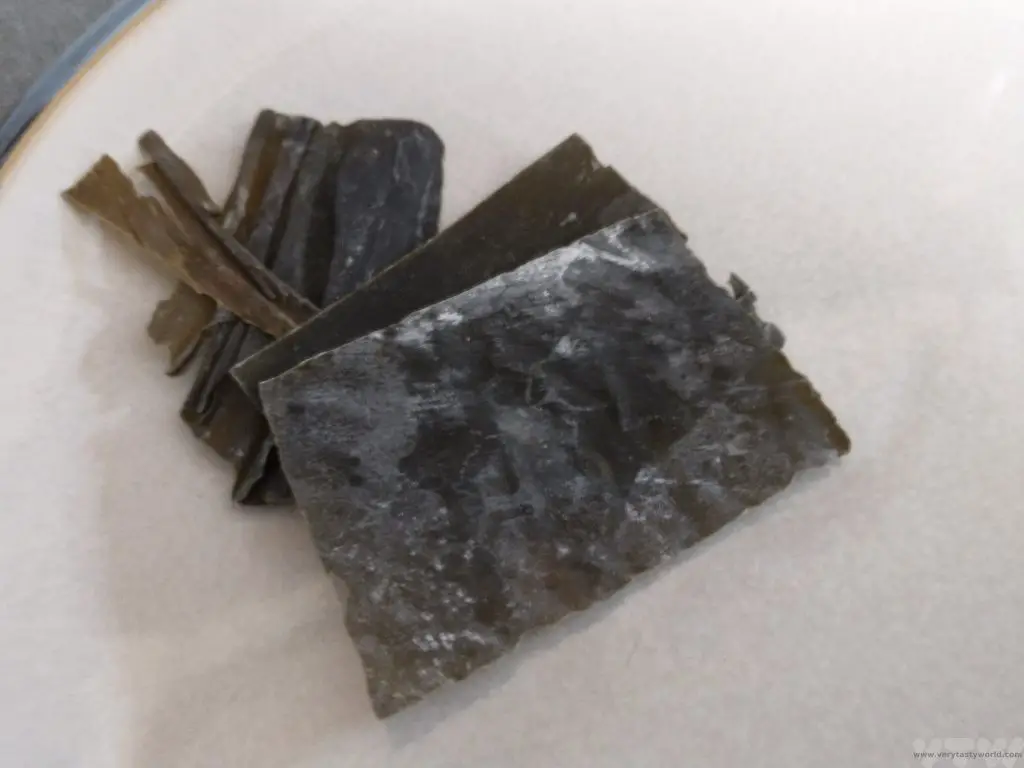
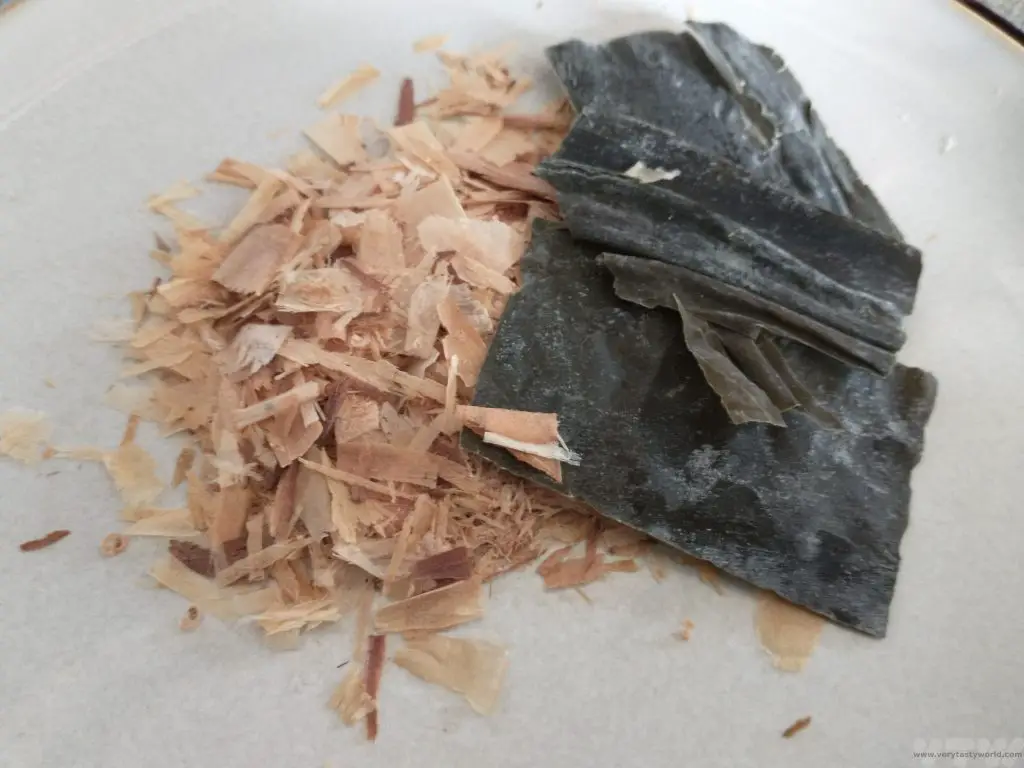
Bring to a simmer. Skim off any froth.

After 20 minutes, you should have a clear broth

Sieve the solids from the broth. Keep the solid ingredients. You can dry these out and use them again to make a secondary dashi.


Add the miso paste to the dashi in the saucepan. You can buy miso in most supermarkets but you can also make your own. Warm through gently.
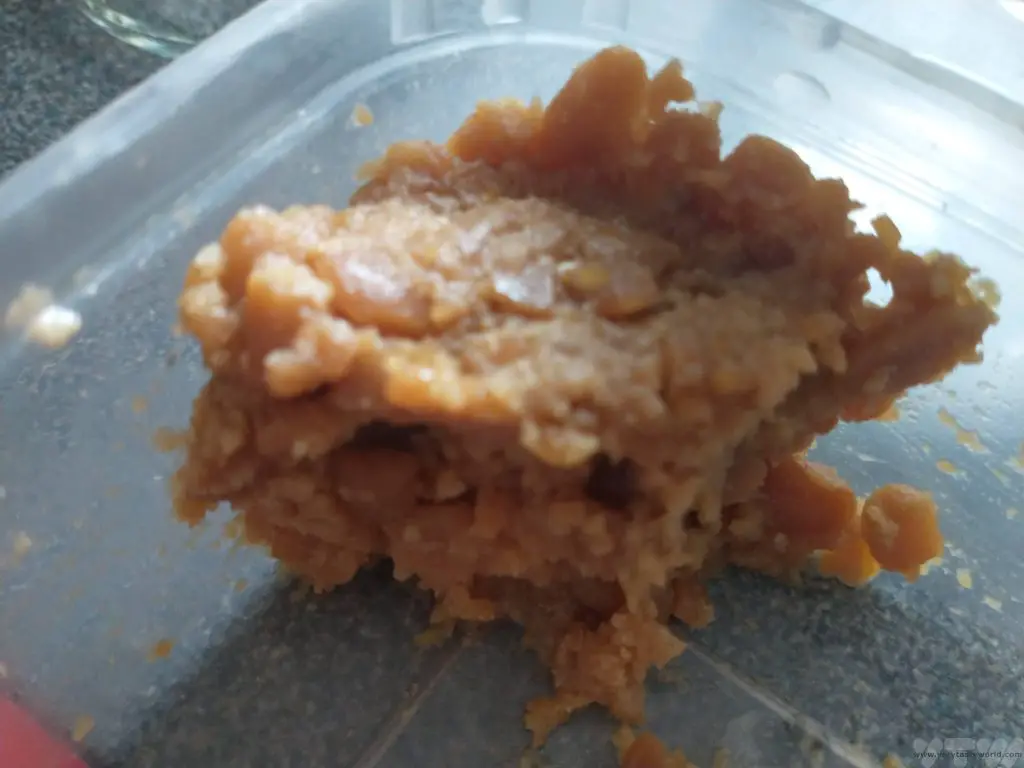
This is the soup base. In this miso soup recipe there are a number of ways to embellish the finished soup. Optional ingredients include such delights as negi (Japanese onions, they are a cross in size between a spring onion and a leek – UK spring onion will be perfect), silken tofu cut into very small cubes, wakame seaweed (a type of kelp that you can buy dehydrated from Asian supermarkets) or small mushrooms (enoki style – the teeny bunches of mushrooms are perfect, but finely chopped ordinary mushrooms will work well).
In this instance we had some spring onions to hand. So they were finely sliced and placed in a serving bowl.
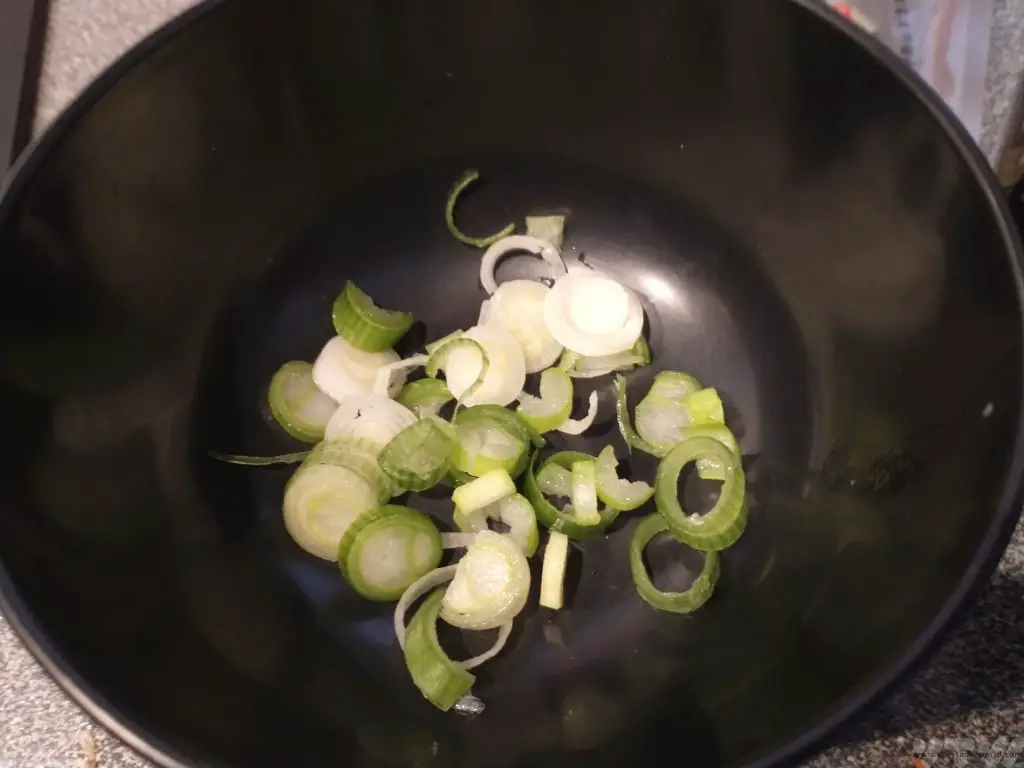
Pour the miso broth on top. Enjoy while hot.
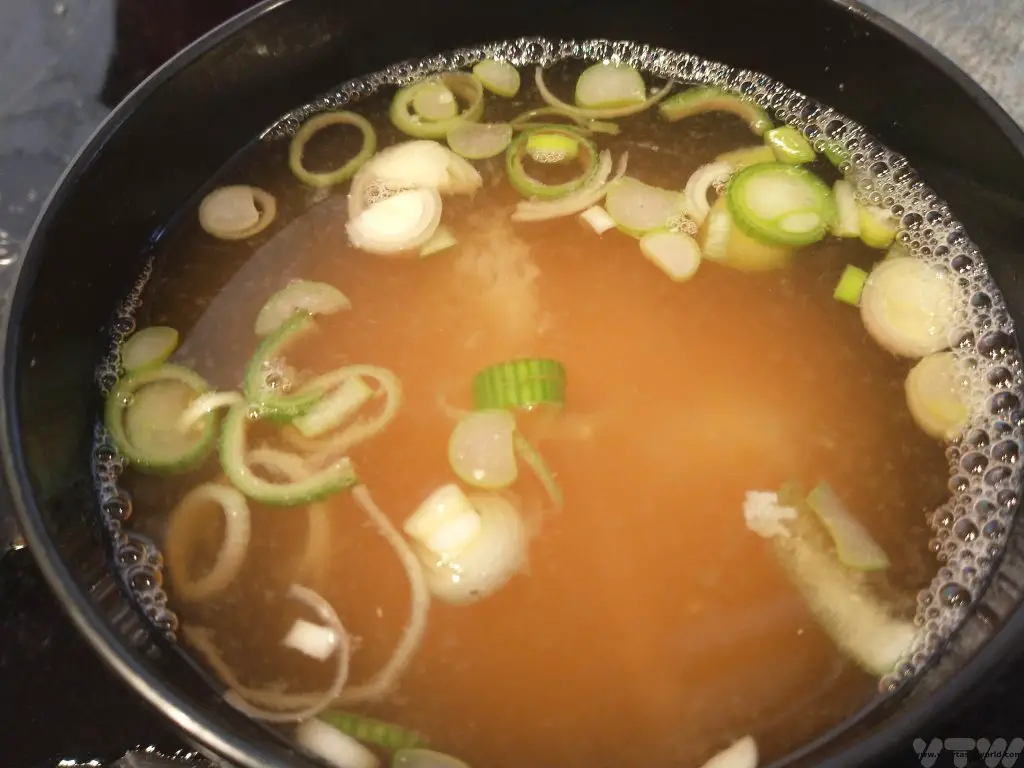
It is absolutely fine to drink the miso soup using a spoon or to drink directly from the bowl. In Japan, it’s also okay to slurp – this helps cool the hot liquid as you drink it. Make sure you stir it (you can use chopsticks to do this) before consuming so that the ingredients that settle at the bottom are agitated – the miso never dissolves completely into the broth – and produce an even flavour throughout the drinking.
Related Posts You May Enjoy

- RECIPE Oyakodon Donburi
- Zero Waste Recipes Before Your Holiday
- RECIPE: Vegetable Biryani Tamil Nadu Style
- RECIPE: Vegan Wild Garlic Pesto
- Recipe: Venetian Pasta Sauce
- RECIPE: Biryani Raita Recipe
- RECIPE: How to Make Costa Rica’s Gallo Pinto
- Recipe: Japanese Simmered Pork Belly – Buta no Kakuni
- RECIPE: How to Make Umeboshi
RECIPE: Baked Sea Bass in Parchment
with Ginger, Garlic and Spring Onion
A whole fish baked with ginger, garlic and spring onion is one of the traditional dishes associated with lunar new year in many countries in South East Asia. The reason that the fish is served whole is because the head and tail represent the start and end of the year.
We have a recipe for baked sea bass in parchment. It uses typical ingredients in Chinese cookery – the aromatic flavours of ginger, garlic and spring onion. Some methods steam the fish, other oven-bake. This recipe is very simple

1 whole sea bass, scaled and gutted
5 cm ginger
5 spring onions
3 cloves of garlic
1 chilli for garnish
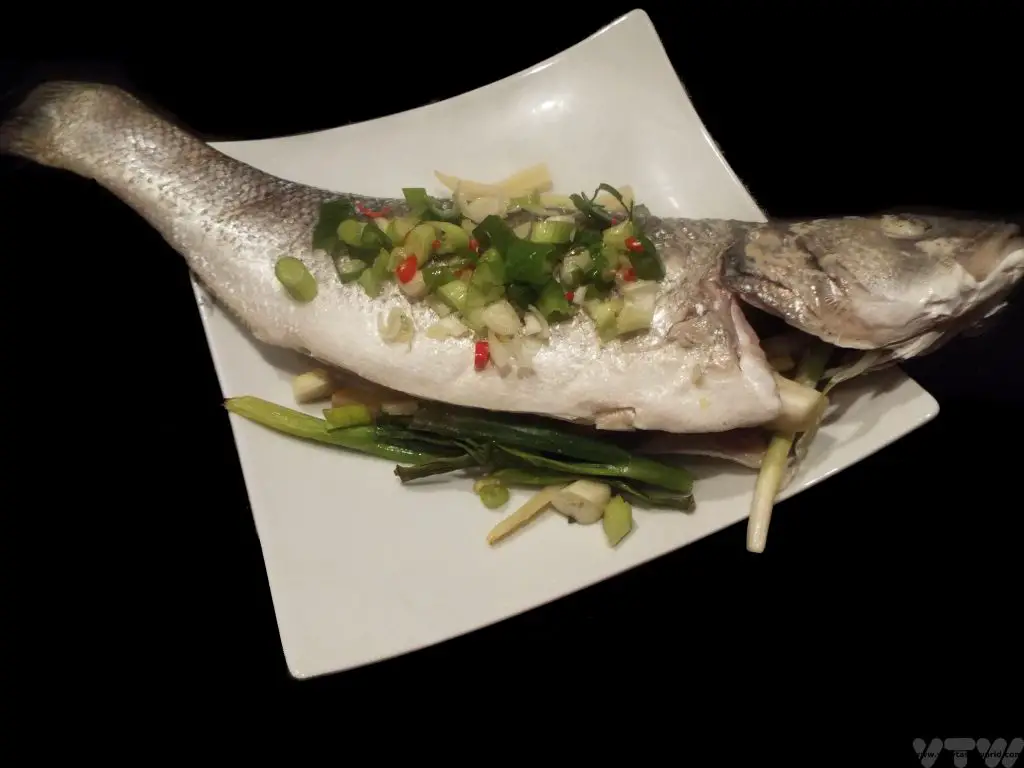
METHOD
Turn on the oven to 200C, 180C fan, or gas mark 6.
Slice the ginger (you don’t have to worry about peeling the ginger) and four of the spring onions into julienned strips, roughly chop the garlic. Open the cavity of the sea bass and stuff the ingredients inside.
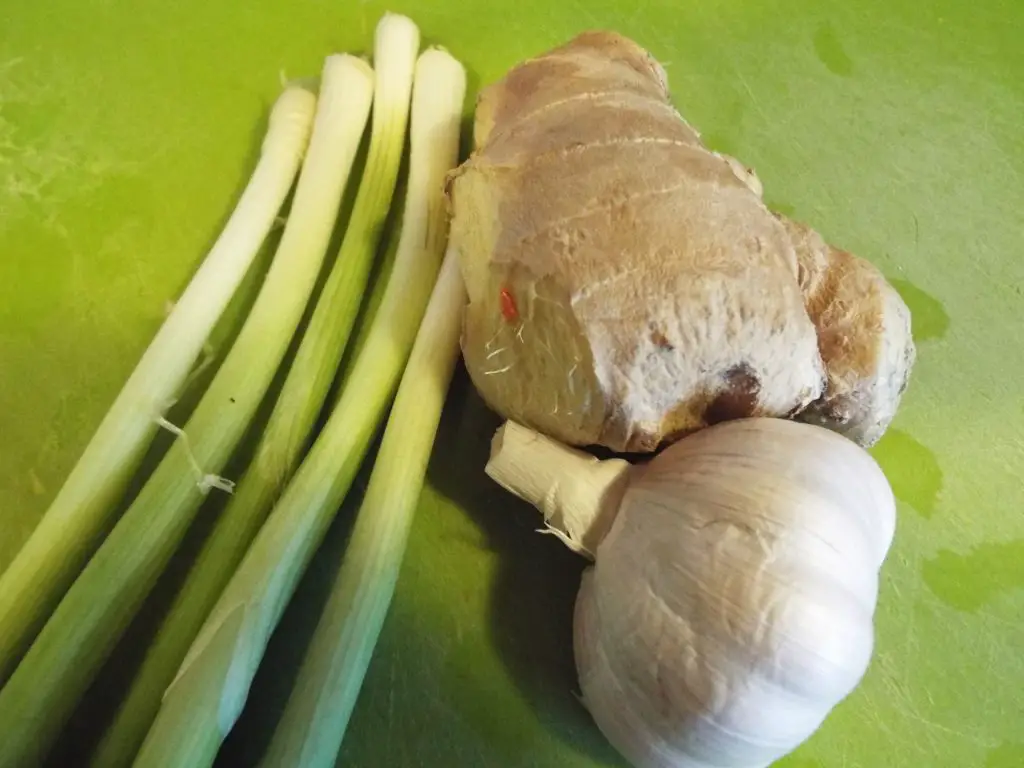
Place the whole sea bass onto a sheet of baking parchment.
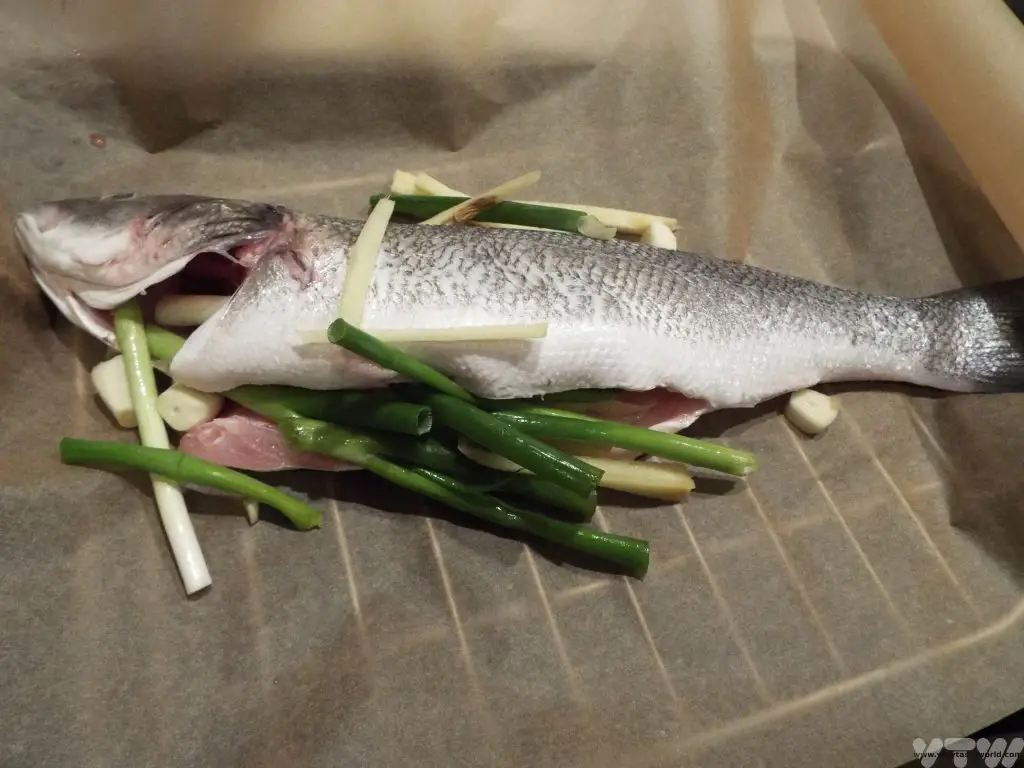
Bring the sides of the paper over the fish and make a loose fold. It doesn’t need to be tightly sealed – enough to let steam escape but not so loose that the lovely juices from the fish don’t get lost.
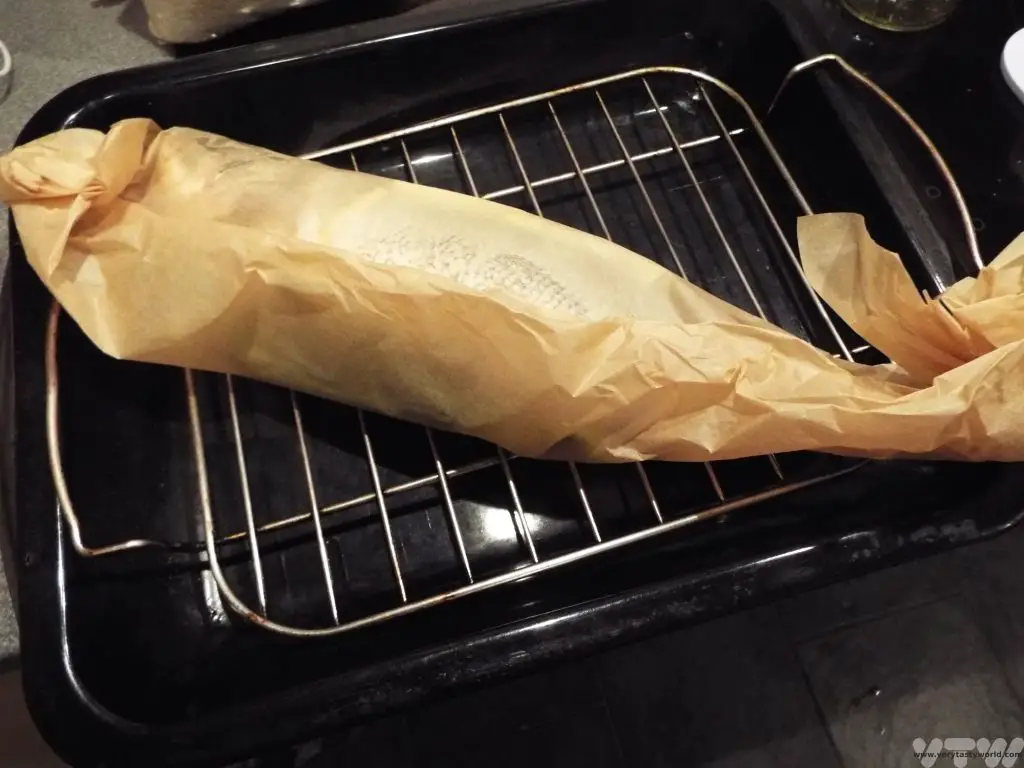
Bung into the oven and cook for 25 minutes.
When the sea bass is cooked, open up the paper parchment – the smell is amazing!
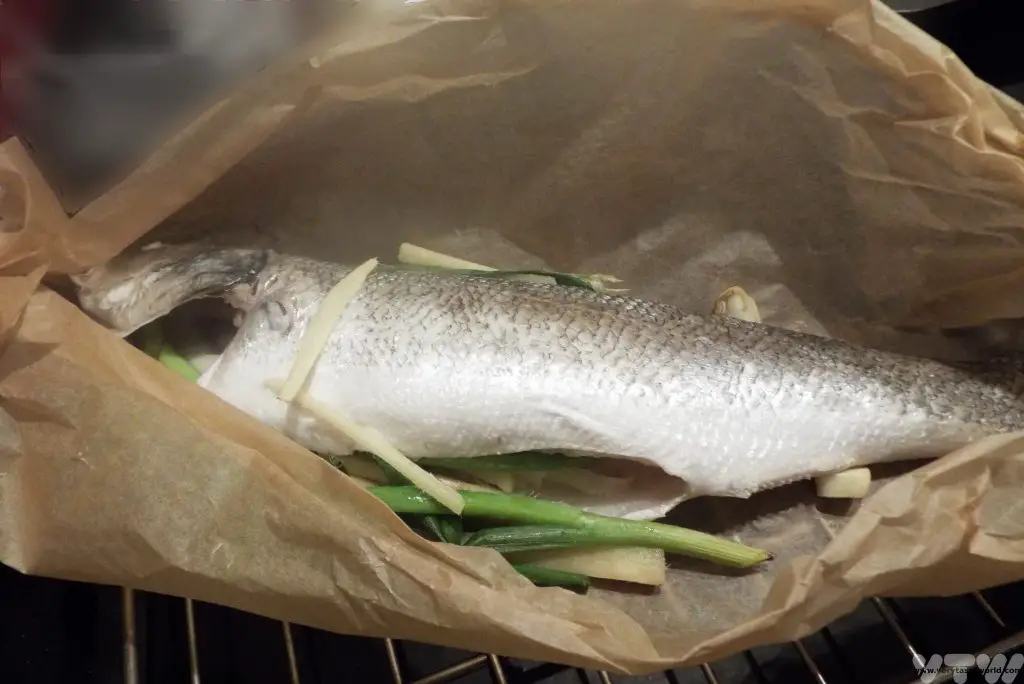
Then garnish with the remaining chopped spring onion and some finely sliced chilli. When celebrating Chinese Spring Festival at New Year, the fish is served whole to the table as a sharing dish.


- RECIPE Oyakodon Donburi
- Zero Waste Recipes Before Your Holiday
- RECIPE: Vegetable Biryani Tamil Nadu Style
- RECIPE: Vegan Wild Garlic Pesto
- Recipe: Venetian Pasta Sauce
- RECIPE: Biryani Raita Recipe
- RECIPE: How to Make Costa Rica’s Gallo Pinto
- Recipe: Japanese Simmered Pork Belly – Buta no Kakuni
- RECIPE: How to Make Umeboshi

